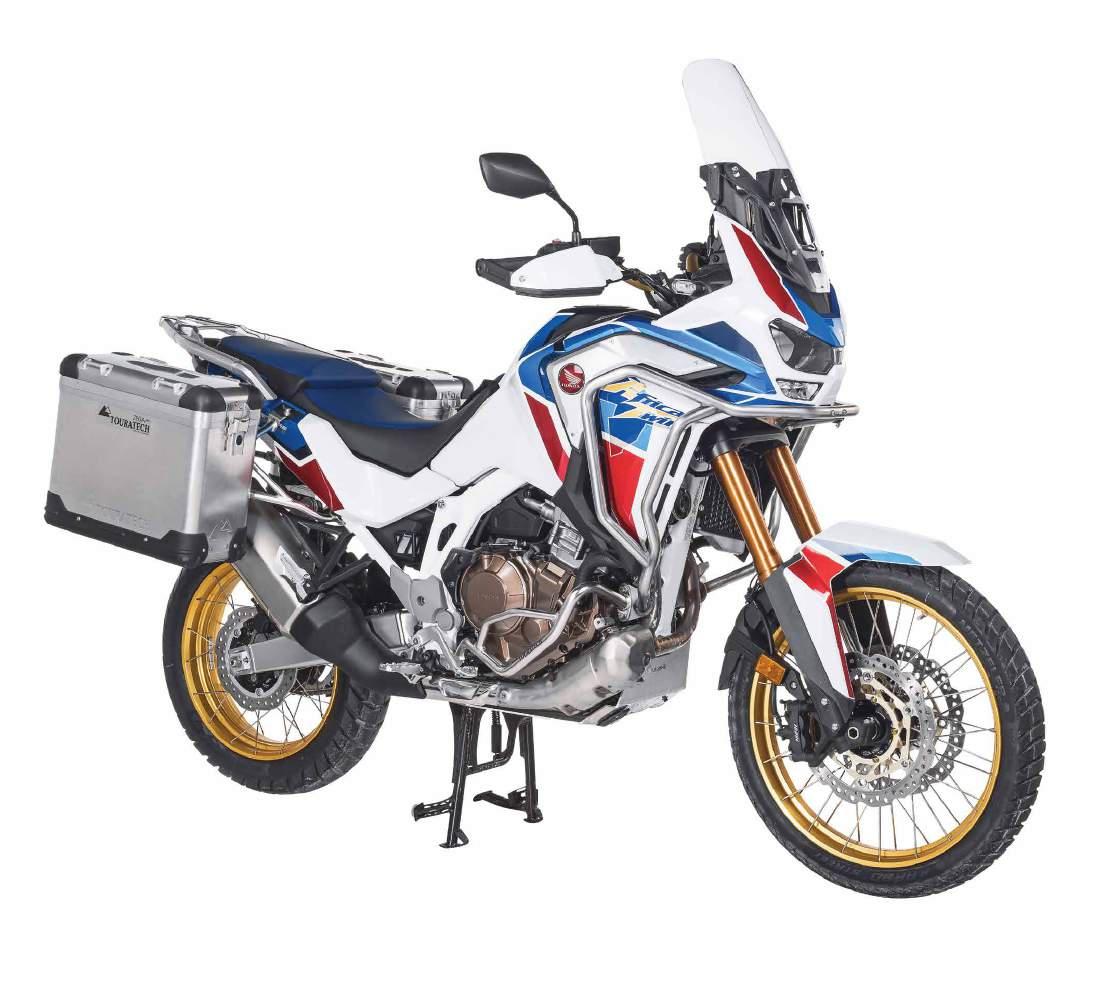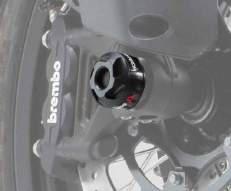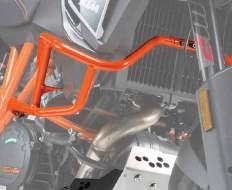










Tom Foster - Editor
This year got off to a shit start when Toby Price didn’t win Dakar and it’s been all downhill from there. Getting this issue over the line hasn’t been easy, and the next one looks like it’ll take some seriously fast footwork.
Sometimes when things get tough I can’t help myself. I look out the window next to my desk and I begin to daydream.
I imagine I’m on my bike – the bike I’ve had for years. The one I keep in tiptop condition although it hardly ever leaves the shed – and I’m riding with no time constraints.
It’s always sunny and warm in the dream. No-one’s phoning me and I don’t have to be anywhere at any particular time. Sometimes I’m scything through
dunes and struggling with the dust and sand. Sometimes I’m cruising along a back-country road and loving the smell of a freshly slashed paddock. Sometimes I’m sitting on a headland watching an incredible sunrise, and other times I’m at a single-pump servo in a town so far from civilization no-one’s ever heard of it. There’s me and another rider and we swap a couple of sentences on what’s ahead and what’s behind before enjoying a quiet cold drink and heading in opposite directions to whatever our futures may hold. Sometimes in the dream I’m not even riding anywhere. I’m camped on a beach I don’t even know the name of with a smouldering fire and some cooking gear, and I’m savouring the flavour of a freshly caught fish cooked over the flames. Nothing complex. Just the fish and perhaps a lemon and a sprinkle of herbs I carried with me for the occasion.
“ This year got off to a shit start when Toby Price didn’t win Dakar and it’s been all downhill from there. ”

forward. The wind and rain are hammering us, but we, the bike and I, meet it head-on, tough it out, and master it, arriving shattered at a deserted campsite where there’s dry wood and shelter. The sleeping bag has stayed dry, and with the fire crackling away there’s coffee and sugar in a cup and a lamb-with-mint-mashed-potatoes dehydrated meal waiting beside it. As the night closes in, I stretch out and think how life couldn’t be a whole lot better. Maybe I’ll run a spanner over the bike, more out of affection than need, then get some sleep before heading off in the morning.
On a different day the dream might be facing up to a really wild, tough storm. One so demented it’s difficult to keep the bike upright, let alone moving
Then the phone or an e-mail alert will shred the illusion and reality will sink its teeth deep into my day again. Deadlines loom, there’s always problems – with travel or injury or some stupid virus – and the real world keeps turning the screw.
Don’t ever let your dreams go. Dreams are the start of great adventures.



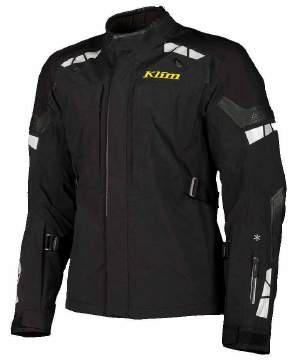

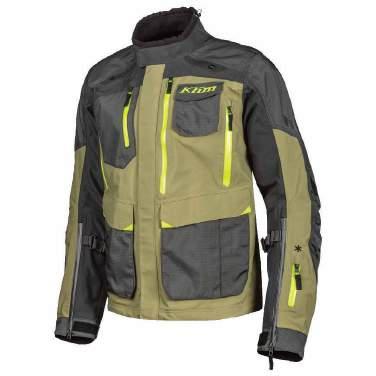








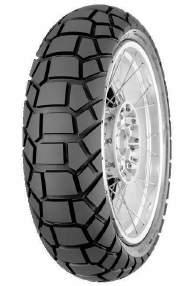





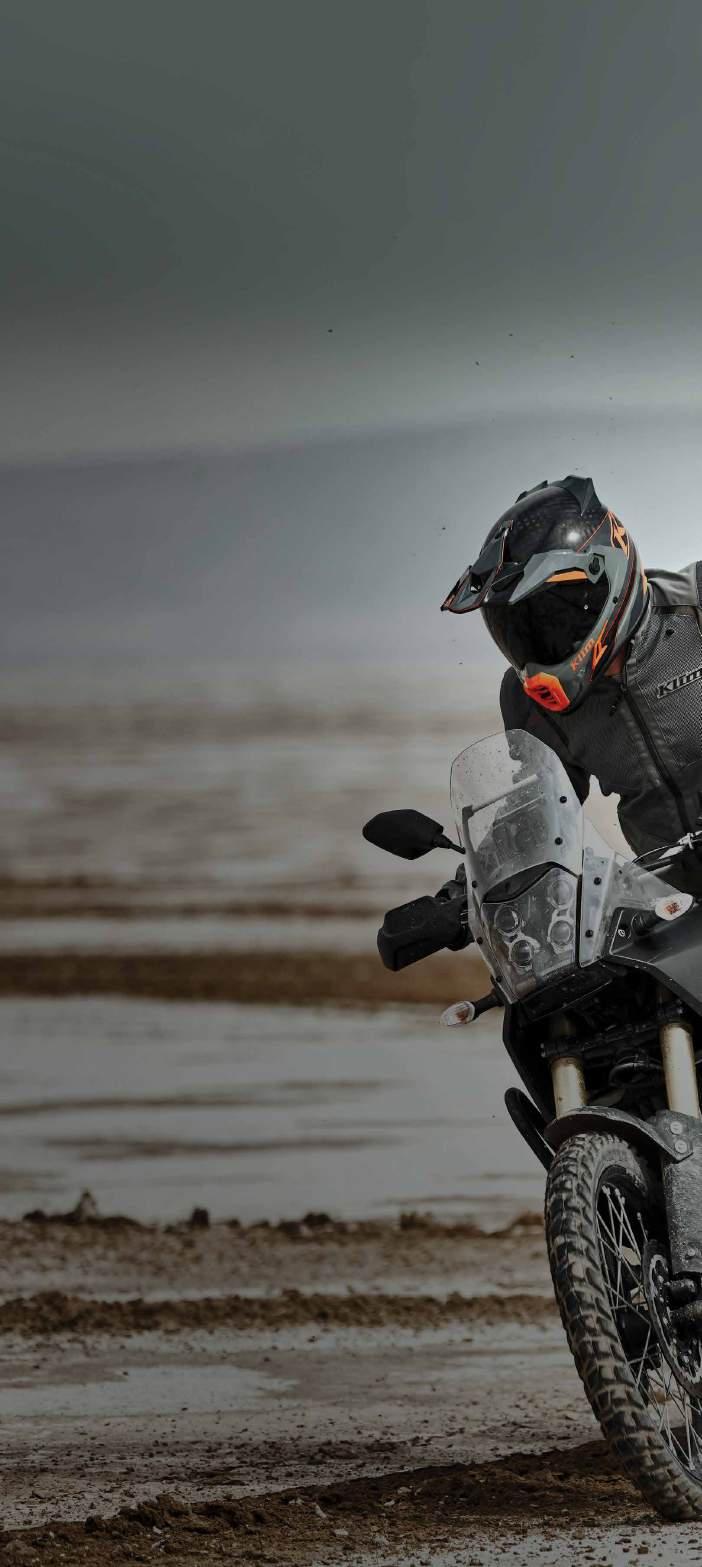

Adventure Rider Magazine is published bi-monthly by Mayne Media Group Pty Ltd
Publisher Kurt Quambusch
Editor Tom Foster tom@maynemedia.com.au
Group Sales Manager Mitch Newell mitch@maynemedia.com.au
Phone: (02) 9452 4517 Mobile: 0402 202 870
Production Arianna Lucini arianna@maynemedia.com.au
Design Danny Bourke art@maynemedia.com.au
Subscriptions (02) 9452 4517
ISSN 2201-1218
ACN 130 678 812
ABN 27 130 678 812
Postal address: PO Box 489, DEE WHY NSW 2099 Australia
Website: www.advridermag.com.au
Enquiries:
Phone: (02) 9452 4517
Int.ph: +61 2 9452 4517
Int.fax: +61 2 9452 5319


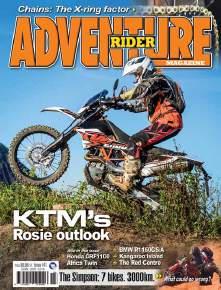





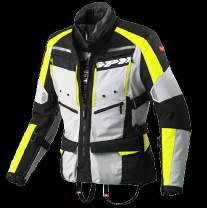
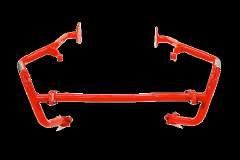
$24,750 RIDE AWAY*

$24,150 RIDE AWAY*

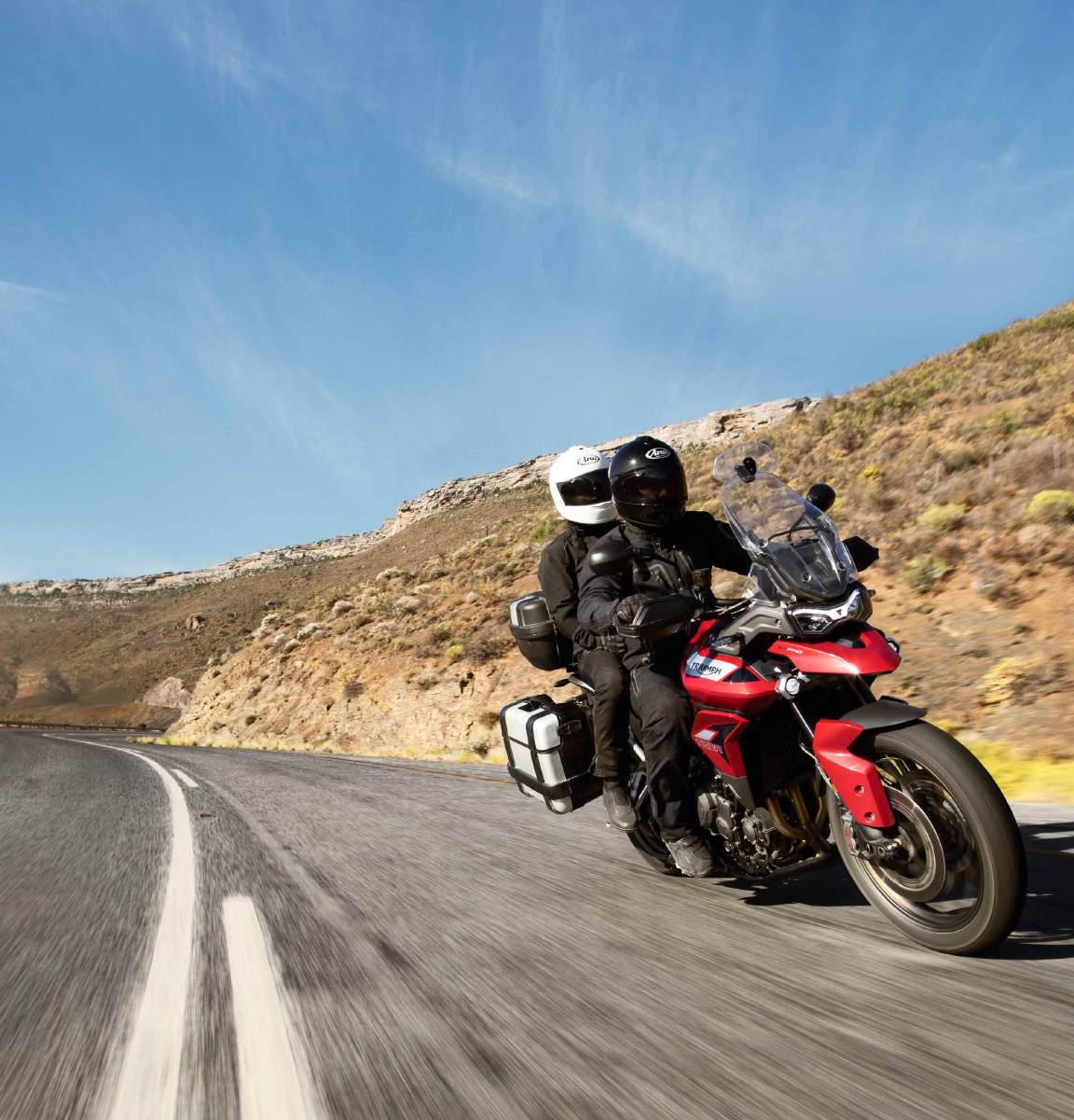
A QUANTUM LEAP FORWARD IN CAPABILITY, FOR MAXIMUM ADVENTURE IN EVERY RIDE.
TIGER 900 GT - Built specifically for road-going adventure, comfort and capability, the new Tiger 900 GT range has all the performance, rider-focused equipment and technology to approach every ride in confidence.
TIGER 900 RALLY - An exciting new Tiger range designed for maximum o -road adventure and all-day riding capability, control and comfort, courtesy of the greatest ever triple engine performance and specification.

Q Year one excuse: work commitments
Q Year two excuse: family holiday
R Year three…game on. Chris Bostelman tackled a big one.


Left: Not one, but two spare clutch plates. Both were needed.
Above: The planned route was Tibooburra to Cameron Corner, across the Merty Merty dunes to the Old Strzelecki Track and down into Arkaroola. Then The Oodnadatta Track to make Mount Dare and across The Simpson before heading back through Innamincka to Tibooburra.
We started off seven riders strong – five from Port Macquarie and two from Sydney –for an unsupported crossing of the Simpson Desert.
The crew consisted of Allan on a DR650, Adam on a 500EXC, Scott with a Husky 701, and Mick, Greg, Dave and myself all on 690s. And yes, we had spares, including fuel pumps and an injector. The tyres of choice were from the Motoz range. We had Tractionator Deserts, Tractionator ITs and Tractionator Adventures.
The bikes were towed from various home locations through Broken Hill and into Tibooburra, with the first of several kangaroo strikes just outside Broken Hill.
At the Family Hotel in Tibooburra there were discussions with another group that had just crossed. They advised us we’d struggle unsupported. Half the bikes in their group came out of the desert on the back of utes. Some had mechanical issues, some crashes, and there were lots of tyre troubles every day.

I have to admit that unnerved us all a little.
The planned route for the first day was Tibooburra to Cameron Corner, across the Merty Merty dunes to the Old Strzelecki Track and down into Arkaroola.
The following few days were to be spent on The Oodnadatta Track to make Mount Dare before attacking The Simpson.
With all the last-minute items attended to we were off! Or so we thought…the DR wouldn’t start. We managed to tow start it, but a cough and a splutter later it would run no more. Battery voltage was good, but a jump starter was tried anyway. The DR wasn’t going anywhere.
Fuel check? Pass.
Spark check? Fail.
After a few tests we were down to either the stator or pick-up sensor. We tried the pub, shops and servo in Tibooburra for parts, but as expected, with no luck. We called Broken Hill for parts and received the reassuring news: “Sure, mate. We can have one
u
there in a week or so.” By then we were all due back at work.
Out of nowhere, Adam on the 500 said with euphoric glee, “I saw a DR650 in the shed at the top of the hill.”
That was amazing, and not just because there was a DR nearby, but because there was a hill out there.
So, with a new mission, the crew split up and started asking around town for the owner of the mystery bike.
One of the girls at the pub had the answer and offered to call the owner!
Only a few minutes later, Burt drove up to Al’s poor, stricken DR, rolled down the window and the quest to borrow parts began. We explained the situation and after chatting with Burt about our grand plans for adventure, we were given
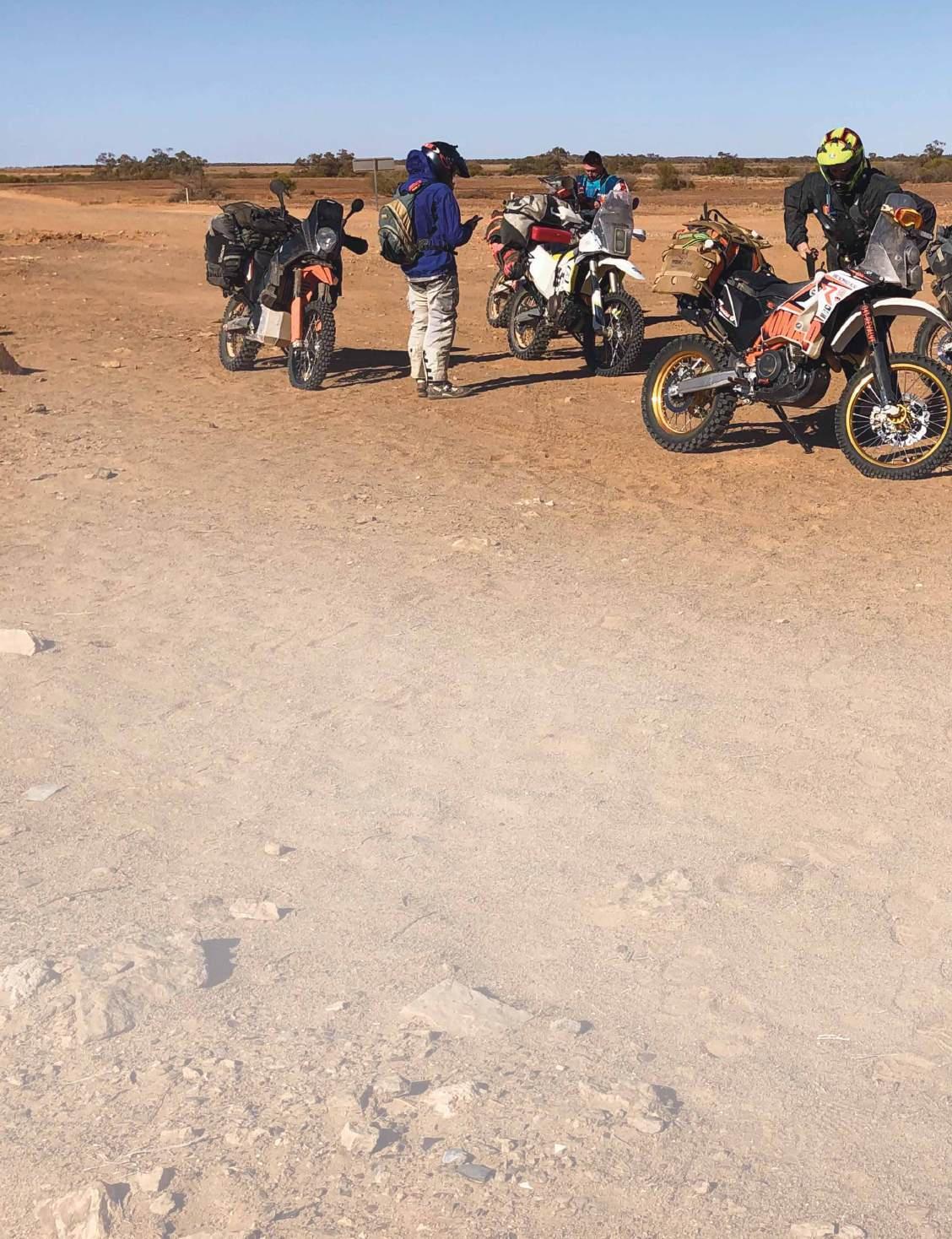
permission to violate the left-hand crankcase and borrow the parts off Burt’s 17-year-old bike.
People sometimes pick on the trusty DR650. It’s old, heavy, underpowered and so forth, but on this day we were happy. The parts were identical. We completed the transplant, reassembled the donor DR and we were off.
Allan, the owner of the spritely three-yearold DR650, and I left five hours behind the rest of the crew. Leaving late meant, after we hit the Old Strzelecki Track, we had to shortcut across towards Lyndhurst to meet the Fantastic Five. We didn’t make it to town before the ’roos came out to play, so a bush camp it was for the Sydneysiders.

An early start was in order the next morning to try and beat the boys to where our paths were to cross 100km or so later. As it turned out, they had so much fun in the Flinders Ranges we beat them to breakfast. When we couldn’t get in contact we assumed, dangerously, they were in front of us. We rolled on after a lazy breakfast and left a message via Delorme Inreach with our new plan. We wouldn’t hear from them or see them until later that night at William Creek. Allan and I made it to William Creek in time for a late lunch and some leisure to do bike maintenance, laundry and some carefully considered rehydration at the pub before the others arrived.

From William Creek we bounced and rattled our way to the Pink Roadhouse the next morning, intending to make it to Mount Dare.
Discussion at the stop revolved around how far the lead rider would travel before checking everyone was together and moving forward. All options were considered, and it was agreed to use the cornerman system. Once in the desert this also meant stopping regularly to ensure the distance between the lead bike and sweep bike wasn’t too great. Simply stopping at the top of a dune and making sure the bike behind was still
Above: Together again: The seven dualsport delinquents on the Oodnadatta Track.
Far left: The white of the salt pan looked distinctly blue from the hill above.
Left: An Aussie icon.
Below: Cameron Corner on day one.
Right: Check your bike after you have a lie down. Even better, get a mate to check it while you catch your breath.
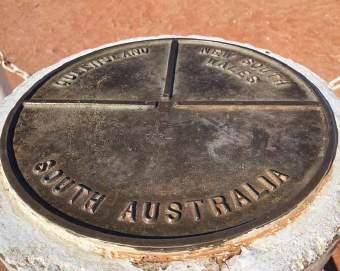
in view was thought to be safe enough and wouldn’t slow progress as much as stopping all the time to re-group. We also wanted to avoid the first bike having to cover big distance returning to help the last bike as that would use valuable fuel. We tried the system after topping up food, water and fuel and it all fell apart at the first turn. We ended up with an hour’s delay and five of the seven bikes using a lot of fuel in the process. That wasn’t critical at that stage as we still had a fuel stop in front of us, but it was a good lesson.
Later that day Allan hit a bulldust patch just in front of me and all I saw was the fat acrobat – the DR650 – get a serious wobble up. I lost sight of bike and rider and thought they’d separated from
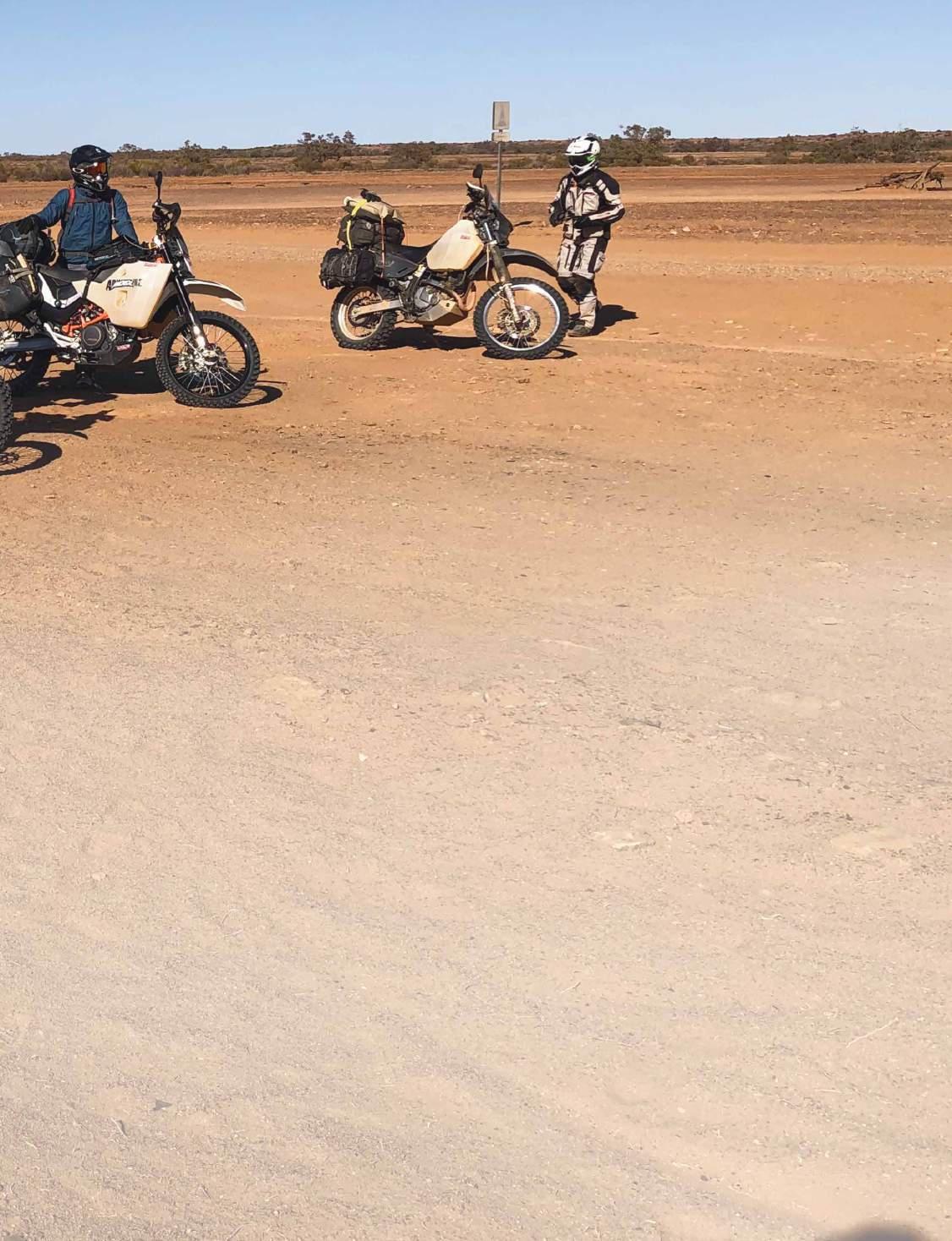
each other. My avoidance of the fallen body and bike resulted in a couple of injured ribs, and while I don’t know the actual diagnosis, they bloody hurt over rough corrugated tracks. One helpful chap at Mount Dare pointed out there were 234,683,212 corrugations between William Creek and Mount Dare, and he only counted them if they were 10cm or higher.
The first day of the Simpson Desert crossing was just in front of us. Everyone had done their internet research and knew how much fuel it should take to cross and had added a few extra litres. In theory this should’ve been fine, as long as we didn’t make any navigational mistakes or have any fuel loss. Allan and I each had between six and eight litres more than we thought we would need and enough food for four full days.
Did anyone say ‘doomsday preppers’?
Late that afternoon our final preparations had been made. Bikes had been checked and fuel, food, water and courage had all been topped up. As far as fuel went,
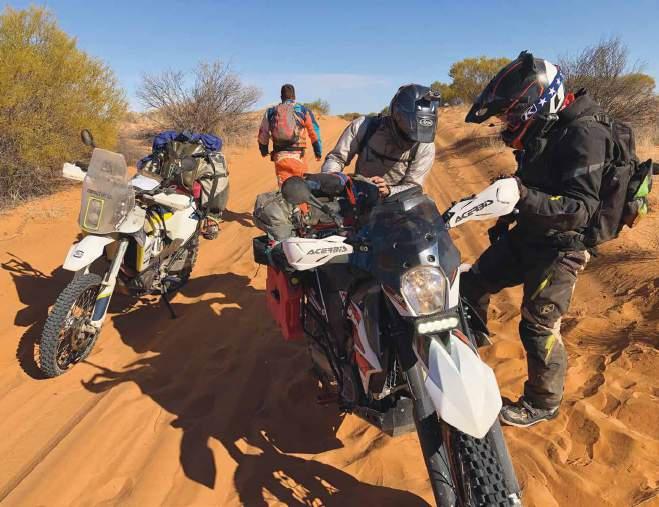
Adam, Dave, Mick and Greg all had 36 litres, Scott had 38 litres, and Allan and myself had 50 litres.
The fourth day dawned and we left Mount Dare in the dark. I figured the corrugations wouldn’t be as bad if I couldn’t see them.
We pulled into Dalhousie Springs and decided a swim would take too much effort and time. If you haven’t been and you have the time, it really is a must. Watch out for the flies and mozzies though. They can be ferocious.
Onwards to Birdsville we went.
The scenery and colours of outback Australia are truly breathtaking. Making time to soak up the desert ambience should be on everyone’s bucket list.

It was around about Purnie Bore it hit us. It was harder than any of us had imagined.
Our bikes were loaded to the point where we might as well have had pillions. The going was slow and tough. Anyone with shorter legs struggled to stop without having a lie down in the sand, and the game of using fuel so as to reduce weight versus being conservative and maintaining fuel range was on.
I admit I wasn’t feeling good for the first part of the morning, but once in the groove and used to the weight, things got a little easier. By midmorning though, a few of the crew were starting to run out of energy. We had each emptied the first of our fuel bladders and already we had some fuel loss due to bladder leakage… fuel-bladder leakage that is.
After a few more lie downs the energy
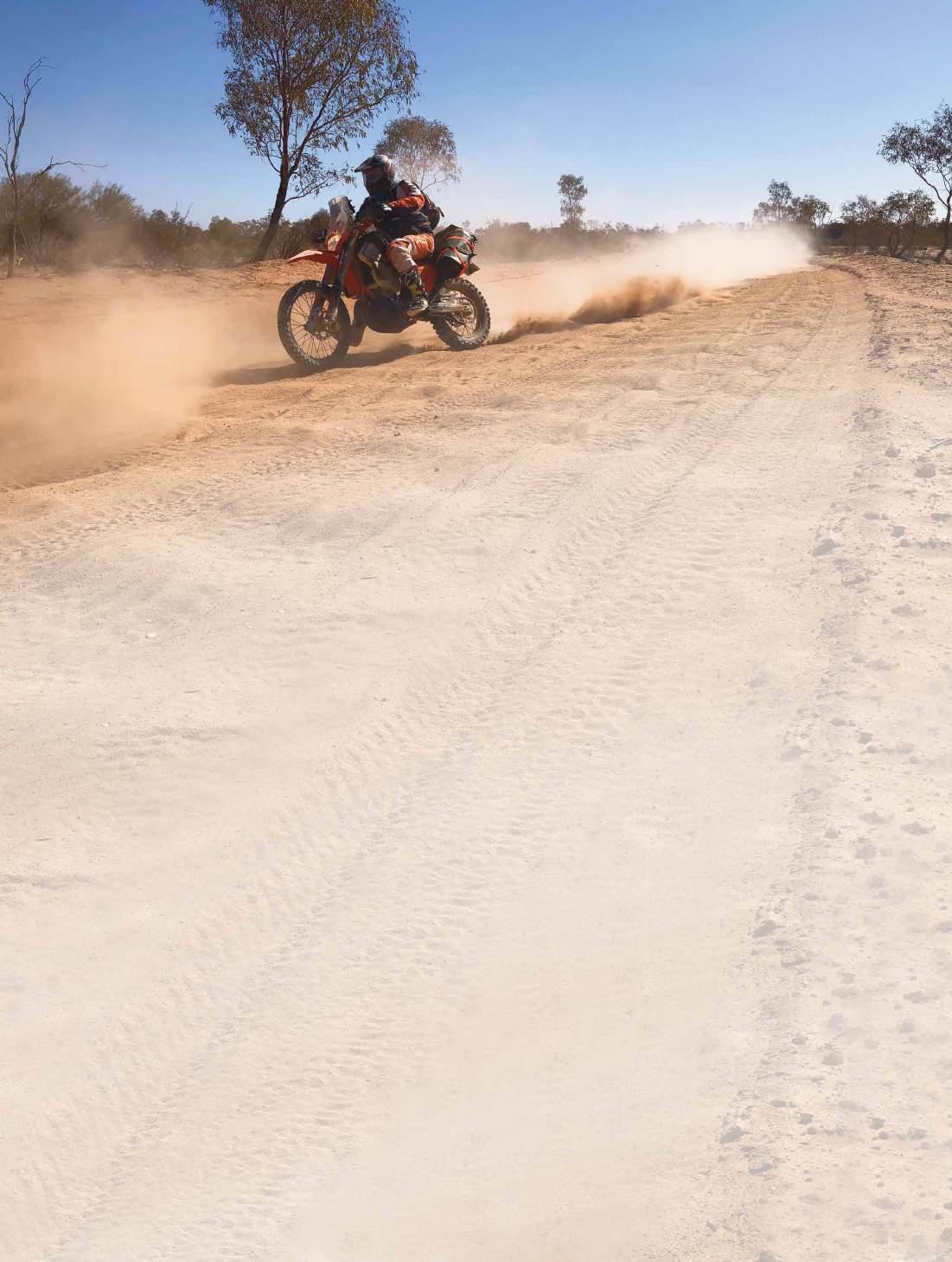
levels and mood had dropped. The going was hard. The Stockton Beach sand practice, although useful, hadn’t prepared us for the level of challenge. We were late in the season, the days were getting hotter and finding a clean line to run at a moderate pace over a dune was almost unachievable carrying such big loads. By lunchtime talk had started about a Plan B. Turning around was an option, although not favoured by most. Research showed what we had experienced on the French Line so far was likely to continue for quite a while. Being late in the season, the traffic over the dunes had created huge sandy ruts and corrugations between 60cm and 90cm deep. Plan
Above: Adam on the ‘little’ 500cc single on the fourth day. The KTM was the best-sounding bike on tour.
Below left: A turning point.
Below: Celebration! The DR made it to Poeppel Corner. u




B further developed and became a run down the Colson Track to the Rigg Road and then across to Knolls Track in order to bypass some of the French Line. The idea was to cover some distance and get the confidence up on the southern dunes which weren’t as high or challenging. The distance was greater, but our fuel use should balance out as the going was to be far easier.
With confidence restored we were hoping the French Line would be conquered on the second day in the desert.
After much deliberation we turned south at the Colson Track and then on to the Rigg Road where we camped that night. After the final fuel top up for the day it soon became apparent fuel consumption, particularly that morning, had been a lot higher than anticipated. Those with less fuel on board started to get concerned about making it to Birdsville. On top of that was some only having one day and night’s worth of food left, and the discussion started again about turning back.
On the other hand, a few of us had overpacked food and fuel, and to be quite frank, beyond the weight penalty, we were comfortable we could make it across even if it took a few more days. We would probably have had enough for the seven of us to get across if we’d pooled provisions.
There were a few bottles of red and the odd chair came out to the fire that night, so we weren’t doing it too tough. That space would probably have been better used for additional fuel and food, though. Another lesson learned maybe.
We hunkered down by the fire and watched the magnificent desert sky. The Milky Way was spectacular out in the desert – another outback highlight.
It was decision time.
After rehydrating by the fire, rider’s choices were clear: Adam, Greg, Mick, Dave and Scott decided to err on the side of caution and planned to run back up to the intersection of the WAA Line and the Colson Track before heading west along the Rig Road to the Oodnadatta Track for some more corrugations; Allan and I decided to continue on as we felt we had sufficient supplies. We made sure each

group had suitable provisions and spares before we parted company.
Nights are generally cold in the desert so tents, bivvies, sleeping bags and thermals were unpacked. To give an idea of the drop in temperature after sundown, the water bladder on my bike had a sheet of ice on it in the morning.
Travelling in remote areas is dangerous. Having too much or not enough can be the difference between an amazing trip and a potential disaster. Too much gear and you’re too heavy. Not enough and you can get into trouble if the weather turns and you can’t move forward.
The mighty DR650 and the oldest KTM690 were packed and warmed up in time for first light: ‘Birdsville, here we come’ was our mental war cry.
Sand dunes, clay pans and salt pans were the order of the day. Wildflowers were starting to bloom and the trees were greenish in most areas.
Before we turned on to Knolls Track
Above: Once in the groove and used to the weight, things got a little easier.
Below left: Borrowing Burt’s DR650 bits.
Thanks again, Burt!
Below: The parts from the 17-year-old donor bike were identical.


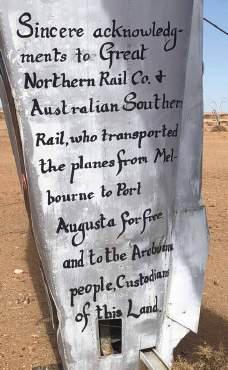
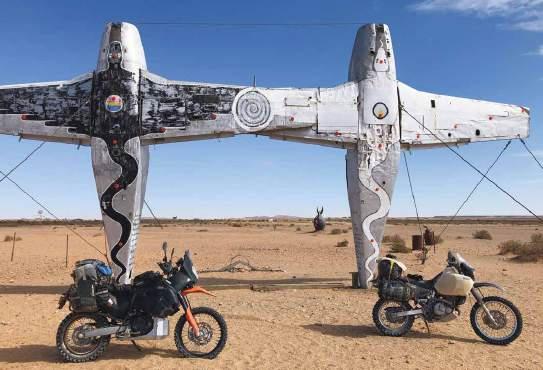
we were greeted by an enormous lake. Whether or not it was dry was the question. The white of the salt pan looked distinctly blue from the hill above and we thought we may have to find a way around. But as we approached we realised it was a reflection from the magnificent blue sky. Phew. Tackling salt or clay pans with caution is advisable. There appeared to be a solid surface crust, but we kept a good distance between ourselves in case the bikes started to sink.
The sand dips on Knolls Track would’ve swallowed a 4WD. In the middle of a dip, while standing up on the ’pegs, we were literally at eye level with the grass on the side of the track.
Back on the French Line the dunes were soft, badly rutted and had metre-deep holes in the wheel tracks. If you didn’t make it up and over on the first attempt,
there was no hopping off and pushing to the top. You simply had to turn around and have another go. After hours of the dunes getting softer and deeper, we needed a revised dune-riding technique.
At the bottom of each dune this wise mantra would echo in our brains…
R Hold it wide open in third or fourth
R Pause at the top but don’t let the wheels stop turning
R Check the coast is clear and you have a good line
R Change down one gear and nail it again
R Rest in the gap between dunes. It was thoroughly addictive, and while the above worked, there were other things to consider. At the bottom of a dune we had to pick the clearest, straightest line from an existing wheel track to the desired wheel track at the top. We had to ignore any track conditions that wouldn’t make us crash into a tree, bike, person or car. The idea was to look
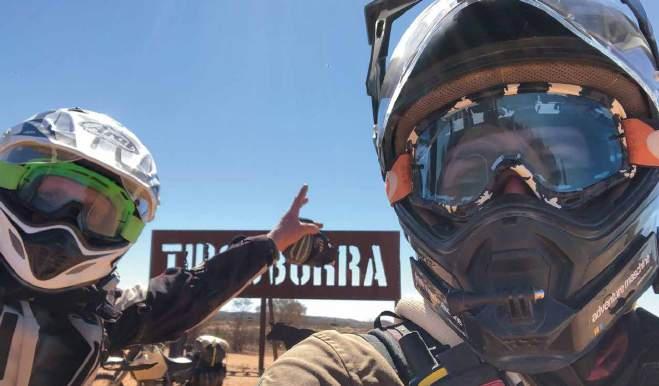

ahead at the destination and accelerate to a speed that helped the bike float over the top of the ruts. It was important to not ride down into, and back out of, every dip.
The afternoon saw us within range of Big Red. We’d kept a steady pace all day with food breaks every few hours to keep the energy up. We swapped the lead every 10km and checked on each other using a simple thumbs up while still moving.
We hit the Eyre Creek detour and enjoyed the sights and sounds of the trees, creek and the numerous bird species. We
Above: ‘Planehenge’. A well-known landmark on the Oodnadatta Track.
Below left: Back at Tibooburra. ‘Hey! Let’s work on the DR again!’
Below: Broken weld? No problems. Just add cable ties.


Harder then any of us imagined
knew we weren’t far away from the edge of the desert and this gave us a much-needed boost. We were chasing our own shadows as we approached Big Red.
As we came across the final clay pan we were greeted by several tourist buses at the top of the big sand hill. They would be witnesses to our success…or failure. Time would tell.
We initially hit the base of the dune at between 70kph and 80kph, heading to the tracks on the steepest ascent. The tourist cameras caught us at the top… almost. We stopped with a just a few metres to go.
We dragged the bikes around and headed back down for a second attempt.
For round two we hit it slightly faster and used our own track. This tactic took us to the top of the steepest ascent and we sailed up and over. The DR had definitely left some of its clutch behind, and after it cooled down we thought it may have just been overheating that was causing the slip.
We watched the sunset over the desert, took a few happy snaps and headed off for the cold ride to town, arriving at the Birdsville Hotel in the dark and celebrating with a huge outback meal and plenty of carefully chosen rehydration fluid.
Plating up
The plan was to be back in Tibooburra



in two days, with an overnight at Innamincka on the way.
After a good rest and a leisurely start, we rolled on. But only minutes after leaving Birdsville the mighty DR halted forward progress. The poor Suzi needed a little lie down and some clutch-plate lovin’.
Allan rustled through his DR parts bag, which I must say was quite cavernous. He had a choice of two clutch plates, both new in genuine-Suzuki bags, and the rebuild began. There was one friction plate that was no more, so we changed it out. It was probably close to 30 minutes and we were off again. The second DR surgery had been a success.
After turning onto Walkers Crossing Track at the 44-gallon drum the ‘road’ went to wrack and ruin. The track’s wheel ruts snaked through the gibber plains, then the corrugations started and I thought, “F%^$! Not again.” This continued for about 20 minutes, but soon mercifully turned into an outback version of the Oxley Highway for adventure bikes.
Top: Camping on the Rigg Road.
Left top: Mick, winner of the ‘Sexiest Bike On Tour’ award.
Left: Scott prefers his KTM in blue-and-white.

It was like being on a Moto 3 bike with knobbies: head under the screen and elbows tucked in. The fun had begun.
Not far onto this awesome track the power of the Allan/Burt hybrid DR650 was too much for the clutch and the third DR open-heart surgery was scheduled. Allan had the spare clutch plate whipped out of his bag in a jiffy and we were into it. This one took a bit more time. We had to remove the friction plate material from the spring plate, rather painstakingly, with a hacksaw blade and a file from a Leatherperson multitool. It probably took us an hour before we were ride tested, luggage loaded and on the move again.
We used more fuel on the track to Innaminka than we did on the second day of the Simpson crossing and we covered a similar distance, and by the time we hit Innaminka we were grinning in our helmets as we topped up the desert sleds for our final ride day.
We pulled up at Tibooburra in the early afternoon of the next day and started to return the left-side crankcase to the rest of the mature DR in the shed. DR surgery number four was almost completed when Dave,
Greg, Adam, Scott and Mick arrived back at the trailers having finished their own adventure.
Burt, the saviour of our trip, thought the rest of his bike would be jealous with the left side of the motor doing a Simpson Desert crossing while the rest of the bike stayed home, probably destined for nothing more than future mustering duties. There you go, we did the old DR a favour.
Well parts of it anyway.
A massive shout out to Burt. Without his willingness to help and loaning us the parts we would never have left Tibooburra and had such an amazing outback adventure.
It turned out Burt owned the Family Hotel at Tibooburra. I’ve stayed there half a dozen times now and have always enjoyed the outback hospitality with great food and accommodation. If you pass through, drop in for a meal or, even better, stay the night and support a fellow rider and a top bloke.
With over 1200km to get home and very little afternoon light remaining, we loaded up and made tracks. Stopping at Broken Hill, we met up for dinner and shared the stories of adventures since we’d parted a few days earlier. The mood was sombre with our outback adventure done for another year.
Conversation soon turned to bike modifications and returning next year for a double unsupported crossing.
You have been warned. It is very addictive.

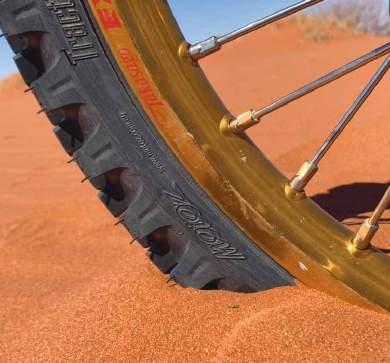
R Check your bike after you have a lie down. Even better, get a mate to check it while you catch your breath
R For heavy off-road riding use soft luggage and containers. A Rotopax-style container or hard luggage can hit your legs and can also pin you under the bike
R Choose water-bladder brands carefully. Running out of water can be life threatening. Some bladders don’t cope with heavy corrugations.
R Choose on-bike fuel containers carefully. Loss of fuel can be a real issue on an unsupported crossing
R Do your track research well. Have a Plan B. Know the conditions of all alternate routes
R Try not to travel late in the season. Tracks are softer and heavily damaged from all the traffic
R Allow plenty of extra food, fuel and water. Shit happens, and you need some contingency
R Have good communications to call for help if needed. Even better, have several comms options
R Make sure you have check-in points with someone not on the trip who knows your itinerary
R Cable ties can fix almost anything
R Use Motoz Tyres. We had no tyre issues on this trip. With seven bikes travelling over 3000km each that’s over 40,000km of trouble-free outback travel
R Watch out for bulldust. Riding too close leaves few options if things go wrong with the bike in front
R Have a good group riding plan. Include recovery options and hope you never need them
Will Fennell headed to South Australia’s Kangaroo Island and found a spectacular adventure riders’ paradise rising from the ashes of recent
fires.
During the summer of 2020 South Australia’s Kangaroo Island was severely affected by horrific bushfires. Thousands of hectares of national park, farmland and forestry, predominantly on the western end of the island, were decimated by the intense fires. Aside from the significant damage to the natural environment and catastrophic wildlife losses, tourists were down to about one-third of usual numbers. Consequently, many businesses on the island were suffering.
In January 2020, in response to the #bookthemout and #spendwiththem social-media campaigns, I put the call out for any riders interested in heading over to the island to explore its remarkably changed landscape, but moreover to spend money in the local cafés, pubs and petrol stations which were badly in need of tourist dollars.
My call was answered by a group of three fine lads on trailbikes who were up for the ride. Our team was comprised of Alex on his 450EXC, Huon on his WR450F, ‘Dr Zee’ on his DRZ and I’d be riding my well-travelled BMW G650GS Sertão. Generally I ride with 800cc and larger adventure bikes, so I was looking forward to for once being the guy with the largest fuel tank.
I pretty quickly worked out that, with no fuel available west of Vivonne Bay, we were going to need a support vehicle if we were to have any chance of covering the sort of distances I had in mind. Luckily my lovely fiancée Lucy and her bestie Ally were keen to join in on the adventure, bringing up the rear in a VW Amarok. Normally I’d have worried about there being no ’roo bar, but frankly, given recent events, we didn’t expect to see many ’roos.
The itinerary
We planned a weekend trip, arriving in Penneshaw late Friday night and departing Sunday afternoon. Our navigation plan was simple. On Saturday we would explore the south coast of the island and

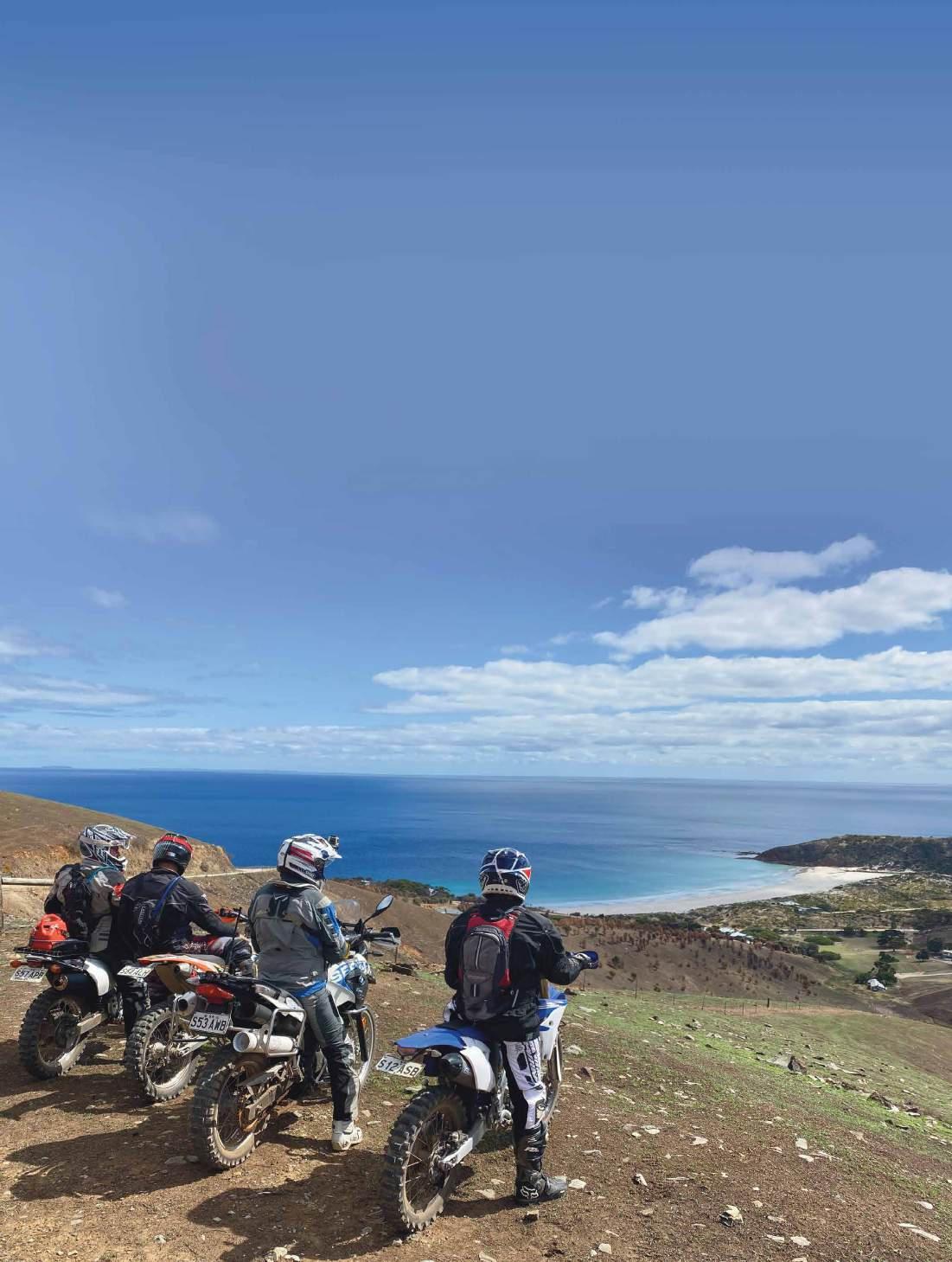
Snellings Beach, one of the most picturesque parts of Kangaroo Island.
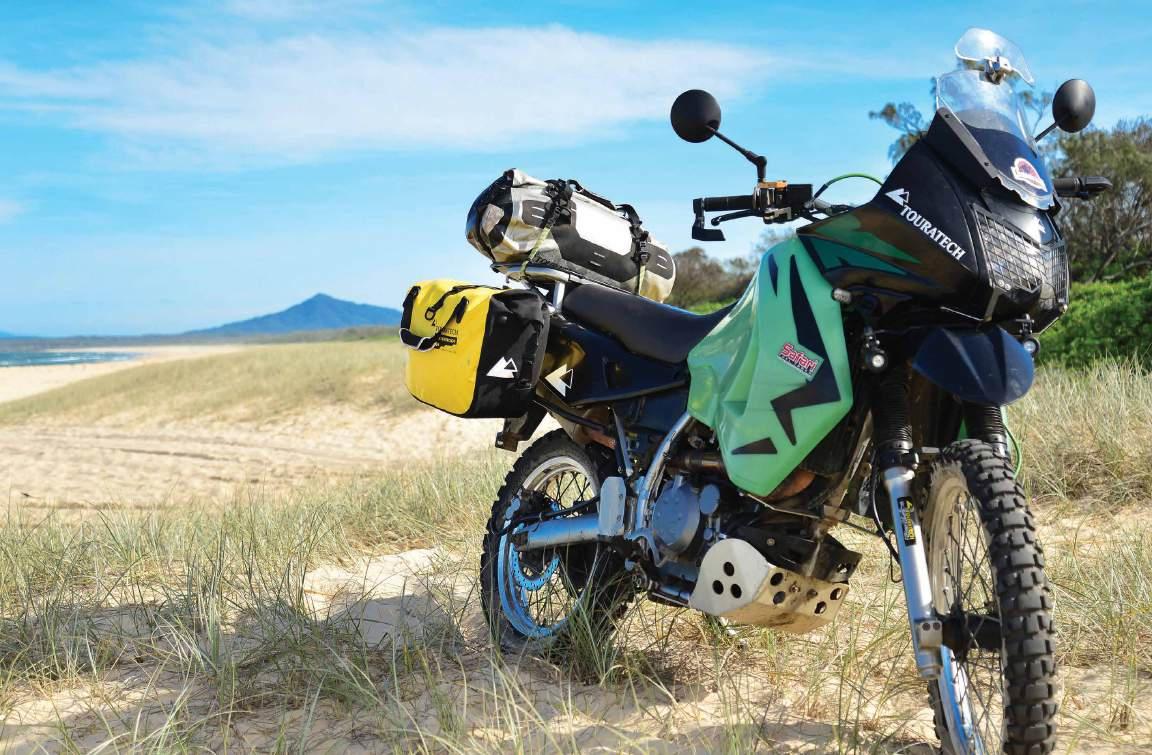


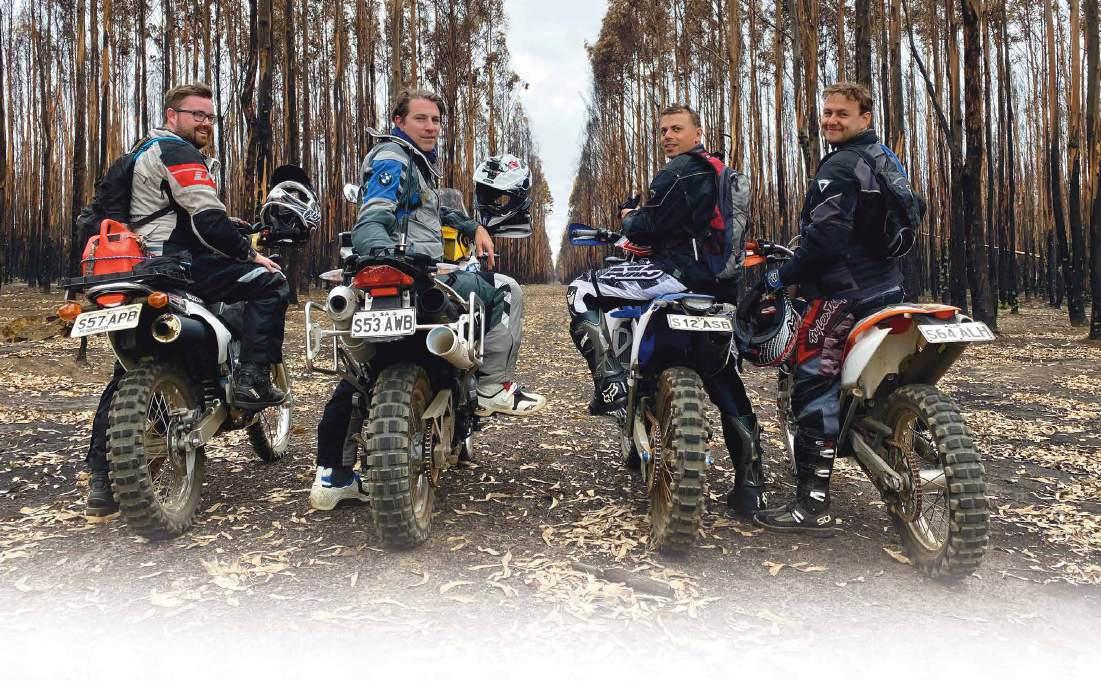
stay overnight at Parndana (a rural town almost dead centre of the island), and on Sunday we would explore the northern coastline. Huon was very familiar with the island and acted as our local guide.
With some late-night electrical work in the lead up to the trip we managed to get UHF comms between the Sertão and the Amarok, thanks mainly to a Sena SR10. Being able to talk on the go between at least one bike and a trailing 4WD meant less stops and more ground covered.
The trip commenced with a tarmac ride from Adelaide to Cape Jervis before a 45-minute ferry trip to Penneshaw. The ferry workers did a first-class job securing the bikes, and after a smooth crossing we were met with gently drizzling rain. We quickly setup camp before heading up to the Penneshaw Hotel to settle in for the evening.
It was clear by breakfast on Saturday morning no-one was going to weigh any less on the ferry on the way home. After a round of delicious bacon-and-egg rolls at the aptly named Fat Beagle Café in Penneshaw we headed for our first destination, D’Estrees Bay.
One of the great features of Kangaroo Island for adventure riders is beach access for motorcycles, and D’Estrees provided our first opportunity for a play in the sand. We also found some great sandy twin track running parallel to the beach. Luckily Alex noticed, before it flew off into the scrub, that the seat on his KTM wasn’t attached to the subframe due to a seat bolt having rattled loose on the corrugated Kangaroo Island roads. Fortunately for Alex a bolt out of my BMW spares pack was a perfect fit, and with the KTM reassembled we headed for a sightseeing stop at Seal Bay.
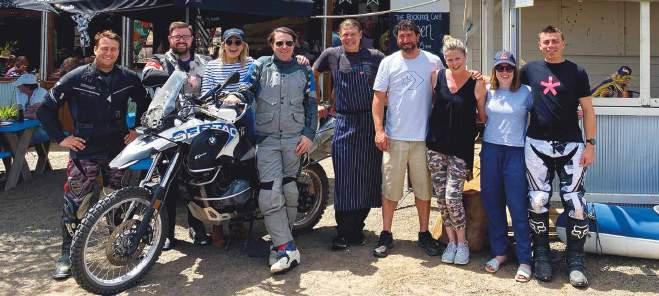
No prizes for guessing what we found there.
The next stop along the south coast that morning was Vivonne Bay. The general store is famous for its whiting burger, and with breakfast barely digested we tucked into lunch. Suffice to say the whiting burgers lived up to their legendary reputation.
After lunch we witnessed the first seriously fire-impacted area on the seafront at Vivonne Bay. The fires had burned right across the dunes down to the beach, leaving exposed a fragile dune system.
From there the extent of the fires became even more apparent as we made our way west along South Coast Road towards Flinders Chase National Park. Road signs had literally melted and once dense and impassable bushland was burned to the ground. The fires had raged for miles and miles, and seemingly always along the roadway. That must’ve made firefighting for the CFS precarious to say the least. The intense damage gave us a real appreciation for the



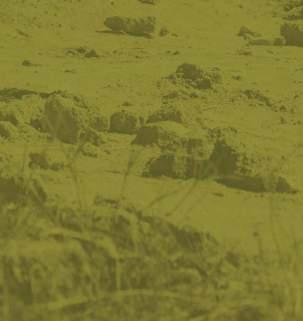
















bravery of the men and women who had fought those fires.
We then made our way down to the recently reopened Hanson Bay. Although the beach had vehicle access, it was soft like quicksand. Even the wet sand offered little support. The boys enjoyed watching the Sertão plough slowly along the beach with rev limiter engaged as it struggled to gain momentum.
We then made our way northeast to our overnight stop in Parndana. There were several north-south roads to choose from, but we chose the Gosse Ritchie Road, a spectacular ride through both National Park and forestry areas. It was a surreal experience picking our way along that road with thousands of acres of burned-out National Park to our left and burned-out forestry to our right.
We’d arrived in Parndana by around 6:30pm and set up camp in the large and reasonably well-provisioned caravan park. The smell of bushfire smoke was
inescapable during the evening shower. I thought it must have been on me –from riding all day through these areas –but it turned out the local water supply at Middle River had been contaminated by ash.
“ The intense damage gave us a real appreciation for the bravery of the men and women who had fought those fires.”
The Parndana Hotel has excellent meals and as we reflected on the day we all said it had been some of the most interesting adventure riding we’d ever done. Despite the devastation, it really had felt like a once-in-a-lifetime experience to see the countryside stripped back to such an extent.

On Sunday morning we packed up camp and headed over to Davo’s Deli in Parndana.
We sat and drank a great coffee in the morning sun and watched some seriously impressive army trucks on their way to the Parndana oval which was being used as a base for the army and also as a campsite for displaced locals. We ended up going down for a look and what turned out to be a poignant experience. It was clear the army, many of whom were reservists, were playing a pivotal role in getting the Kangaroo Island community back on its feet.
We then headed north-west from Parndana along Johncock Road and out to Western River Road. Before we left on this trip I’d been warned about slippery ‘marble-like’ gravel on the western end of Kangaroo Island, and on Sunday we definitely came across it. Combined with bad corrugations, no-one wanted to be rolling too hot into corners.
Top: Melted road signs alongside hectares of burned scrub.
Left: Inspecting the Parndana town water supply, contaminated by ash.
Below: From left: Lucy Damin, Ally Newcombe and Will Fennell. Lucy and Ally were brilliant in the support vehicle.




We followed Western River Road east to join North Coast Road and head towards Snellings Beach. The views along those roads were truly spectacular. Snellings Beach is also vehicle-accessible and, unlike Hanson Bay, was firm to ride on. Naturally, we had a play.
Our Sunday lunch stop was in Stokes Bay at the Rockpool Café. There we caught up with husband-and-wife managers Lucy and Josh, and owner Matt, who all took a few minutes out of their busy day to meet us and have a photo taken. Lucy and Josh had recently lost their home to the fires but, like most islanders, they seemed to be getting on with life with typical Aussie resilience. The food at Rockpool was top notch and we would highly recommend a stop there. We also noticed a camping area out the back of the Rockpool Café and would’ve stayed there if we’d had more time.
After lunch we made our way from Stokes Bay back towards Penneshaw along Bark Hut Road. We found some open forestry roads and great 4WD tracks to explore, but ended up a touch lost in the forest. Burned-out forest looks very different to lush green forest and previous reference points were gone.
After a somewhat dicey crossing through a creek with steep and badly eroded banks – well…dicey on my 185kg Sertão. The smaller bikes just cruised through it – we made our way out of the forest and along a mixture of dirt and bitumen to arrive at the ferry terminal in good time for our journey home on the 4.00pm ferry.
Adventure riders sometimes seek out discomfort and misadventure in search of the ultimate adventure experience.
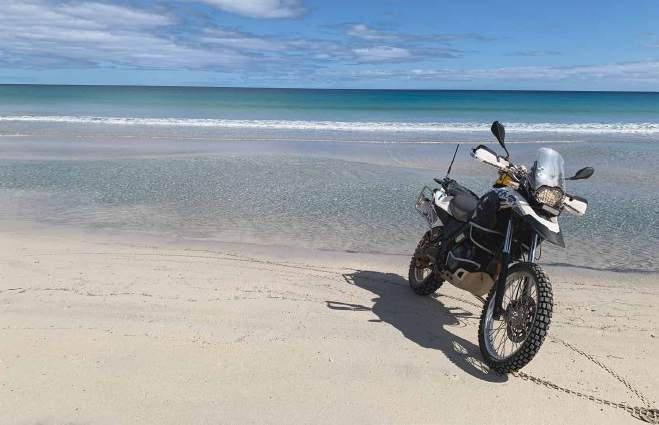
So, given we didn’t drop a bike and barely turned a spanner all weekend, did we still have fun?
Hell yes! We did!
I’d go even further and say this was one of the best adventure weekends I’ve enjoyed. Why? It was a real experience. We saw recently burned landscapes that many people never get to see in their lifetimes. Some of what we saw was confronting. But, most important, we helped make a difference, albeit a small one, to the towns and businesses we visited.
More broadly the fires had highlighted to us the remarkable strength and resilience of Australia and its people, from the incredibly brave CFS volunteers who had fought the fires to the everyday Australians like Lucy and Josh from the Rockpool Café who were stoically getting on with life in the face of adversity. What an amazingly courageous bunch we are. Lastly, the tourism promoters have suggested people should visit the eastern end of Kangaroo Island that was untouched by the fires, mainly because it’s business as usual over that side. But I reckon they’re wrong. The western end was absolutely spectacular and the businesses over that way need our help the most. The wildflowers in the burned-out areas this coming spring will no doubt present an amazing spectacle. Grab a ferry ticket and go #spendwiththem on Kangaroo Island. You won’t regret it.

Top: The dunes at Vivonne Bay left exposed and fragile.
Left: Snellings Beach is vehicle-accessible and firm to ride on.
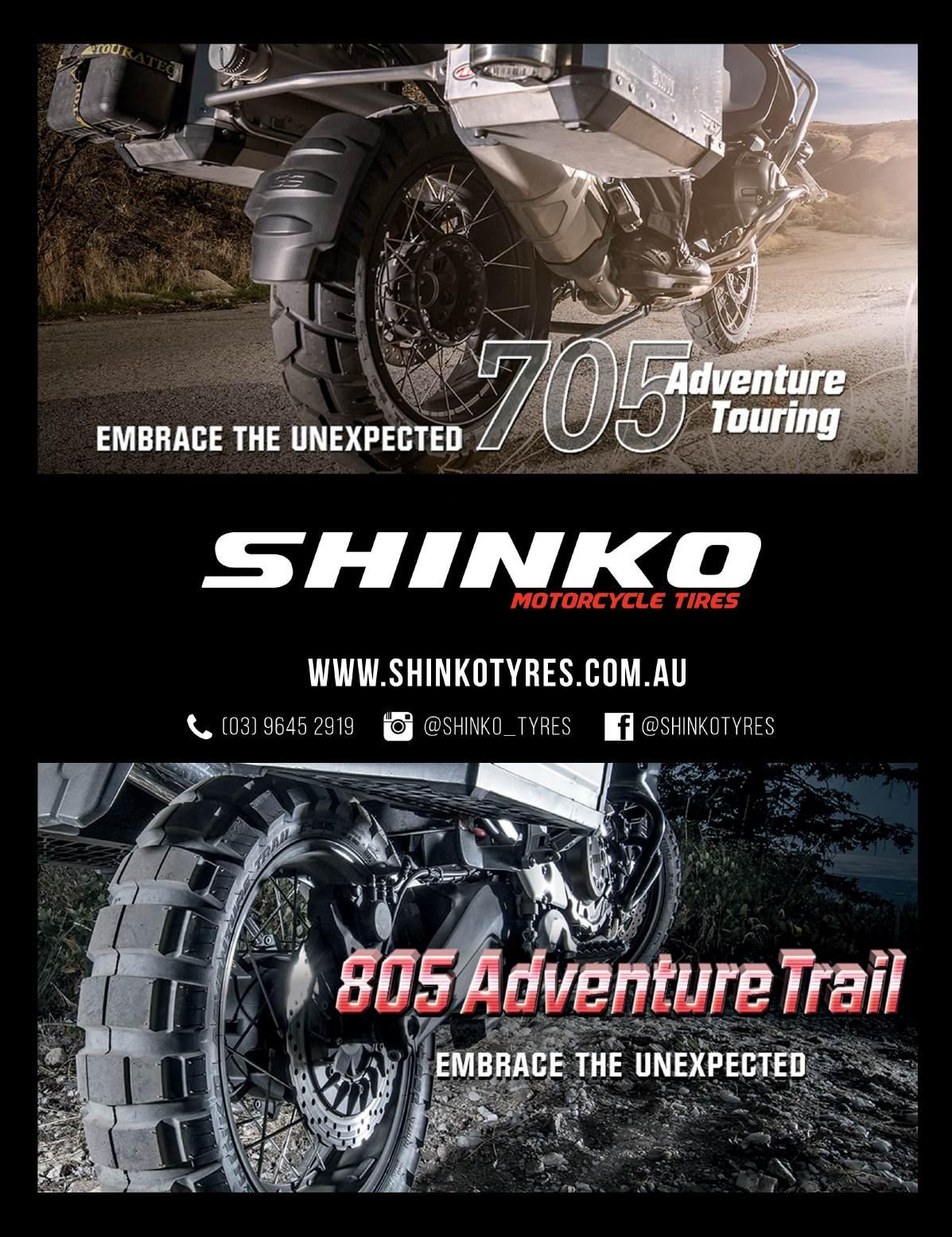
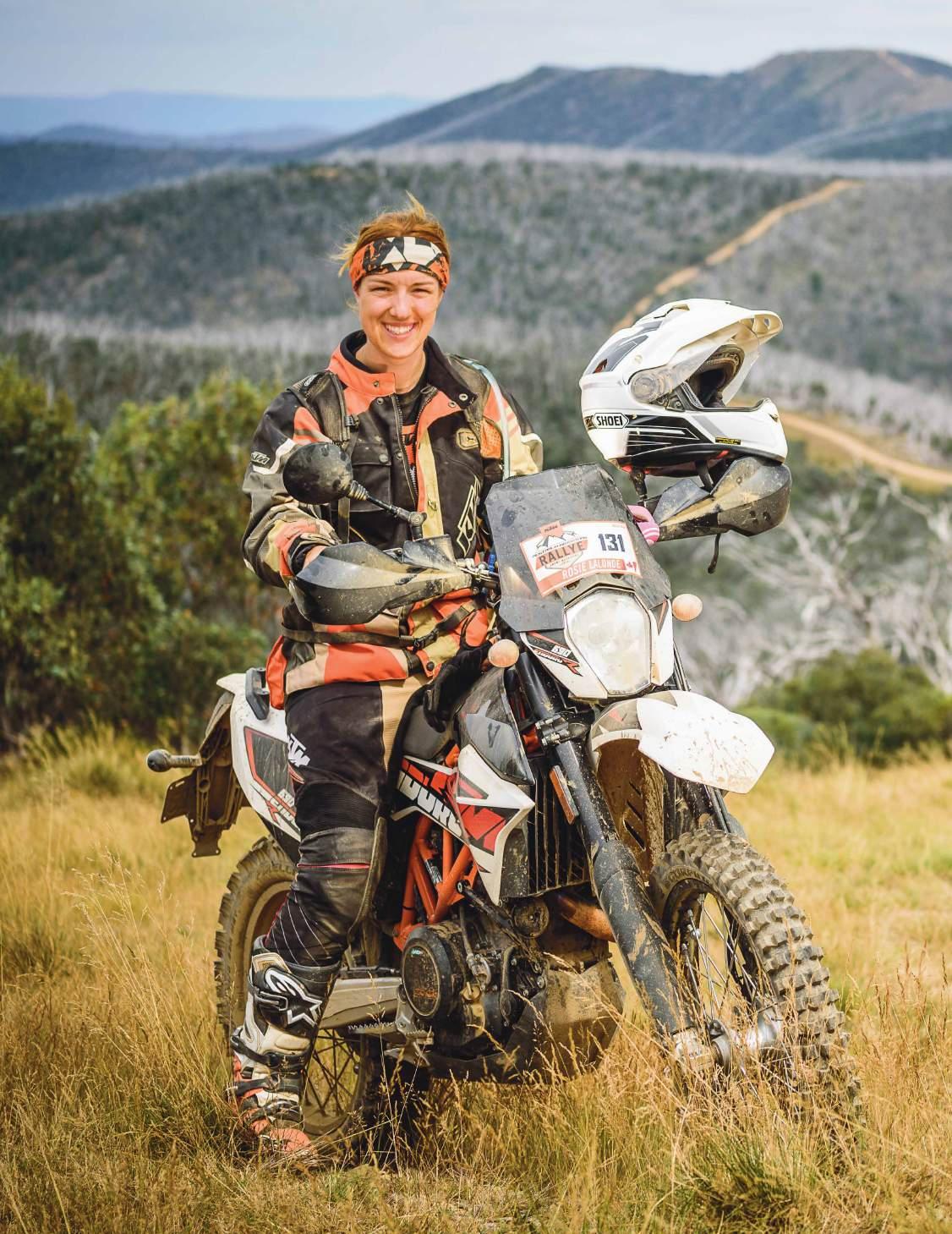
KTM Group – that’s KTM Australia, Husqvarna Australia and GasGas – has a new marketing manager. New in the role she may be, but she’s a very familiar face to riders of those brands.
At 33, Canadian rider Rosie Lalonde has been around motorcycling in Australia for quite a while.
A serious showjumper –horses – at an international level in her younger years living in Canada, Rosie’s family were all keen motorcycle riders. Her parents met racing bikes and Rosie’s sister, Leigh, made the transition from horses to bikes in her teens. A trip to the 2002 Czech Republic ISDE resulted in meeting the Australian ISDE team and the Braico family, mainstays of the Australian enduro scene.
Showjumping for Rosie progressed to the point where a capable horse would ‘cost the same as a house’, and she had some tough decisions to make.
Meanwhile, Rosie’s sister had moved to Australia and was riding and racing enduros and off-road events. After several visits, in 2004 Rosie and her parents packed up and moved here as well. Rosie had finished secondary school and started racing bikes in good ol’ Aussie.
“Going through that transition, from the horse background and into the motorcycling community, was a tough one,” remembered the irrepressibly cheerful Brisbane girl. “On top of that, I was in a completely different country and making new friends. That was a challenge.”
Rosie’s father was a Canadian trials champion and a keen ice racer, and

racing enduro had always been part of life for Rosie alongside her showjumping. When the Australian Off Road Championship kicked off in 2005 she and her sister were on the start line. She stuck with the series for the next five years or so, and also competed in the NSW enduro series and fronted –finishing on the podium in her class –a couple of A4DEs.
“The enduro scene in Australia is like a big family,” explained Rosie. “We felt very welcome.”
While the racing took up a fair percentage of Rosie’s leisure time, studying for a Bachelor of Visual Communications, majoring in graphic design, at Newcastle Uni took some commitment as well.
“My goal, right from when I first started at university, was always to combine my passions of motorcycles and design,” she said. “Back in the day I really wanted to work in a graphics company and make motorcycle graphics. In my mind that would’ve been super cool.”
After an internship at a graphicdesign company and finishing her degree, travel beckoned and Rosie travelled the world. She found herself back in Australia in 2009 and looking for work. A hand injury while working with a horse led to a move back up to her family in Brisbane for rehab, and she was in an ideal place when a Queensland-based position became available.
Rosie knew the Oliver family – owners


“It was like my dream!” she swooned.
“They took a chance on me, a fresh face just out of university.”
Over the next six years Rosie moved from marketing assistant to marketing co-ordinator, and TeamMoto itself went through some massive growth, culminating in a takeover by Motorcycle Holdings Group, Australia’s biggest motorcycle dealership network.
“My time at TeamMoto, and then Motorcycle Holdings, taught me the ways of the industry. It gave me the opportunity to combine my love of motorcycles with my growing marketing career,” she mused.
It was also around the time Rosie moved into adventure riding.
“I really embraced the adventure-riding concept,” related Rosie.
“I’d gone away from racing enduro in around 2010 or 2011. It was just becoming too difficult with a full-time job, trying to get away for the weekends and travelling. It was just too much. I still had a passion for riding, and the adventure concept of more casual fun and low pressure really appealed to me.”
The first adventure outing was on a DR650, closely followed by a move to a
u of TeamMoto Motorcycles – from her racing. When TeamMoto was looking for a marketing assistant and offered Rosie the job, she couldn’t believe it.
Main: Four hugely successful KTM Adventure Rallyes in New Zealand, four in Australia, and one Husky 701 Enduro Trek have all been the result of Rosie’s personal planning and supervision.
Left: KTM Group’s new marketing manager, Rosie Lalonde.
Above: The CR250 that she learned to ride on back in Canada, sitting on the ice of their pond.

Triumph Tiger 800. Then came the first ride on a KTM.
“It was a 690 Enduro R,” smiled Rosie with a far-away look in her eye. “I instantly fell in love.
“I’d been riding enduro on a 250EXC-F, and the KTM brand had always appealed to me. I felt there were two companies that did marketing the absolute best: Harley-Davidson and KTM. I just felt the passion and the community each of those brands had built was leaps and bounds ahead of any others.
“In my time at TeamMoto I’d worked with 10 different brands, and it really gave me the chance to see the difference in the way each brand portrayed itself. For me it was always KTM and Harley that did it the best.”
As part of her day-to-day work, Rosie had kicked off a two-day ride, the TeamMoto Adventure Rally, and discovered


a great enjoyment in putting together an experience for TeamMoto’s customers.
By this time she’d made some good friends throughout the Australian motorcycling industry, one of whom was Ray Barnes, KTM’s brand manager for Queensland.
Answer the call
“Ray Barnes called me up one day in 2015,” she remembered.
“KTM was looking for someone to run a customer-experience event like the BMW Safari, and Ray asked if I knew anyone who might suit. I told Ray I’d put on my thinking cap and hung up. About half-an-hour later I ran outside and called him back and said, ‘Ray! That sounds like me! I want to do that. I want to work for KTM.’”
It was thanks to that conversation Rosie moved to KTM as event manager, where

so many Australian KTM and Husqvarna owners would have seen and met her.
“As it turned out, my very first day with KTM was in Fiji at a dealer conference,” laughed the effervescent Rosie. “It all stemmed from Jeff Leisk’s dream to start the KTM Rallyes. He wanted to offer something special to KTM customers, and that’s why they hired me.”
So far there have been four hugely successful KTM Adventure Rallyes in New Zealand, four in Australia, and one Husky 701 Enduro Trek, all the result of Rosie’s personal planning and supervision. She was also invited to Europe to assist at, and MC, the first European KTM Adventure Rallye in northern Italy and the second in Sardinia. Rosie has even spent holidays riding two of the American KTM Rallyes.
“It was fascinating for me to see how the KTM adventure customers from all over the world are so similar,” she said. “They want to push their bikes to the limit, they want to meet new people and have an awesome time, and they want to enjoy a cold beer at the end of the day.
“It’s been really special for me to see that.”
Top left: Rosie, her sister Leigh (left), and Dad Gord at a round of the 2007 AORC.
Above: Ray Barnes, Jeff Leisk and Rosie at the “finish” of the epic 2018 KTM Australia Adventure Rallye Outback Run.
Left: Participating in the Ice Cream Relay at the New Zealand all-ladies Queens Of Dirt in 2019.
Top right: Hanging out with the A team.
Right: “I need to study and see what will potentially work for us over the next six to 12 months.”
Far right: A true adventure rider.

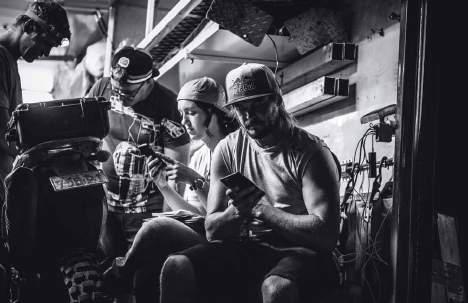
What will a new hand at the marketing helm mean for KTM, Husqvarna Motorcycles and GasGas in the future?
“We’re in such uncharted times right now,” she offered. “I need to study and see what will potentially work for us over the next six to 12 months. We need to hold steady with our brand values and stay connected with our customers. The rides, whether they’re Rallyes or Treks, are good, and maybe, potentially, might grow into more adventure-experience events.”
Rosie’s also looking for opportunities to introduce new riders to the brands using entry points like KTM’s LAMSapproved 390 Adventure.
Whatever direction KTM Group and its brands go, with Rosie steering things along everyone can expect it be a fun, polished and thoroughly enjoyable experience. It’s what she’s all about.



It’s not an easy story to tell…a couple of blokes feeling the stress of isolation needed some release. A ride was the answer.
u
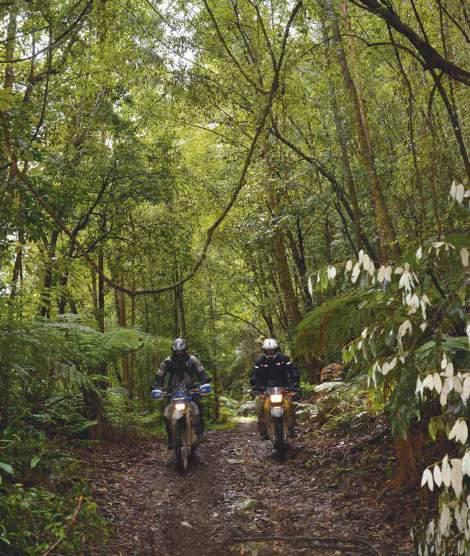
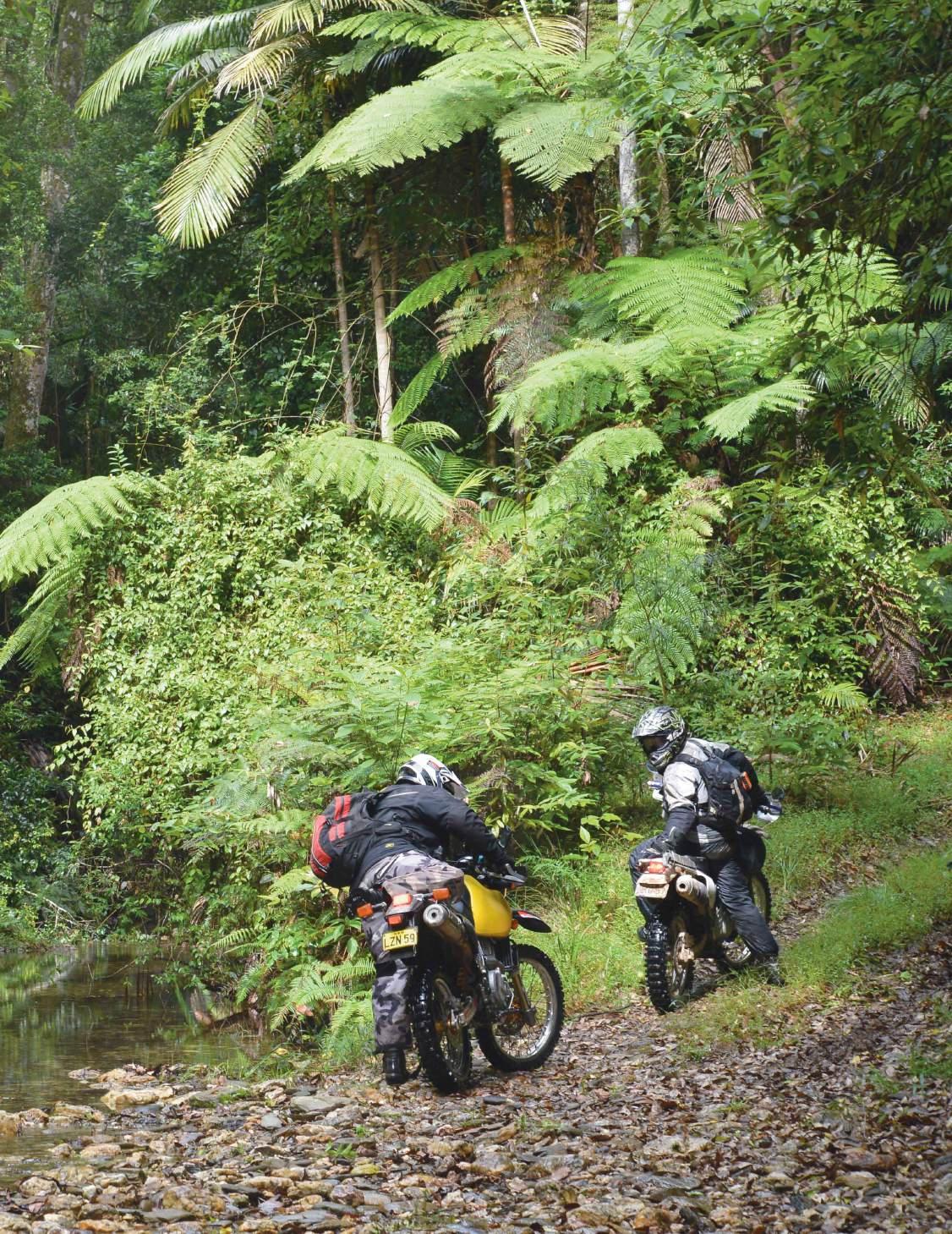
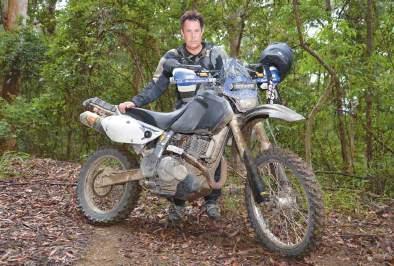
Let’s say this all happened a few months ago. Let’s say riding was being considered not in the best interests of society at the time, although it wasn’t illegal to leave home. And let’s say a couple of blokes, we’ll call ’em Craig and Marty – seeing as that’s their names – thought they were at serious risk of going postal if they didn’t get some time on their bikes.
The pair, always with the best interests of society in mind, planned a quiet day trip through some scarcely used, unpopulated subtropical rainforest. Are you jealous yet? You should be.
The pair set off on a humid and overcast morning with Marty offering to lead. He had a twinkle in his eye and his backpack made a curious clinking sound as he touched the button to fire up his DR650 and lead off into the moist, slippery forest which reached right up to his back door.
Craig followed at a safe and socially aware distance. His DR, like some kind of Swiss-army-knife bike, bristled with bush saws (two of them) and highspec equipment. Upside-down forks and the yellow gleam of an Öhlins shock reservoir gave a hint of what lay underneath.
Enquiries as to the destination had been met with a mystical stare.
“Just follow,” said Marty with a gleam in his eye. “I know a good place to visit.” So it began.
Through the slippery clay forest the boys hurtled, crossing ridges offering incredible scenery and along trails so

slimy no germ could adhere to their surface. The DRs shimmied and wobbled in the wet going and roared and swooped through the dry. The
“The boys revelled in the primordial setting. It seemed likely no human being had been there for many years.”
awesome subtropical forest at times closed in tight to the trails and at others fell back to allow the lush, long grasses to hold sway.
An interesting creek needed some

exploration and Marty threw himself in at the deep end to discover a glorious setting which deserved, and received, some minutes of quiet admiration. The water was crystal clear and the luscious trees, ferns and vines framed the creek in the distance.
Not a single human being had been sighted since departure, and as the boys revelled in the primordial setting it seemed likely no human being had been there for many years.
The stress, already greatly

Far left: Craig’s DR bristled with bush saws (two of them) and high-spec equipment.
Left: Sections had tree limbs and rocks scattered across their wet, grippy surfaces.
Bottom left: Some trails took a touch of skill to master.
Right: An interesting creek needed some exploration.
Below: In places the lush, long grasses held sway.


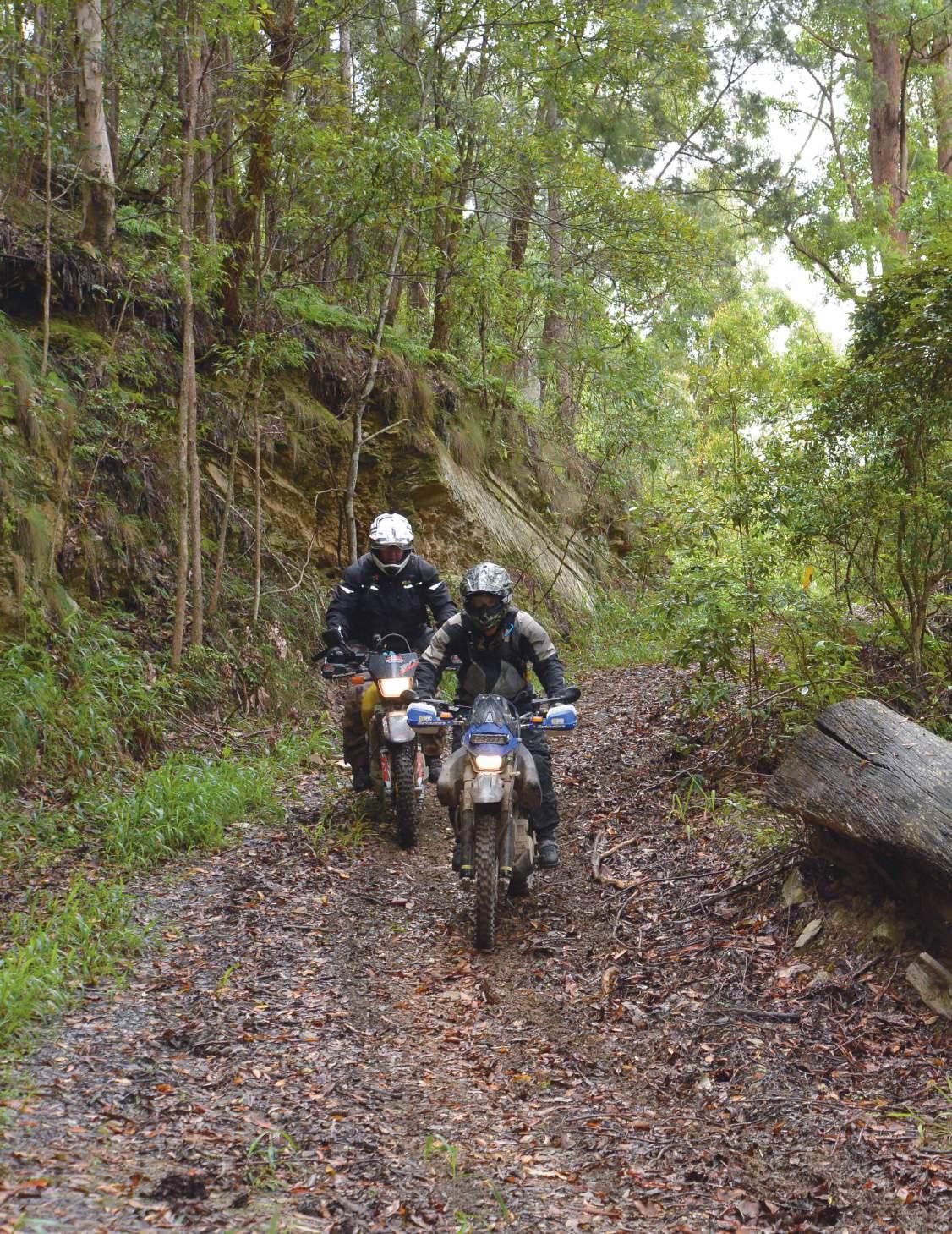
decreased in both riders, melted away as sunbeams struck down through the canopy to shed a golden light over the scene.
Although reluctant to leave such a place of serenity, the lads knew they had a task to fulfil. The destination was still a good way off.
The day continued. The trails, one after the other, could only have been put together in a dream. Some were open and fast, some needed a touch of skill to master, and some had tree limbs and rocks scattered across their wet, grippy surfaces.
Marty knew them all. So did Craig, but the destination and the promised revelation were still hidden.
A longish climb up a well-maintained and familiar fire road had the pair at an elevated ridge with awesome views in all directions. They stopped, unpacked a few snacks and a cold drink or two and lost themselves in the moment. Mist hung over the valleys, and the trees, blackened by fire a short time before, had green halos. Mother Nature showed, as she has for millennia, that no natural disaster of any kind was her equal.
The boys stayed an acceptable distance apart and thought long and hard about the state of the world and what they were seeing.
“Let’s go,” said Marty, packing his kit and ensuring nothing was left behind.
Winding down the mountainside and into the farmland below the pair increased their pace while maintaining their distance from each other. The paddocks, supporting fat, sleek cattle, flew by as the riders piloted their bikes along the hard-packed country dirt roads. A few villages came and went, but not a soul was seen.
Finally the pair rolled into Taylors Arm, and propping the bikes on the stands in front of one of Australia’s best-known landmarks, absorbed the sight before them.
“This is why we’re here,” said Marty, shrugging off his backpack and producing two distinctive, amber-coloured bottles.
The hotel in front of them was deserted.
“It’s a beer with no pub,” smiled Marty, well pleased with his quip.
The pair clinked the icy bottles together and enjoyed a quiet moment of shared solitude.
Their beer of choice?
Corona, of course.
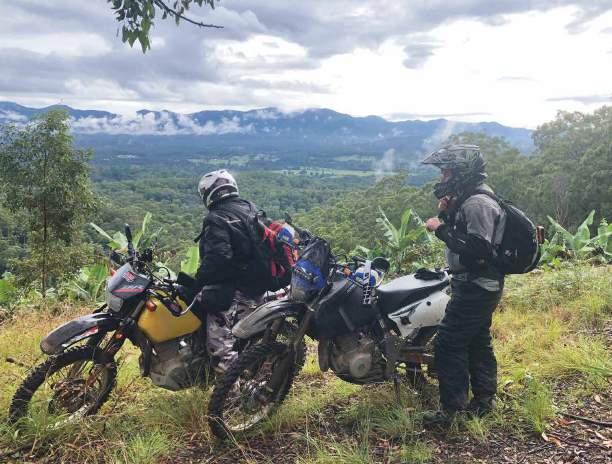
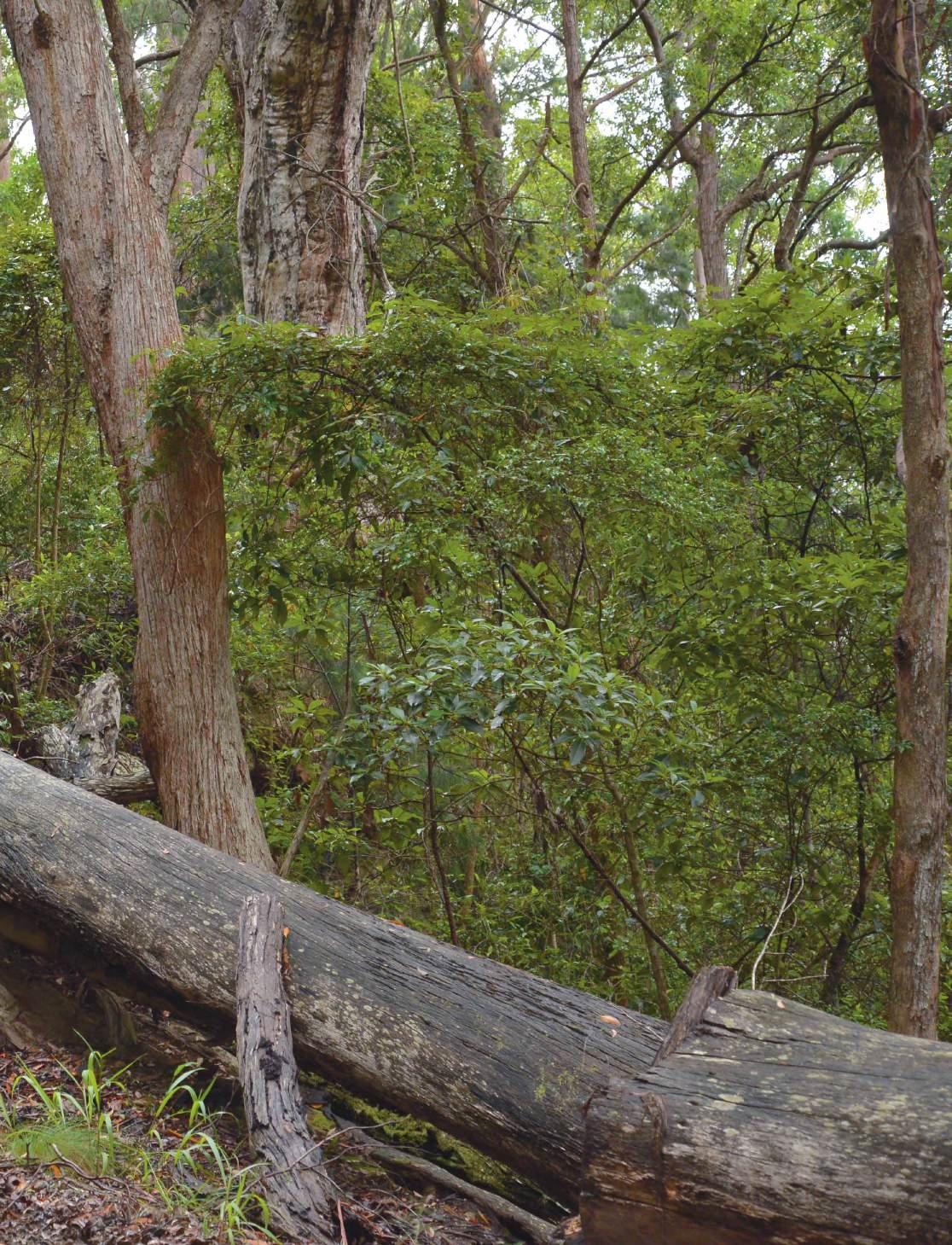



The line of ancestry from the first Africa Twin in 1988 to the bike seen here is a little tenuous. Like a few others from the 1980s and 1990s, the current bike is a relaunch of the name on a totally new bike. It’s aimed at largely the same rider and terrain as the original, but there’s a considerable time and technology gap.
The Africa Twin kicked off in 1988 as a 650cc V-twin and, typically of Honda, was just a little in front of the other ‘Dakar-inspired’ soft-roaders on sale at around that time. The name

was dropped from Honda’s line-up in the early 2000s as riders’ tastes moved elsewhere, with the final model a 750cc V-twin labelled the XRV750T.
In 2016 the model name was resurrected on the CRF1000L, a bike which, at first glance, didn’t have a lot in common with previous Africa Twins. For starters the 2016 bike was a 998cc parallel twin. But thanks to some clever marketing from Honda and the high regard for previous Africa Twins, it was snapped up almost as soon as bikes hit dealer floors.
u
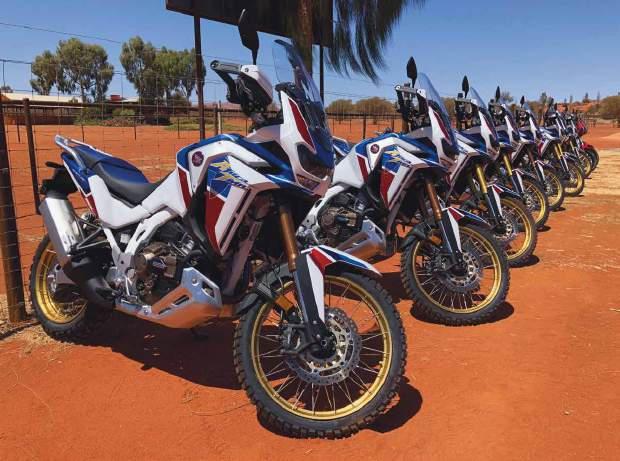
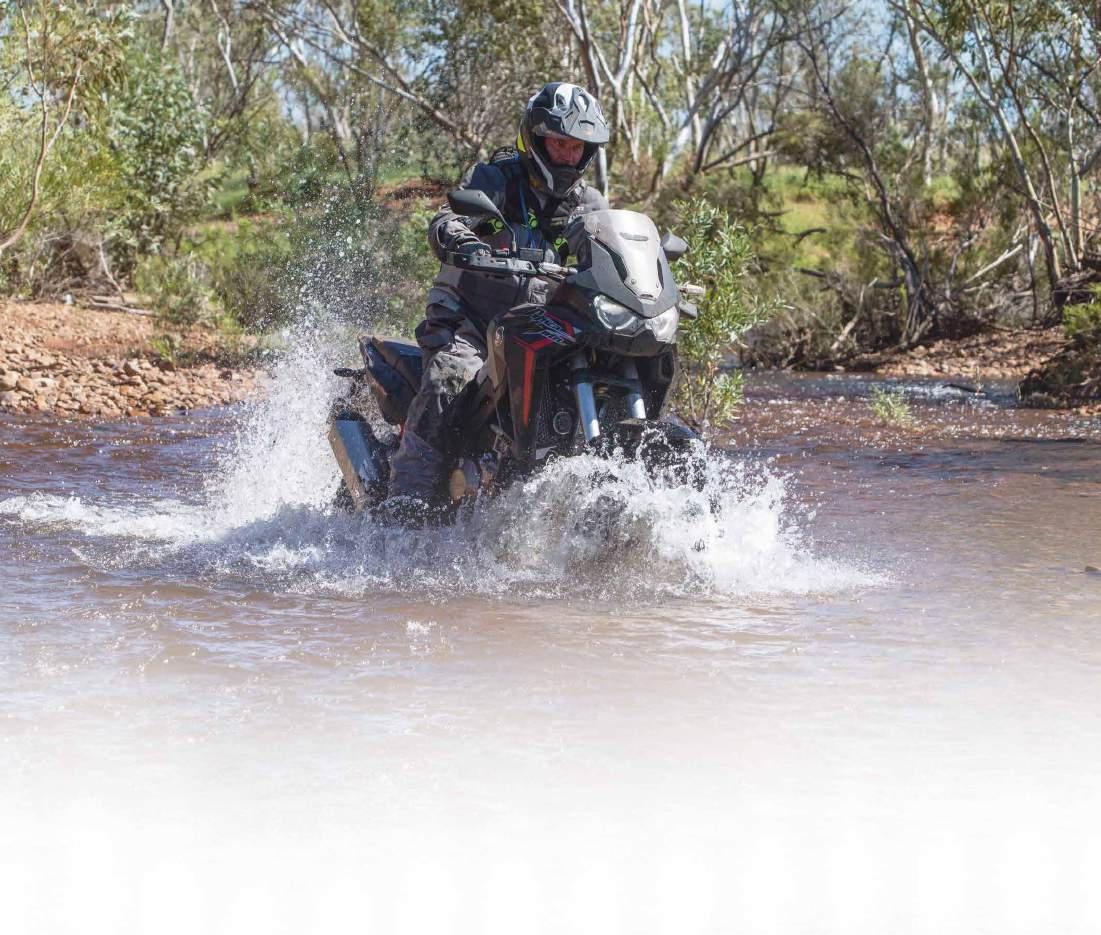
The CRF1000L was offered in three variations: a standard model, an ABS model and a DCT model.
The standard model was a fuel-injected parallel twin with a 270-degree firing order which kept the V-twin feeling in mind, and no electronic rider aids. The ABS model was the same bike with, predictably, ABS. The Dual Clutch Transmission (DCT) model was the eye-opener, offering what amounted to an automatic gearbox. A touch of a button engaged ‘drive’, and from there all the rider had to think about was staying upright. Gear selection could also be done manually via the left switchblock, and like an auto car, there was no manual clutch.
Some people loved the DCT and some didn’t, but Honda stuck with it, and individual rider preferences aside, there’s no doubt the DCT system works well.
The 2020 model lineup of Africa Twins no longer includes a non-ABS model, and Honda says there’s now two to choose from: the CRF1100L, and the CRF1100L Adventure Sports. We feel like the DCT bike makes for a third choice, but it’s considered an option on the Adventure Sports model.
Probably the biggest feature of note on the 2020 models is the motor. The 1084cc parallel twin is 86cc bigger than last
year’s and is Euro 5-compliant. Emissions controls always seem to be about to stifle motorcycles out of business, but Honda’s motor meets what are currently the toughest emissions standards on the planet in a package that’s slimmer, has a 10-per-cent improvement in power-toweight ratio from the previous CRF1000L and offers more torque.
The frame is lighter than the previous model as well, and there’s a suite of electronics that’ll sit the Honda right alongside the other big-money, big-bore adventure tourers. Six modes, including two rider modes, are there for fiddling with, and a six-axis inertial measurement unit (IMU) measures and shapes things like traction control, wheelie control, cornering ABS and rear-lift control. The rider makes selections via the left-hand switchblock and gets the state of play from a 16.5cm TFT display. Cruise control is standard on both models, cornering lights on the Adventure Sports arc up when the bike’s going around a turn, and for the up-spec model there’s electronic suspension available. Honda calls it Electronically Equipped Ride Adjustment (EERA).
We’ll just call it ‘electronic suspension’.
There are a couple of tech features we found interesting. They’re small in the scheme of things, but we thought they
were intriguing and the kind of detail Honda’s always done well.
The first is an exhaust control valve that essentially routes the exhaust gasses through a smaller outlet in the muffler at low revs, then opens to let the gasses escape through an additional larger outlet at higher revs. It’s a simple mechanical valve activated by the ECU, and the same set up as used on the arse-tearing new CBR1000RR. It’s a great concept. The bike sounds meek and mild at idle and horn with the throttle cracked open.
The other tech change which caught our eye was the throttle-body butterfly gears being moved to allow a straighter induction path into the combustion chambers. That seems like some good old-school thinking in a modern setting. The throttle bodies are two millimetres larger this year and the cylinder sleeves are now aluminium.
Standard suspension is fully adjustable Showa front and rear. The front sports 45mm USDs and the rear good ol’ ProLink. The shock on the conventionally suspended bikes has a decent-sized adjuster for preload which was easy to tweak.
The big news for most potential buyers will be the optional electronic suspension available on the Adventure Sports model. Like other electronic suspension units
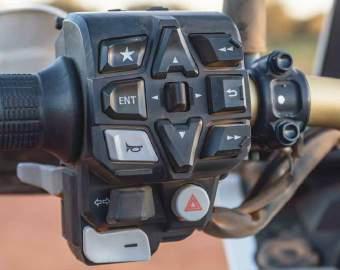
Left: The Africa twin handles its weight really well, especially in technical and tricky situations. Above: Not as complex as it first appears, but still takes some getting used to. Backlighting the switches would’ve been good for night riding. Right: An LCD panel underneath the TFT screen shows speed, gear selection, an odometer and a handful of warning lights. Note the little ledge over the TFT display. It was brilliant.
we’ve tried, it does have a definite ‘feel’. Adjustments are made in near real time –15 milliseconds – and we’re not going to even try and explain the technology (we couldn’t if we wanted to). Once the rider

gets the thing set it’s just a matter of riding and letting the bike do the rest. There was some experimenting with shock preload selection and it was found to have a very noticeable effect on suspension performance overall, so don’t just accept the offered ‘rider only’ settings. Try out the pillion and other settings, even for a solo rider. It’s worth some trial and error to find what will work best. Another thing to keep in mind with
the electronic suspension is it adds some heft. The standard Africa Twin, measured at the brochure, comes in at 226kg. The electronic suspension model is 250kg.
It’s all very well for us to say, “Mess about with it and see what works,” but first the rider has to come to grips with the menu and what the TFT display is trying to say. Learning new menu systems and

display readings every time we ride a new bike is getting challenging, but has to be done.
The Honda system is mostly straightforward enough. The left switchblock is laid out with what looks to be an impossible array of buttons and switches, especially on the DCT model, but which actually is fairly sensible once it’s been explained six or seven times. The gearselection levers add a bit of initial extra confusion to the DCT model, and the Apple CarPlay buttons – standard on all the bikes – do a bit as well, but once they’re sorted things become mostly fairly clear.
The panel which matters most is the section with the up/down arrows and the enter button. That’s the section which gets the most attention for regular riding. It gives access to the six rider modes –Tour, Urban, Gravel, Off-road, User 1 and User 2 – and allows adjustment of various parameters within those modes…where parameters are adjustable. The graphics which accompany the settings need to be learned as well, and we’re still confused about whether a quarter of the circle in blue means maximum or minimum intervention. Traction control (HSTC) and wheelie control can be adjusted on the fly in all modes. There’s a rear-wheel lift control as well, so there’ll be no Jack Miller impersonations on this bike, thank you very much (it can be adjusted too, of course).
The little paddle in the middle also moves a display panel
across to show adjustable parameters for different performance facets.
We’re not going to spend pages trying to explain selection and tuning of the modes. If you’re keen, go to a dealer and get a demonstration. It’s a lot easier when you can watch it happen.
The DCT model also has a button to activate a sort of slipping-clutch arrangement. When the bike’s being urged forward on a loose surface, instead of the rear wheel instantly responding to the throttle it feels as though the clutch slips and allows a more gentle application of power.
We can’t remember which one of the buttons it was, though.
It was one of them. And it was good.
There’s quite a marked difference between the Standard and Adventure Sports models. To try and keep things moving along, we’ll aim for a summary.
The CRF1100L has:
R Plastic handguards
R An 18.8-litre tank
R Tubed tyres
R A low, fixed screen
R Lightweight bashplate, AND
R Weighs 226kg.
The Adventure Sports model has:
R Larger handguards
R A 24.8-litre tank
R Tubeless tyres
R Optional electronic suspension and/ or DCT
R Heated grips and 12-volt socket
R Five-position tall screen
R Three-stage cornering lights, AND
R Weighs 238kg (with manual transmission and mechanical suspension). Naturally there’s a stack of accessories available for both. Panniers, top boxes, tankbags, quickshifter, a footpedal gear selector for the DCT, handguards, crash bars…all kinds of stuff. An owner could do a very substantial fit out using the OEM accessories on offer.
Considering the new Africa Twin is near enough an 1100 it feels remarkably compact. It’s one of those bikes that carries its weight well, so although it’s a fair chunk to push around in the Northern Territory sand, it’s easy to forget the mass when the bike’s in motion. The motor’s quite narrow and the seating position is open and relaxed. The bike also didn’t feel tall, and we’re grateful every time we get on a big bike and can get our feet on the ground. Thanks, Honda!
The most daunting thing for a rider mounting the Africa Twin for the first time is the amount of switching on the ’bars, and then, once the key is turned, the sheer information overload from the


Left: We had such a good time on the standard bike we didn’t give much thought to tuning or adjusting anything.
Above: A bigger motor with more torque, Euro 5 compliant, yet still weighing less than the CRF1000L motor. Power delivery is smooth and very easy to use.
‘Multi Information Display’ – the TFT screen.
There’s also an LCD panel underneath the TFT screen which shows speed, gear selection, an odometer and a handful of warning lights.
Ye gods!
The LCD panel is very conventional and makes it easy for Honda newbies to get basic information fast and with no fuss.
As with all new bikes, once we’d settled in to the menu and display it mostly made sense, although this TFT display on its own does seem to offer a few too many options for someone who just wants to go for a ride. The information available, if you know where to look, is mind-boggling. But the display itself has different levels – gold, silver and bronze – which show different amounts of information. Gold displays heaps. All kinds of things we’d never even think of asking for are there, or are available, and it’s just a tad wild.
Silver, predictably, shows a little less info, and bronze, of course, shows just the basic stuff. We thought we were bronzies for sure, but once we’d been on the bike a while we kept thinking there were some things we wanted to see, so clearly it’s a matter of becoming familiar with what’s available and making the right selection. By the end of our ride we were hard’n’fast goldies in all modes.
And while we’re thinking about the switching, Honda went to some lengths to ensure we could experience the cornering lights. The lights worked well, but being out in the dark also showed up the switching being very difficult to use at night. The switches aren’t backlit, so black switches on black switchblocks at night, on a bike so heavily reliant on electronics… it was one of very few things we think Honda may have misjudged on the big CRF.
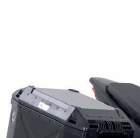
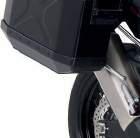
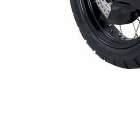


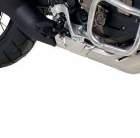




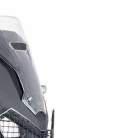

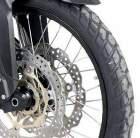

























We started our riding on the Adventure Sports with mechanical suspension. It’s a gorgeous, tricolour beastie with a beautiful finish and a very high level of comfort. We plugged the phone into the USB port as instructed, but then became engrossed in the bike and the scenery – a lap around Uluru in the late afternoon –and ended up never actually activating Apple CarPlay.
Instead we grabbed a handful of the lightish clutch, snicked the big girl into gear and revelled in the restrained growl of the motor and the very comfortable, upright seating position. Honda claims 100hp from the new motor and the power comes on nicely. We hadn’t ridden an Africa Twin for a long time, but there were plenty of comments from other riders about how the motor was much torquier than the old 1000. It definitely pulled nicely from low revs, and it’s not a motor that particularly needs to be revved hard – although we were impressed with how it worked high in the rev range. It’s smooth, sounds tough and was a pleasure to use.
The tank on the Adventure Sports feels wide at the front, no doubt about it. It doesn’t interfere with riding the bike until it’s time to stand up and get forward, but it’s noticeable in the corner of each eye. Gear changes were very smooth and easy and, in general, the rider was well protected from windblast. We first thought that was courtesy of the tall screen which could be adjusted for height just by grabbing the clips on either side
and sliding it up or down.
The ’pegs have rubber inserts which came in for a lot of unkind comment over the few days of hammering along some rough roads, and quite a few were removed. We chucked ours early in case of river crossings, so we didn’t get the sore feet other riders complained about. River crossings? In the Red Centre?
After spending a day or so on the Adventure Sports we changed over to the ‘standard’ bike and were surprised at the difference.
The Adventure Sports is heavier than the standard bike, and we should’ve expected it, but when we hit rough going the standard bike was quite a bit livelier than its heavier sibling. It shook its head a little in fast going on rocky roads and kicked its heels up over sharp edges and corrugations. It was a lot of fun to ride fast. In the sand a rider’s body position had more influence, and in anything a little technical or gnarly, the standard bike was easier to move around. It was easier to change direction in deep sand or at speed, too.
Conversely, of course, the Adventure Sports was better at holding a line in deep sand and needed less attention from the rider at speed.
We didn’t do any suspension tuning, and that could’ve made a big difference, but that doesn’t change the feeling of the standard bike being lighter and narrower
around the front of the tank. We have to be honest, we were having such a good time on the standard bike we didn’t give much thought to tuning or adjusting anything. Most of our time was spent trying to walk the fine line between fanging about like lunatics and showing proper courtesy to our fellow riders.
Aside from that, there wasn’t much to talk about between the two. Performance from the drive trains seemed pretty much the same to us, although we felt the standard bike may have accelerated a little quicker. We’re perfectly prepared to accept that was a perception brought on by the lighter feel of the bike rather than a reality, but whether it was the case or not, we felt the standard bike was a touch more playful and fun to muscle around.
One very big difference between the two models, believe it or not, is the windscreen.
The Adventure Sports has a biggish screen which can be adjusted up and down. The standard bike has a short arrangement which finishes nearly level with the top of the TFT display. The big screen was a pain in backside when it got dusty and fairly substantially obscured the rider’s view of the terrain. The short
All the different model variations coped well. Photographer Damien Ashenhurst lined ’em up for more time in the rocks. u

Honda didn’t mollycoddle the bikes. They copped a hammering.
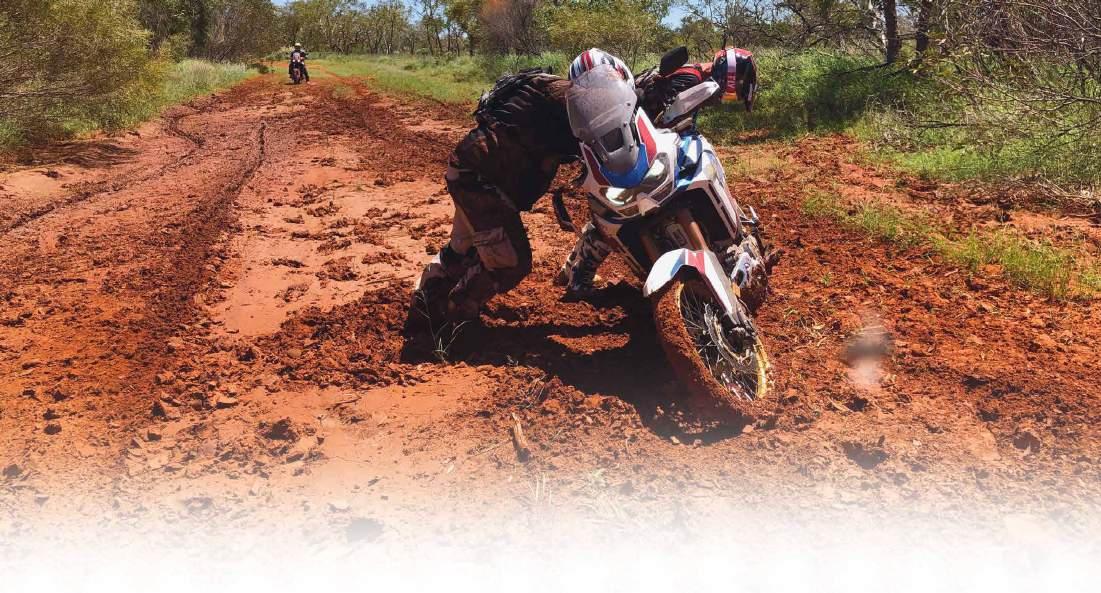
screen seemed to keep just as much wind off the rider, both on and off road, and didn’t get in the way at all.
So that was interesting.
Also, one of the bikes had a little ledge arrangement over the TFT screen which was brilliant for keeping the glare off it and making it super easy to read. We didn’t have any problem reading the TFT display even in direct sunlight, but that little overhang was a very nice touch.
We haven’t said any more about the
electronic suspension, but we’re still a little unsure how we feel about it. It worked fine, it added some weight to the bike, and it made adjustments for things like pillions and luggage really easy. The system even reads when the bike’s in the air and adjusts for a hard landing. It’s quite incredible.
But did we prefer it to properly set up mechanical suspension?
Probably not.
The thing we keep coming back to there is, so few riders make the effort to get their suspension sorted. If paying a
We’re being a little mischievous with the name of the panel. It’s actually the G switch we wanted to talk about. Apparently there’s something funny about a G spot and everyone in the office snickers when we say it, so we thought it would be a good way to introduce this section
In the copy we mentioned a ‘slipping-clutch arrangement’ on the DCT bike.
The correct name is the G switch. It’s activated from the touch screen on the TFT display and, to quote Honda’s tech material:
‘The G switch can change the engine characteristics of your vehicle to help improve traction and machine control for offroad riding by reducing the amount of clutch slip during throttle operation.
v Other than USER 1 and USER 2 MODE: Each time the ignition switch is turned to the ‘On’ position, the G switch will automatically be set to default setting.
USER 1 and USER 2 MODE: The G switch setting will be maintained even if the ignition switch is turned to the off position.
v The G switch may not compensate for rough road conditions. Always consider road and weather conditions, as well as your skills and condition, when applying the throttle.’
tuner, or learning to sort suspension yourself, isn’t going to happen, the electronic suspension is a gift. Just select the parameters from the menu that suit and she’ll be right. It might not be as good as it can possibly be, but it’ll be pretty damn good for most situations, and that’s more than most riders will get from any other kind of stock suspension unless they have it set up by someone who knows what they’re doing.
DCT will be a talking point for a long time to come. Performance of the auto gearbox on this ride was exceptional.


Recommended retail (including GST + on-roads):
Standard $19,990. Adventure Sports (manual transmission) $23,499. Adventure Sports (DCT) $24,499. Adventure Sports (EERA) $26,499
Web: motorcycles.honda.com.au
Engine type: Liquid cooled, SOHC, eight-valve, four-stroke, parallel-twin
Displacement: 1084cc
Bore x stroke: 92mm x 81.5mm
Compression ratio: 10:1
Maximum power: 75kW (100hp) @ 7500rpm
Maximum torque: 105Nm @ 6250rpm
Carburation: PGM-FI electronic fuel injection
Starter system: Electric
Transmission system: Standard/Adventure Sports – six-speed manual.
Adventure Sports DCT – six-speed auto DCT
Final drive: Chain
Front suspension system: Inverted fork
Front-axle travel: 204mm
Rear suspension system: ProLink
Rear-axle travel: 220mm
Front brake: 310mm dual wave floating discs with aluminium hub and radial-mounted four-piston Nissin calipers
Rear brake: 256mm wave hydraulic disc. Single piston Nissin caliper
Front tyre: 90/90-21
Rear tyre: 150/70-18
Length: 2330mm
Width: 960mm
Height: Standard 1395mm, Adventure Sports 1560mm (1620mm with high screen)
Seat height: Standard position 870mm. Low position 850mm
Wheelbase: 1575mm
Ground clearance: 250mm
Kerb weight: Standard 226kg. Adventure Sports 238kg. DCT 248kg. DCT EERA 250kg
Fuel capacity: Standard 18.8 litres. Adventure Sports 24.8 litres
Service intervals: After first service, engine oil every 8000km and valve clearances every 16,000km
Colours: Standard bike – Matte Ballistic Black Metallic and Grand Prix Red.
Adventure Sports – Pearl Glare White Tricolour
Warranty: 24 months
No matter how rough the terrain or deep the sand, the DCT worked in the rider’s favour. Every time.
It has a few settings of its own, and again, the right setting at the right time can make a good ride a great ride, but there’ll still be plenty who prefer a standard clutch and gearbox.
Don’t jump to conclusions, though. Give it a try before you make up your mind. You might be surprised.
Adventure Rider Magazine tips its hat to Honda Australia for not being protective of its bikes. This three-day ride from Uluru to Alice Springs in the Northern Territory covered some serious terrain, and lots of it. Over the three days the bikes were hammered through something approaching 2000km of bitumen, rock, sand, a couple of little creek crossings, and some long, rough, shitty sections that were all of the above. We even went for a short blast on the Finke Desert Race track. If anything was going to fail on any of those dozen or so bikes it would’ve failed under that kind of treatment from riders who weren’t all that concerned about looking after them.
Nothing failed. The bikes coped with all of it, and coped well. We were especially – and pleasantly – surprised at how well all the model variations coped with the dunes.
And while they proved themselves tough, the first day had over 800km of bitumen and the comfort level was amazing.
The CRF1100 Africa Twin is a first-class, big-bore adventurebike option.




Plan A started in October when I purchased a new KTM 690 Enduro R and had it fitted up with good gear from Barrett’s, B&B and so on. What could be a better test than a run through the dirt tracks of the Victorian and NSW high country in, say, January?
But first there was the small matter of a November Compass Expeditions ride down Chile’s Caraterra Austral to enjoy.
A fine ride it was too, until an oncoming truck and I decided we wanted to share the same piece of gravel on the apex of a blind corner. I’ve always believed in light adventure bikes, and the pain of an 800GSA using me to cushion its fall did nothing to change my opinion.
Hey, it was only a broken fibula. It was easy to deny because I could still walk and ride… at least until I got home to see my friendly orthopaedic surgeon.
At the time I thought Plan A was still a possibility, but it wasn’t to be.
Plan B was hatched after the summer heat had died down and my leg healed.
The plan consisted of a run up to Mungo, Menindee, Cameron Corner, Innaminka and home through the Flinders. I thought late March would be good.
But every story has a twist, hence Plan C emerged when a friend mentioned he was heading to Lake Gairdner to take in the drylake racing.
‘Easy,’ I reasoned. ‘If I head to Lake Gairdner first I can simply ride my original route in reverse and take in some great racing on the way’.
But a week before the event the organisers bravely but wisely pulled the pin when the early signs of the Covid 19 threat began to emerge.
Plan D evolved – and I use the term after consideration given the viral climate – out of a sense of stubbornness and naivety. It was the
In 1785 Robert Burns composed the poem To A Mouse in which he penned the words ‘the best-laid plans of mice and men often go awry’. Don Bromfield is no poet, but his best-laid plans still went awry.
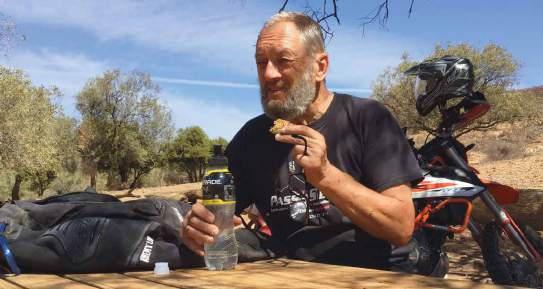
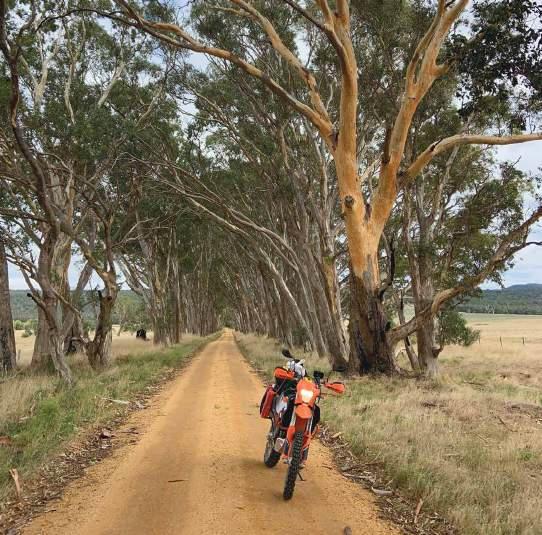

early days before the full reality of the effect Covid 19 was to have on all our futures. The plan was to head to Adelaide and then into the Flinders, Innaminka, Cameron Corner and home via Mungo if my nine-day window allowed. What could go wrong?
Riding a KTM on the Western Highway into South Australia was hardly riveting adventure, but I would be remiss not to recommend the free camping at the lake

at Bordertown. After a night in Adelaide where some idiot stole my el-cheapo wet-weather onesie – why would anyone bother? – it was off to Yunta for the start of the adventure ride.
Plan D had me riding the Tea Tree Road north to Arkaroola. Most of my adventure riding had taken place overseas on the bitumen, hard-pack gravel or loose pebbles of Europe and North and South America, so this was to be my introduction to outback adventure riding. At 66 I decided it was high time I started seeing my own backyard. And anyway, the bulldust couldn’t be that hard, could it?
All went well on the run to Waukaringa. A bullet-ridden truck body with a rusty engine block laying in the dirt, accompanied by the roofless, decaying, yellow clay walls of an early settlers,
cottage, held my interest as I wandered around looking for that special spot to frame my photo. Further on the ruts from mining trucks, filled with bulldust, may not have introduced me to my maker, but they certainly tested my resolve to keep the power on and the weight back as the Kato bucked and wobbled up the road. I was learning.
Outback travel is renowned for heat and flies, and this part of the trip certainly didn’t disappoint in that department. What surprised me was the lack of traffic. Two trucks in 300km was a harbinger of times to come as Covid 19 began to force people to stay home.
Road warnings towards Innaminka, solo travel, 35-degree heat and the lack of traffic had me considering if it was wise to head further north. I decided on a rest day at Arkaroola for the opportunity to
u


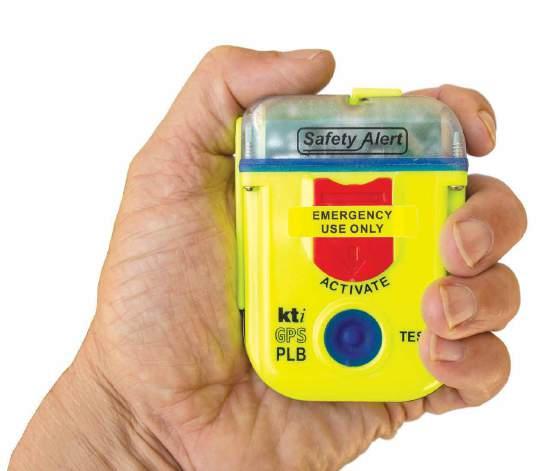
ride to some of the nearby sites and further contemplate Plan E.
A chance meeting with an Aboriginal ranger servicing the stone-and-iron Nudlamutana Hut led to a pleasant conversation about the history of the area and the bush tucker available. Bush banana flowers eaten straight off the tree resulted. The windmill with its spinning galvanised blades perched atop the spindly framework servicing the hut appeared a poignant reminder of past meeting present. That was until she pointed out that the two solar panels mounted at its base were really doing the work. WHS precluded climbing the tower for service work, but at least it looked the part.
The rest of my day was spent poking in and out of the remote, red, ironstone trails and sandy, dry creek crossings of the Gammon Range. The lack of tourists was evident both on the ride and back at Arkaroola Village, where only five people were camped in the unpowered area. The flies there were horrific and drank straight Aerogard with abandon. Apparently the prolonged drought and subsequent destocking of the grazing country meant they’d all come to hang out at the popular tourist spots. Plan E swept onto the scene that
evening when my daughter WhatsApped me that South Australia was to close its borders in two days’ time. While aware the situation was deteriorating, the remote location tended to cushion one from the harsh realities being faced in more-populous areas. Maps.me indicated the closest crossing into Victoria was at Renmark, so Plan E became a long day’s ride to Berri and then to see how the Victorian government was dealing with the border closures.
An 800km day on a Kato 690? No worries. It’s an adventure.
The early-morning start saw me catch the long shadows on the harsh, red, raw landscape in the drought-parched Gammon Range on the run to Copley. I shared the dusty road with one car as we leapfrogged, taking photos, on the 120km to the bitumen.
The Kato has a 13-litre tank, which was good for 300km at a leisurely pace, so I reasoned I could make it to Parachilna. Well…five kilometres was close.
After unpacking and a splash from the Rotopax it was into town where I discovered there was no servo.
After unpacking again and emptying the Roto into the tank it was off on the great gravel run through the Heysen Range to Blinman. There I was provided
my first experience of the takeaway Covid regime as the lady in the cafe explained the new protocols that had come in that morning. The potential of the harsh impact of the virus on the small businesses and towns of the outback was just beginning to emerge.
From Blinman I headed south on deserted roads through the Flinders on to Berri on the banks of the Murray for the night. It had been a long day, but the Kato seat proved either surprisingly liveable or my bum was fatter than I thought.
The following day I decided to head south to Naracoorte and over the border past Arapiles and into The Grampians. The curving, winding, climbing-andfalling track into Halls Gap and the town itself were surprisingly quiet. There were more kangaroos in the main street than tourists.
As dusk slowly fell I was left to share the peaceful solitude of Boreang campsite with only the kangaroos and possums. Adventure riding provided the ideal Covid isolation solution.
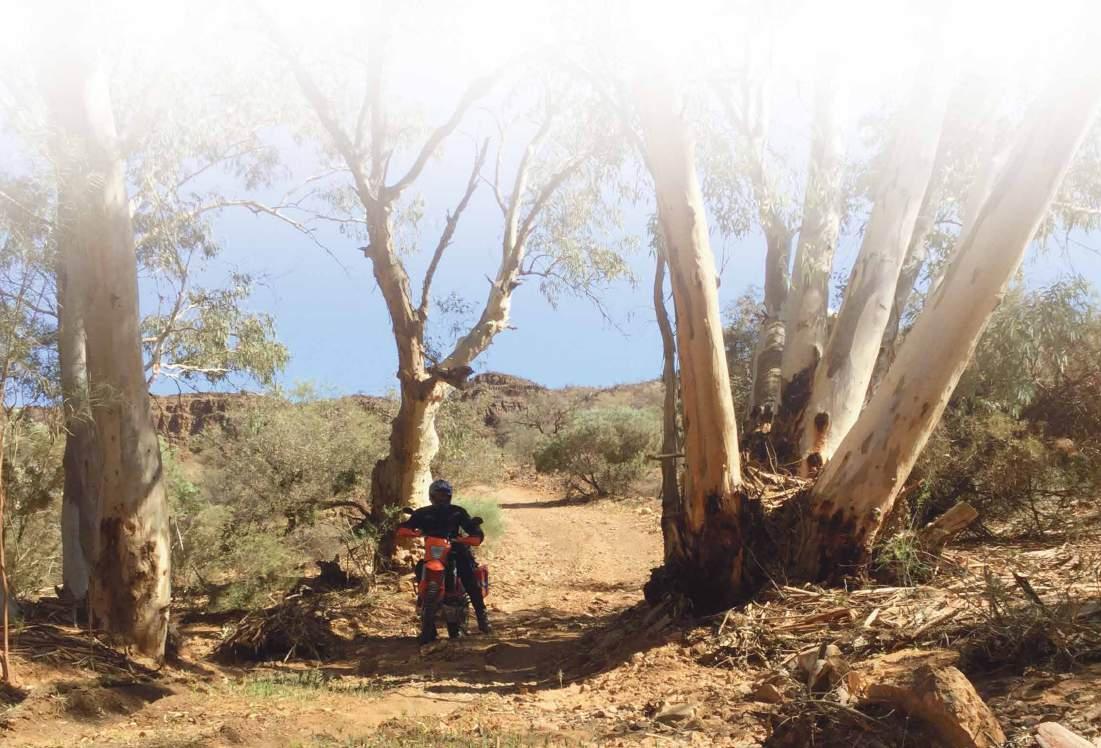
The Grampians were new territory for me, so I decided to meander via the back roads through the spectacular rocky mountain bluffs and forest scenery. Avoiding the occasional ’roo on the Glenelg River Road, Sera Road
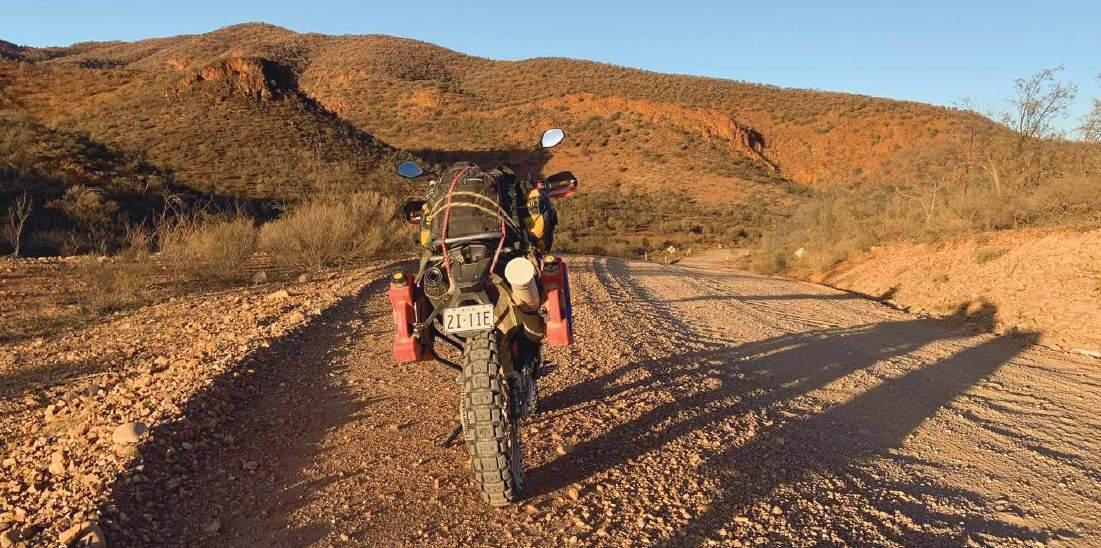
and Jimmys Creek Road, I finally exited onto the farming country west of Mafeking for the run to Dunkeld via Yarram Gap.
It was all good fun and great adventure riding on well-maintained dirt roads.
That night, in an eerily quiet Warnambool, the next twist in Plan E emerged when I learned all campgrounds were about to be closed. There went my
plan to camp at Stevenson Falls in the Otways the next night.
So Plan-whatever-we-are-up-tonow saw me book into a motel in Lorne instead.
After Warrnambool I wasn’t surprised by the lack of traffic and tourists as I cruised past the now-closed scenic spots of the Great Ocean Road. One could only visit the toilet block at The Twelve Apostles because all else was enclosed by barricades.
Delaneys Road and Erskine Falls Road.
A very quiet night followed in Lorne before I finally headed home after another taste of Otway forests along Wye Road and Benwerrin-Mt Sabine Road.
Below

I turned left at Lavers Hill and headed along the rainforest twists and turns on my way past Beech Forest and the run towards Lorne on the forested dirt of
The prescience of Robert Burns’ words all those years ago have certainly been brought home to us all over the past few months. I’m grateful I was able to adapt my best-laid plans and managed to squeeze in one last ride before the impact of Covid 19, social distancing and lockdowns reached their peak. Burns’ simple poem also contains the line: ‘I’m truly sorry Man’s dominion has broken Nature’s social union’.
Perhaps that, with the earlier quote, are the real lesson for us all.



There’s more to a drive chain than links and pins. Link International’s Product Manager for RK Chains, Dennis Turchet, talks us through some of the finer points of motorcycle drive chains.
Before we talk about drive chains and choosing the correct chain for your bike, let’s lay to rest a few myths:
* Chains stretch – myth
* O-ring-type chains don’t require lubricating – myth
* Quality chains break because they’re faulty – this is misinformation.
That last one may be a bit hard for some people to swallow, but it’s human nature to blame a product rather than their lack of knowledge of the product’s intended application and use.
One must first comprehend a drive chain isn’t just ‘a
chain’. It’s not a single piece of equipment, but a combination of individual components, and depending on the make and type of chain, there can be outer plates, inner plates, pins, bushes, rollers and sealing rings.
All of these individual parts are made from varying metals and materials in different sizes and thicknesses, which, when combined, determine a chain’s size, pitch, flexibility, strength, and longevity.
You might ask, “What do you mean, drive chains don’t stretch? Why then, after some use, does the chain start to sag and it needs adjusting?”
It’s all caused by wear, and wear is caused by two or more surfaces rubbing together.
In a drive chain most of the wear is between the

pins, bushes and rollers. As these components start to wear the rollers will no longer run true to centre, which causes a slight change in the pitch, in turn causing it not to mesh with the sprockets correctly. That phenomenon will start to wear out the sprocket.
It starts to look and feel as if the chain is stretching, but in fact what you have is a bunch of worn parts. By this definition we say a chain ‘wears out’. It doesn’t ‘stretch out’.
RK Factory uses only the best-quality Japanese steel and materials to manufacture its chains, and that means the wear life of RK chains is much longer than other chains which may have been made with lesser-quality steel and materials.
Once we understand how a chain wears out, we can start to look at how to reduce

friction between those moving parts and prolonging the life of the chain.
Fortunately, manufacturers of quality chain, like RK, are on our side and put enormous amounts of research and development into their products, constantly coming up with ways to increase durability and strength while lessening friction.
The main reasons a chain can wear quickly include poor maintenance, incorrect fitment or incorrect application. Wear is also caused by misalignment and rubbing on worn-out chain guides and sliders.
A chain can break for the same reasons, as well as having been worn beyond its normal limits.
Lubrication is very important as a dry chain will very quickly overheat. This overheating can also change the molecular structure of the metal, in turn drastically reducing its strength, which will cause it to wear more quickly than normal. It may also break under sudden unexpected stress.
If a chain which is recommended for a
Top left: Selecting the right chain can make a difference to the longevity of a chain and sprockets.
Top right: Author Dennis Turchet with his Africa Twin. No need to adjust the chain in 4500km.
Right: A low-quality or poorly maintained chain can cause a whole lot of damage.
certain capacity motorcycle is used and maintained correctly, the forces produced by that standard motorcycle will never exceed the tensile strength of the chain. We’ll talk about tensile strength later. So it’s extremely important to maintain a chain correctly to achieve its maximum life expectancy. Remember, no matter what brand or type of chain you purchase, it won’t last if it’s not correctly maintained.
O-ring type drive chains still require lubricating, just as non-O-ring chains do.


The O-rings provide a seal to prevent dirt and water from getting into the internal parts of the chain. They also retain the lubricant applied during manufacture for those parts. The outside of the chain and the sprockets still require normal lubrication, frequency dependant on riding conditions. Water, mud and dirt
Above: A chain can wear quickly due to poor maintenance, incorrect fitment or incorrect application. Wear is also caused by misalignment and rubbing on worn-out chain guides and sliders. A chain can break for the same reasons, as well as having been worn beyond its normal limits. Ew.
Right: A ‘dry’ PTFE spray forms a solid film after application and repels both particles and moisture.
Middle right: Clean the chain and clean all the muck build-up behind the sprocket cover as well as the chain guides and sliders.
Far right: A complete Motul Off-Road Chain Pack comes with chain clean, a chain brush and chain lube.

will remove the chain lube more quickly than, say, riding on a sealed road.
Many oil-based lubricants attract dirt and other particles, eventually forming an abrasive paste that will compound wear on chain rollers. The problem can be circumvented by the use of a ‘dry’ PTFE spray which forms a solid film after application and repels both particles and moisture. Motul Off-Road Chain Lube is a specially formulated chain lubricant that doesn’t contain sticky additives and is suitable for trail and motocross bikes, and is great on adventure bikes. Motul chain lube protects chains from grease and dust build up and is suitable for all chains, with or without O-rings.
It’s also important, where possible, to clean your chain before you lube it. The best rule of thumb is when you get home from a ride, clean your chain first. Don’t just spray lube on it and say, “Yep, she’s ready for the next ride”. I can’t stress this enough. Clean the chain and clean all the muck build-up behind the sprocket cover as well as the chain guides and sliders. Motul Chain Clean is a great product for this job. Or you can purchase a complete Motul Off-Road Chain Pack which comes


with chain clean, a chain brush and chain lube. Just ask your dealer.
Now let’s look at explaining what all those numbers and letters on a chain mean.
The numbers on a chain basically give its pitch and size.
The pitch is the distance between the roller centres measured in eighths of an inch. The size is the width between the inner plates, also measured in eighths of an inch.
All motorcycle drive chains are sized by pitch by width, so, for example, the numbers on a 530 chain simply mean it’s a 5/8” x 3/8” chain (where 5/8” is the pitch and 3/8” is the width). A 520 chain is 5/8” x 2/8”, and a 525 chain is 5/8” x 2.5/8”.
Now the letters.
There are basically two types of drive chain: non-O-ring and O-ring, and there are a few variations on both.
Non-O-ring chains are more suited to motorcycles which travel shorter distances as the chain requires more maintenance and they’re generally known to wear quicker. The bonus with non O-ring chains is their comparatively low price.
O-ring type chains are best suited to larger-capacity motorcycles and those that travel greater distances as the chain requires less maintenance and is generally known to last longer.
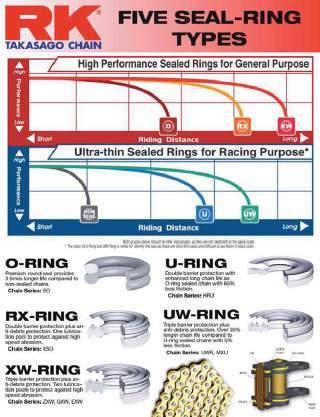
A chain’s tensile strength is usually measured in Kilogram-force (Kgf), and it’s how much load a chain can take before breaking. Naturally, the higher the tensile strength the stronger the chain. For example, a standard 520 chain may have a tensile strength of 3000Kgf where a higher-grade 520 chain like the RK520EXW will have a tensile strength of 3500Kgf. It doesn’t sound like much, but that’s an extra 500kg of force it can withstand over a standard chain. Tensile strength is not readily advertised on chain packaging as it can lead to confusion and misunderstanding. Just because a chain is strong doesn’t mean it has good wear characteristics.
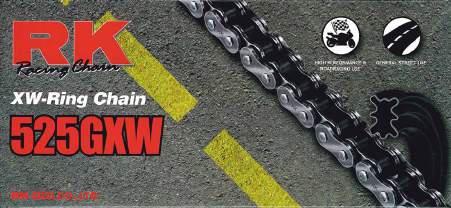
The letters/markings on chains can relate to what type of chain it is and what type of O-ring it has, but they can also determine if the chain is best suited for road, trail or motocross use.
For example, a non-O-ring chain may be an RK520H, or RK520MXZ4. The ‘H’ means ‘heavy duty’ and ‘MXZ4’ means ‘motocross, Z series, version 4’.
Then, for example, an O-ring chain may be an RK520EXW. That designation means it has an XW-type O-ring and is suited better for enduro bikes. An RK 520GXW also has a XW-type O-ring, but is more suited for high-speed adventure or road bikes.
Different manufacturers use different numbers, and this can become confusing to consumers, so Link International offers a recommendation on the correct chain for your bike on its website (www.linkint.com.au).
You could also ask a knowledgeable dealer.

The information is available if requested, but to save any confusion check the Link International website for which RK chain best suits your bike.
Selecting the right chain for your particular needs can make a difference to the longevity of your chain and sprockets. It’s a minefield with so many to choose from, and in most cases one can say, “You only get what you pay for.” But you can also do overkill.
The chain on my Africa Twin is an RK525GXW. It’s a high-tensile, XW-ring designed specifically for larger adventure and road bikes with longevity in mind.
For example, on my last three-day ride we did over 2000km, and not once did I need to adjust the chain. In fact, I haven’t had to adjust the chain in the last 4500km. And as most of my riding is done on national-forest trails with as few bitumen transport sections as possible in between, I would consider myself as a 70/30 dirt/road adventure rider.
Personally, for most adventure bikes I would recommend the GXW range in RK chains as they’re designed with a high tensile strength and XW-ring seal which offers protection against highspeed abrasion, torsional flex and the loss of lubricant under high-speed and extreme-heat conditions.
I hope I’ve enlightened some. For now I say, “See you out on the trail sometime.”


Troy found himself with a shiny new VSM DR650 and felt a ride was in order. Marty Blake found himself with a Monday off and decided it was a perfect opportunity to show a new bloke around his backyard.
It’s unfortunate I have a track record of hard first rides. I’m not sure if it’s a desire to showcase the very best northern NSW has to offer or a subconscious desire to see people suffer, but the end result is very few people come back for a second ride. As word spreads, few people even want to go riding with me at all. Those who do come back for seconds are keepers though, and the ones that don’t have lifelong memories to share with their therapist. Troy was new to adventure riding and seemed like a nice bloke. Game on!
Brooms Head was chosen as an appropriate first ride. It’s a pleasant beachside destination with good food, and getting there meant a route through coastal ranges with pleasant riding and good views. A few colourful detours offered areas of extra excitement if warranted on the day. I could see it would be a nice cruisey day riding through paradise and I was sure Troy would love it. With a forecast of 31 degrees and rain, the outlook seemed a bit grim. But weather forecasts were often wrong, and in my mind there was still the possibility it might be cool and dry.

Troy turned up a few minutes late and we wasted no time in carving up the early morning traffic and heading into the bush. Recent fires had resulted in track maintenance and the trails started out loamy and perfect – for me anyway. Behind me was a thick, choking cloud of dust that made me cough just looking at it. It billowed from the rear wheel of the mighty DR.
It wasn’t enough to make me roll off the throttle of course, and Troy seemed to be coping fine.
Andersons Mountain Road gave a respite from the dust. That was a good
thing too, with all the ruts crisscrossing the road and keeping us on our toes.
Crossing the highway into a tighter, rutted and rockier trail was pure bliss. It was just so much fun giving the throttle cables a bit of a stretch in relative safety from 4WDs. Lookout Trail dipped and dived along the top of the range before opening out just in time to be met by a LandCruiser.
Clearly it was time to back off again.
A bit of a blast along some open fire road and down a sandy sidetrack led to The Bottleman, a concrete statue by former circus strongman Jonas Zilinskas. The fires had been all around but left the statue untouched.

Also untouched, a wild horse gave us some curious looks before running off. Coastal Range Road was fun. Fires had opened up the views of the ranges themselves, sharp erosion mounds and ruts kept speeds in check and we cruised northward making good time.
Despite the dust, the ride had been fun. I knew I was a changed man. An adventurous trail appeared on the right and I rode straight past it. “Easy and fun,” I told myself, justifying my decision.
Left: Every 500 metres or so a large fallen tree surrounded by tight timber made progress a struggle. Above: Troy was new to adventure riding and seemed like a nice bloke.
Below: Front-guard-deep puddles, huge holes and rough as guts.


But 100 metres further up the road I hauled the bike around.
‘It’ll be fun and Troy will do it easily,’ I thought to myself as we struggled with a steep, loose, rocky downhill littered with fallen branches. After a few hairy moments we were at the bottom and the worst was over –which was good, because getting back up that hill might’ve been difficult.

to Troy. He took it all in his stride like an old pro.
The sandy trail snaked through the undergrowth. The odd fallen tree was bypassed fairly easily to start with, but then the half-fallen small trees started. Getting through, under and around those was hard. As the small trees scratched and clawed at our bikes my heart bled for Troy’s sparkling new DR. The trees seemed to be endless. Kilometre after kilometre they ground down our spirits, and every 500 metres or so a large fallen tree surrounded by tight timber made progress a struggle.
Eventually we broke out onto a clear road, much to our relief, and I apologised
After that shameful excursion I knew I had to make it up to Troy. So instead of the boring Candole Forest Road I decided on a fun, tight ridge section littered with rock steps that I was sure would raise his spirits.
The weather report was wrong. The mercury had risen to around 40 degrees and a short stop gave us the chance to guzzle water and admire views of endless trees, thankfully unaffected by fire.
I worded Troy up about the approaching steep hill full of rock ledges,
Above: A tighter, rutted and rockier trail was pure bliss.
Left: A pair of aces.
Top right: A moment of reflection.
telling him he was going great and would have no trouble. I added that a mate had ridden up it on a 990, thoughtfully leaving out the part about all the abuse my mate spewed at me for taking him there. It was meant to be an uplifting story, so some details were best left out.
I whipped off a few photos on a short, rocky uphill that Troy made look easy.
“Was that the hill?” he asked as I packed up the camera. I had to reply it wasn’t the hill I’d warned him about, and that he’d know it when he got to it.
It turned out the hill was no trouble.
A large tree was down and a tricky bypass was all good, but a steep downhill littered with loose rocks was challenging. As I edged down the stones tried to take the wheels out from under me and required a bit of throttle to save. The DR bounced

down over the rock ledges and gained speed, only just making the turn at the bottom.
‘Hmmm,’ I mused. ‘That wasn’t very good.’
I waited around the corner, and when Troy didn’t turn up a quick recce found the new DR upside down on a rock ledge. Shards of broken mirror and blinker lens sparkled on the ground and fuel poured from the overflow.
The bike was in a difficult position and required both of us to haul it upright. There were a few scrapes and scratches, but it was straight, so I rode it down the remainder of the hill and we stopped for a break.
Troy was keen to get going. I explained Candole Forest Road was only a couple of kilometres away and was in good nick. My exact words were, “You could drive it in a car with your mum in the passenger seat.”
Candole Forest Road was the worst I’d ever seen it, badly rutted, with front-guard-deep puddles, huge holes and rough as guts. You’d have to hope it wasn’t your car you tore the sump out of while your mum screamed in terror.
I gave Troy the option to shorten the ride, but he said he was enjoying it and wanted to continue. We eventually pounded our way out of the bush and had a refreshing lunch with a cool breeze by the beach.
Don’t tell me now
Suitably refreshed, I should probably have taken the easy way home, but there was another unreal ridge section with a couple of good uphills that would’ve been a shame to miss.
Halfway through the section Troy’s hand was cramping up, making it difficult, so we shortcut our way out of the forest, stopped for some sports drinks and dirt-roaded it toward home.
I didn’t mean to be mean
I really did try to make a fun, adventurous course. Troy seemed to enjoy himself, even though we were belted by a huge storm with buckets of hard, stinging rain and wild winds on the final few kilometres to home.
Next month we might go south. Yeah. The Pub With No Beer at Taylors Arm would be perfect. Troy would love it. There are a couple of nasty downhills, but besides that it’ll be great…




A jump starter pack will give you power anywhere, anytime. It is one of the most important pieces of emergency kit you can carry with you. Whether you’re on an outback track or heading home late at night, a jumper starter will protect you if you’re stranded with a flat battery.
Our jump starters will start motorcycles, watercraft, ATV/ UTV, snowmobiles and petrol car engines up to 4.0L (300A Jump Starter) and up to a 6.0L AND 3.0L Diesel automotive engines (400A Jump Starter)
They will also charge your phone or tablet through the USB outlets and all have a built in LED light.
The jump starter pack comes in a carry case with a 220v wall charger, a 12v accessory plug for on bike charging, battery leads and a combination micro USB/lightening charging cable.


For further information on these and all our products, please check our website for details.

Four wheels locked up and skidded towards the massive blackened tree trunk lying across the road. Another dead end…or was it? Around 20 minutes later, after the HiLux was extracted from a near-terminal bogging, Craig Jackson had a map, a GPS and mobile phone laid out on the bonnet of the ute.

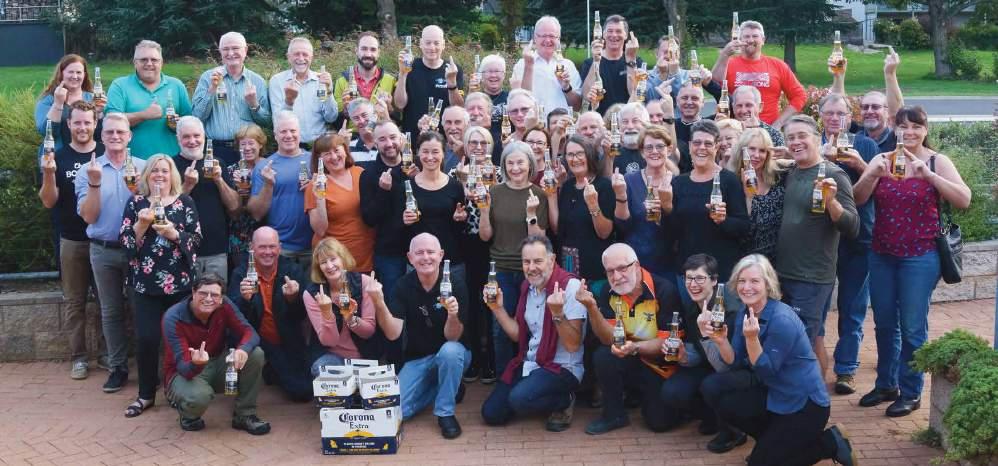
The whole morning, in fact the whole week, had been punctuated regularly with turnaround scenes as I worked my way around the Snowy Mountains region and the fireaffected coastal regions of New South Wales and Victoria. I was plotting the daily routes for the Compass Expeditions Reunion Ride event to take place a week later, and it seemed each time I found an amazing track to share with riders I was stymied by either a road-closed sign, locked gate, fallen tree or massive washout. This would inevitably result in lots of cursing, reversing and further study of multiple mapping devices to plan the next move.
When Compass Expeditions decided on Jindabyne in the Snowy Mountains of New South Wales as the base for the 2020 Ross McKeand Memorial Ride And Reunion Event 12 months earlier there was no possible way of knowing the whole area would be devastated by fires in the months leading up to the date, or that heavy rains and flooding would follow. That’s what happened though, and the combination of unforeseen nat-
ural disasters was making things frustrating and difficult, but I certainly wasn’t complaining.
‘The research trip’ or ‘recce ride’ is one of the joys of working for a motorcycle tour company. Compass Expeditions will never send a group of riders down a road or trail that hasn’t previously been checked out by the crew. This includes every ride from an epic expedition of 80 or 100 days to a weekend getaway.
The policy not only assures the safety of riders, but also means offering the best roads and little-known routes between A and B which make motorcycling so much more of an adventure than following our Google Overlord’s standard recommendation.
The recce also means at least one staffer gets to spend a few days, or three
months, driving around the planned route checking out the best roads and trails, the best accommodation and the best places to eat.
That’s not too bad a deal, even on the worst day.
Despite the frustrations on this particular recce, I was very happy with both the dirt-ride and road-ride routes we ended up with.
I reckon the riders who enjoyed them with us a week later were just as pleased.
In the lead up to the event, while the bushfires were raging through the area, there was some discussion about relocating the Reunion to somewhere that hadn’t been affected by the fires. Overwhelmingly, the riders made u
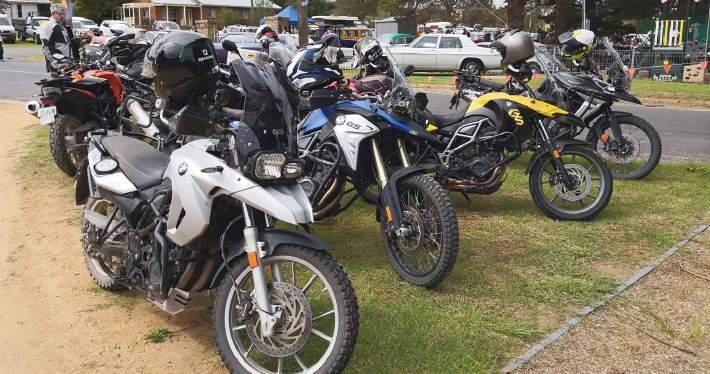
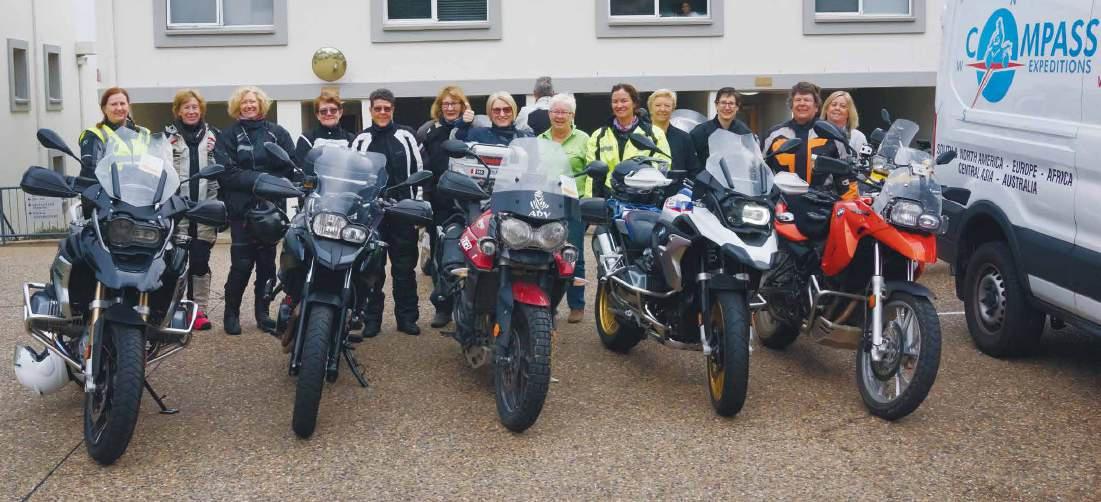
it known they wanted to support the region that would need to rebuild its infrastructure and tourism industry in the wake of the fires. By bringing around 60 riders and pillions to the area Compass would be injecting money into local businesses and that would hopefully assist the community to regrow – much like the surrounding bushland.
That decided, it was full steam ahead to arrange accommodation, restaurants, entertainment and ride routes for the week.
After considering all of the road closures in the area there was a concession made and the planned week-long ride was reduced to three days. It was also decided to take the show on the road to spread the love around the fire-affected areas.
The annual Compass Expeditions Reunion was in two parts: the weekend Reunion, this year was called ‘The Ross McKeand Memorial Ride’. It was named in honour of good mate Ross who’d triadically passed away in a road accident on last year’s Reunion Ride; and the five-day (now three-day) ride out which followed the weekend.
An invite was sent to everyone who’d ever been on a Compass tour and extended to their friends and family for the weekend event. The five-day (threeday) ride out is open to anyone who’d like to join in for a wonderful week of great riding, fantastic company and exceptional hospitality.

Among the many regular Compass riders who come for the reunion then stay to continue the party for the rest of the week, there are also riders keen
to try out Compass and see if it’s the type of organisation they would like to travel with in the future.
It’s great to see the camaraderie of touring buddies that may have completed two, three, or more tours together include a rider who is there for the first time and who’s soaking in the atmosphere of a cohesive ride group.
The Rydges Horizons Snowy Mountains Resort supplied a great venue, the tasty meal and plenty of refreshments for the annual Reunion Dinner on Saturday night, and there was a coup with the guest speakers for the evening.
First up were world travellers – and regular Compass tour participants –Cindy and Duncan Bennet. Cindy and Duncan have ridden across Africa, Alaska,


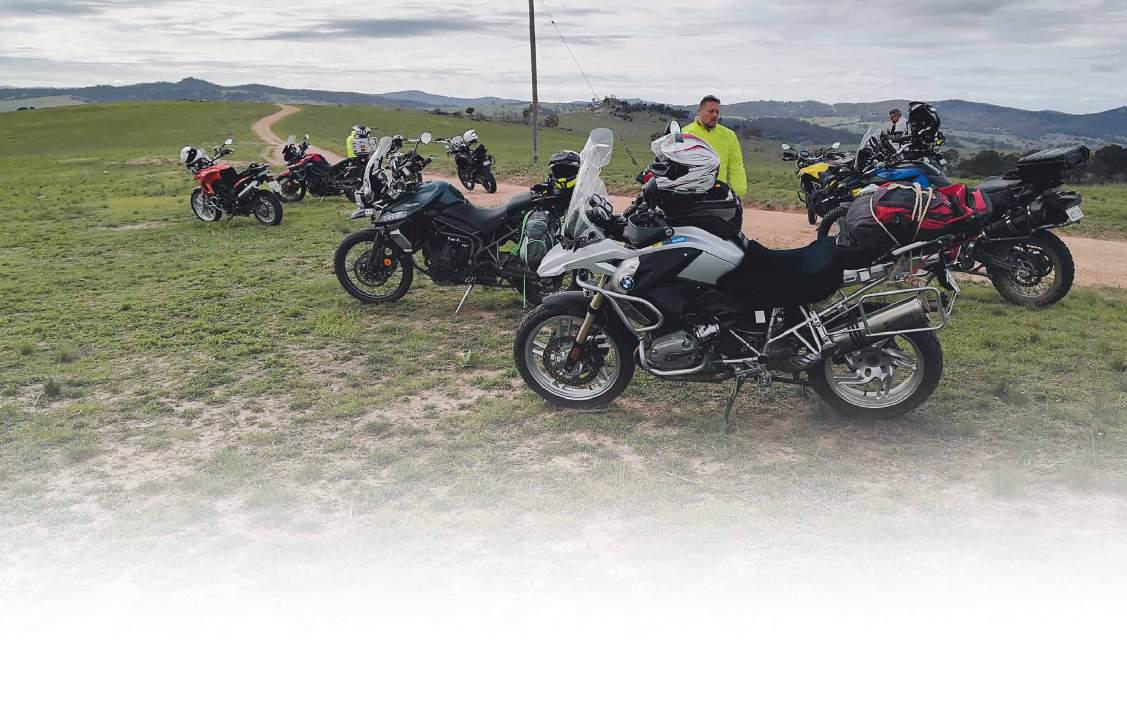
Australia and in many other countries that don’t begin with the letter A. They have a unique and very funny take on life and travel and their presentation had everyone in fits of laughter.
It seems Cindy is the driving force, or perhaps the deciding factor, in the couple’s constant motorcycle travels. She’d been known to book Duncan and herself onto huge undertakings, like the 80-day Cairo to Cape Town ride and 2021’s epic 100day Ultimate South America Expedition, without him knowing about it until it was all settled, booked and deposits paid.
One audience member was heard to mumble into his dessert, “What a wife!” with admiration during the presentation.
Many in the room agreed.
It was a hard act to follow, but up next was a favourite of the Compass crowd.
Many had heard author and adventurer Heather Ellis speak about her first book at the 2017 Reunion Ride, and Heather recently published her second book, Timeless On The Silk Road, the continuation of the story of her incredible travels from London to Hanoi on her trusty Yamaha TT600.
Her story is so much more than a travelogue of the journey and the series of adventures she encountered through Europe, Turkey, Central Asia and then
through China to Vietnam, before returning home to far north Queensland. It’s a journey of self-discovery and an intimate tale of her realisation of the interconnectedness of humans around the planet and how, if you trust that connection or feeling, everything will work out in the end.
Heather joined the Saturday-afternoon ride and surprised everyone by opting to ride her beautiful 2013 Triumph Thruxton on the dirt loop. The route included some rough farm roads, lots of loose gravel and a great, fun, twisting section of bush track that climbed up and over a rocky range. There was even an unexpectedly deep water crossing as a finale to the dirt section.
It was a true lesson in ‘Run what you brung’, and testament to her skill and years of riding experience. She put a few GSs and other ‘adventure’ bikes in their place that day.
The evening ended with a charity auction. Two very generous bidders took
home bags of goodies, including items from the Rocky Creek Designs range of adventure equipment as well as a selection of Compass Expeditions merchandise. Around $1200 was raised for charities supporting the local community to rebuild, including the Rural Fire Service, BlazeAid and Lifeline.
K.I.S.S.
The weekend and the rest of the week followed a very simple plan.
After a hearty breakfast, two groups gathered for the day’s riding. Those who wanted to ride some great sealed roads and take time to enjoy the sights, regular coffee, ice cream and bakery stops on that particular day joined the ‘Café Latté Parté’. Those looking for some real adventure, a bit of a challenge and who didn’t mind some filth on their bikes joined the ‘The Dirty Crew’ and took to the tracks and trails hunted out for them on the recce.
The destination included comfortable


lodgings for the evening, a predinner refreshment and an evening of great food and company.
The next day would repeat the process.
With sections of Barry Way, The Alpine Way, Cooma Road and large tracts of Kosciuszko and other National Parks still closed to traffic, we had to explore further into the surrounding areas and find routes we’d never have thought to ride if those classic high-country riding roads had been open. The result was many wonderful and rarely travelled backroads, farm tracks and bushland trails, and seeing first-hand the destruction caused by the fires on the small communities and bushland off the main tourist routes.
One highlight of the week was dropping in on the Dalgety Show on Sunday afternoon and being able to stroll around a real country fair, complete with workingdog trials, homemade arts and crafts, a CWA cake stall and an antique stationaryengine display.
Hundreds of locals had gathered in town to enjoy the day and there was a sense of relief in the air. It seemed now the fires were out and reconstruction had begun, people could allow themselves a bit of joy in their lives once again.
Life was blooming again in the community.
The crews made their way south from Batemans Bay to Mallacoota, then inland again to finish in Jindabyne, and it seemed the rest of the world was a long way away, held at bay by the daily routine of eating, riding and enjoying ourselves. However, news was filtering through that the Coronavirus situation was worsening across the globe and many countries had already started to close borders and restrict travel.
As an international motorcycle tour company, Compass knew it was going to effect its business in a profound way. On
the final morning of the ride the devastating news became public: the World Health Organisation had classed the situation as a pandemic.
That changed the game for Compass Expeditions.
Knowing most travel-insurance policies had an exclusion clause for any claim resulting from a pandemic, Compass couldn’t run any further tours, anywhere in the world, until that situation changed, the pandemic was downgraded, and travel restrictions were relaxed.
Over the next few days a number of tours were cancelled, something Compass Expeditions had rarely ever had to do. It included the flagship, 105day major expedition along the Road Of Bones. Bikes and equipment had already

been packed in containers and were sitting on docks awaiting shipment to the UK. These needed to be stopped and turned around.
The 90-day Asian Overland Expedition was in Myanmar and a contingency plan had already been developed because the Chinese border was closed, but the expedition participants, crew, bikes and support vehicle somehow had to be returned home as soon as possible before everything was locked down.
All central-Asian and African tours for the rest of 2020 were cancelled and the Trail Of The Incas tour of Peru, Chile and Bolivia was turned around three days into the itinerary when Chile closed its borders too.
The support the Reunion riders and the wider Compass Expeditions family showed was incredible. It was heartwarming to see the outpouring of appreciation and concern when it was decided it wasn’t enough to offer guests a credit for their cancelled tours but, if they preferred, they could receive a full refund.
The gesture meant bringing Compass to the very edge of financial viability, but staff knew they couldn’t hold their heads high and be worthy of the trust customers had shown in choosing Compass if this tough call wasn’t made.
So now the company is in hibernation. Some staff have had to be dismissed and the tour crews are hunkered down for some lean times.
Rest assured though, Compass Expeditions will be back stronger than
Top: The Dirty Crew near Narooma on the NSW coast.
Left: A slippery ford across Wullwye Creek was a bit sketchy.
Top right: Compass Expeditions founder Mick McDonald provided ‘ute-tray coffee stops.

ever when it’s able to once again show riders just how awesome this world is from the seat of a motorcycle. There’s new tours, new destinations and a whole new concept for adventure travel on the planning table. So, stay tuned and start planning your next adventure at www.compassexpeditions.com.
Compass sincerely wishes to thank its wonderful customers and crew for the support shown over the past few very tough months, and want it known it’s done for you.
We hope to get the chance to ride with you all, once life returns to some kind of normality and the travel industry can have a rebirth as well.

The staff of Compass Expeditions likes to think it has always put clients’ best interests first. It was, and remains, our view that if Compass Expeditions closed its doors, at least we could hold our heads high and be proud of who we are and what we stood for.
An outpouring of support, future bookings, encouragement from clients and industry mates has only steeled our determination to continue. We want the opportunity to thank and repay those who inspired us to go on and to those who offered to do all they can to support us, a company, while dealing with their own Covid-19 issues.
Mick McDonald Compass Expeditions.

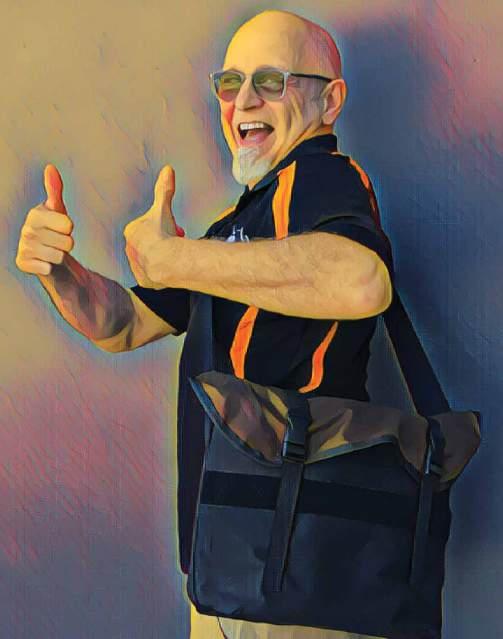



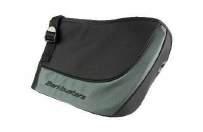

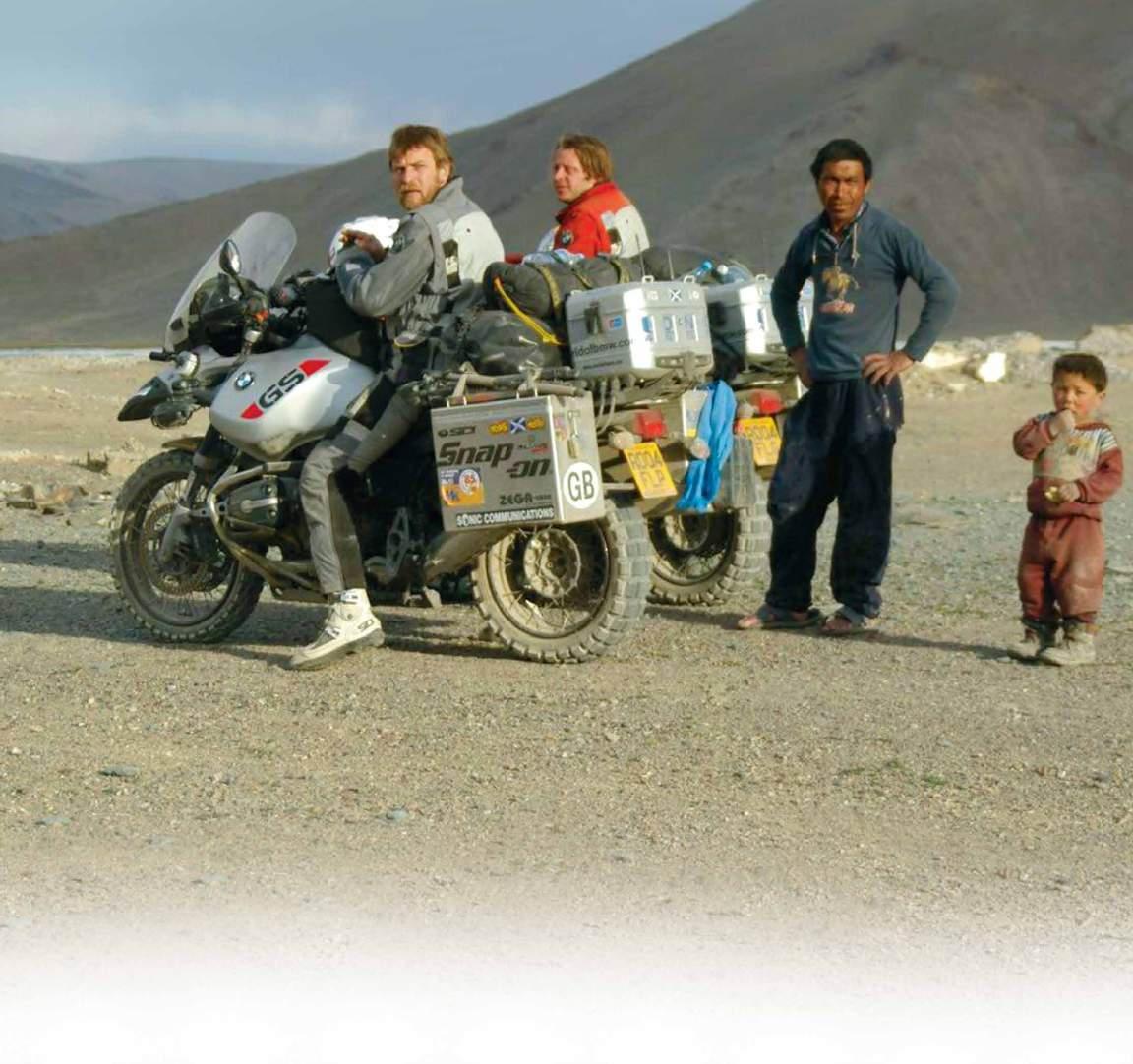
Many Australians launched into adventure riding on the 1150GS Beemer. It’s a bike that still holds its own in the adventure world today.
BMW has a long history with its GS brand.
The R80G/S kicked things off in 1980 and the German marque has gone from strength to strength ever since.
The ‘GS’ designation came from the initials of the German words which translate to ‘off-road/road’.
Later the words changed to ‘off-road/ sport’, but the initials were the same, so das ist gut
Top: Ewan and Charley’s use of the 1150GSA in Long Way Round gave the bikes huge acceptance from the general public.
Right: Australians in particular embraced the 1150GS and GSA.
BMWs had always been favoured as go-anywhere bikes, but the GS models made it official. A GS had longer suspension travel, a more upright seating position and bigger fuel capacity than the road-focussed BMWs, and several wins in what was the ParisDakar Rally cemented the views of a fast-growing legion of fans that the GS was a genuine off-roader.
The GS’ good run in the Paris-Dakar Rally came to an end at the turn of
the century, and by then the range had grown to include 1000cc and 1100cc examples. The ‘PD’ designation on a GS meant a Paris-Dakar special, and by the start of the current millennium those bikes were already hot property for collectors, especially the much sought-after R80G/S PD.

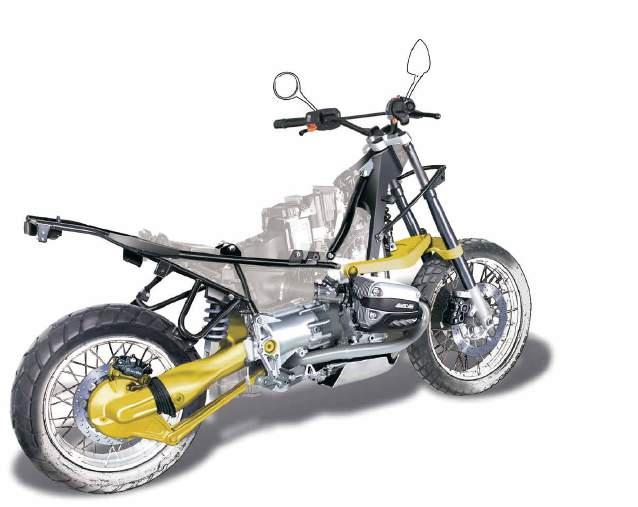
Meanwhile, worldwide GS sales had continued to surge and development was ongoing. In 1999 the 1150GS hit dealer showrooms and was an instant success. The 1130cc boxer twin was an ‘oil head’ – the term BMW owners use for oil-cooled motors, differentiating them from air-cooled ‘airheads’ – and featured a six-speed gearbox, a much-applauded upgrade from the five-speed 1100GS. Power output was claimed to be 85
Left: Both the Telever suspension at the front and the Paralever system at the rear worked well. Below: Quiet and on spec for emissions. Below right: The 1150GS continued BMW’s success in the dualsport world. Bottom: Ready to race. The R1150GS/RR. Drooooool.

98Nm. At the time those were big numbers for a dualsporter. Of course the 1150 was shaft drive and used the Paralever rear-suspension system with adjustable preload and rebound, and the front was Telever
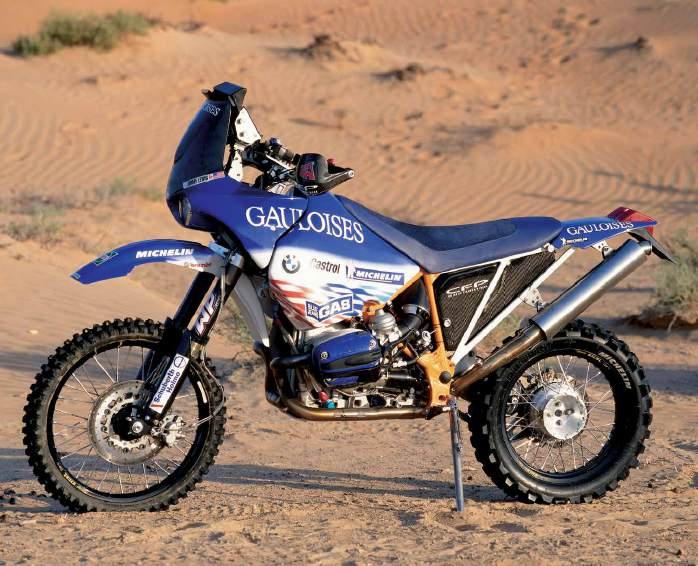
with 35mm fork legs. Seat height was either 840mm or 860mm depending on the position the rider chose, and the unladen weight, full of fuel, was 249kg. Nobody blinks much at a 250kg adventure bike these days, but in 1999, that was perceived to be about the size of the HMAS Melbourne, Australia’s only aircraft carrier (back when we had one). At that time Honda’s ’99 Africa Twin weighed in at 235kg, Yamaha’s Ténéré 201kg and Suzuki’s DR650 150kg.
Over 50,000 1150GSs were sold worldwide from its launch in 1999 to its discontinuation in 2004 when it was replaced by the 1200GS. In that time the bike established itself as a firm favourite among those who loved a big-bore adventurer.

Australians in particular embraced the 1150 and stories of serious, hard-core adventure rides completed by the big Beemer abound. Most of the very high regard for the bike stems from it being a great package. The motor, gearbox and suspension were trouble-free and handling was good for such a big bike. Braking was strong and a very efficient system which gave components an exceptionally long lifespan.
In 2002 the braking system was replaced with an electrically activated, servo-assisted combined braking system. It was ahead of its time and meant application of the front brake automatically activated a percentage of the rear as well, and it worked a treat. The ABS wasn’t
universally popular though, and weighed around six kilos. Some owners removed it.
At the same time – 2002 – the fourvalve heads went to twin sparkplugs. The aim was to improve emissions and deal with surging which was common in the boxer twins of the time. An unexpected bonus of the twin-plug system was when the combined plug-cap/ coil failed, the only indication for the owner was the bike began
stalling for no apparent reason. It ran fine, but the low-speed stalling was a sign something wasn’t right, and owners carrying a spare plug-cap/coil was common. Another problem, although not widespread, was a tendency for the motor to kick back during starting and destroy the starter motor.
That’s about it for niggles. The most common opinion on the 1150GS was ‘…it didn’t do anything exceptionally well, but it didn’t do anything badly, either’.
From 2001 to 2005 BMW offered an 1150GS Adventure.
The same bike in most respects as the GS, the GSA offered an optional larger fuel tank, a bigger screen, single-piece seat, taller suspension, lower first gear and sixth gear – instead of the overdriven top gear on the standard bike – and a sensor to allow the Adventure model to run on lowerquality fuel.
Motorrad Garage near Perth in WA has a well-used example on display. It’s well-used because Motorrad Garage main man Howard Bathgate logs plenty of distance on the bike when he’s not watching the Sydney store.
These days a confirmed HP2 owner, Howard has found the 1150GSA to be a tough, reliable workhorse.
“It was my first adventure bike,” he explained.
“I bought it in 2005, when it was a year-or-so old, for a trip we had planned in 2006. A friend and I were both on 1150s for that one.

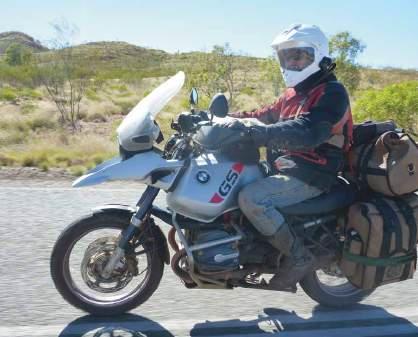
“Then there was an event called the Quit Forest Rally. It was the Western Australian round of the Australian Rally Championship, and they ran bikes with the cars. Basically, as the result of some dares, I ended up doing that on the 1150 for three years.
“The only one time the bike ever had a problem was when the rubber damper in the drive train let go. That’s the only time it’s been on a ute.
“It just sat in the shed, and every time
I wanted go somewhere, I just pushed the button and it went. I never did anything to it except service it every 10,000km or so, and it’s taken me everywhere I wanted to go. I never saw the need to upgrade it…until the HP2 came along,” he grinned.
Below: Motorrad Garage’s Howard Bathgate with his go-anywhere/do-anything 1150GSA. Below left: The bike spends most of its time displaying gear in the Motorrad Garage Perth showroom.
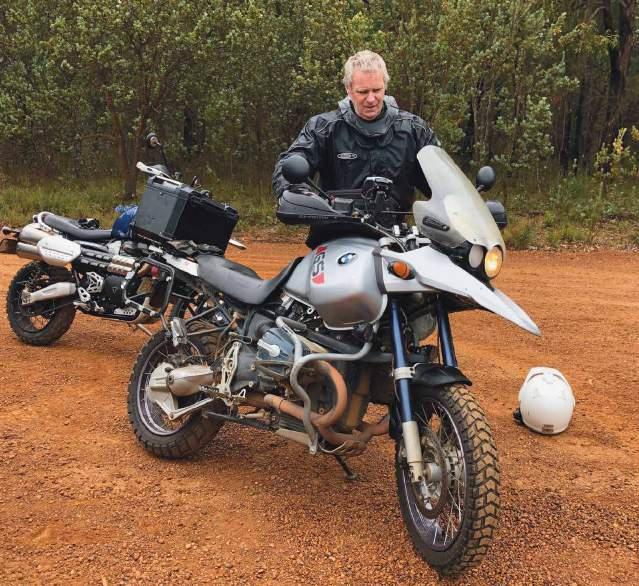
Left: A tough, reliable workhorse. Below: There were no real faults in the 1150, and it was as tough as old boots.
The 1150GSA was the choice of Ewan and Charley in Long Way Round, and it’s impossible to ignore the huge influence of that show in shaping what we now call adventure riding. Of course, it also established BMW as the top-dog adventure tourer in the minds of the general public.
It’s a great all-rounder with few if any faults and an excellent value-for-money secondhand purchase option.
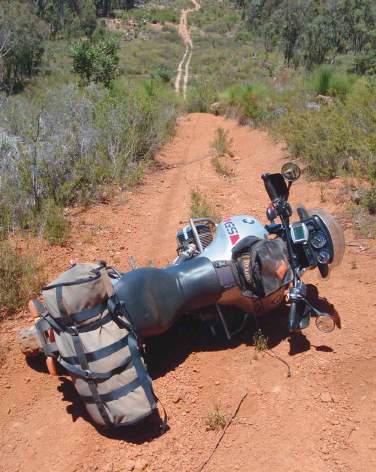
The ELF bike on display at Adventure Moto in Dural, near Sydney, is a recent acquisition for owner Steve Smith, and his connection to the 1150GS is interesting.
“Before Adventure Moto I was a mad-keen mountaineer,” said Steve.
“I’d just come off a climb in the Andes, on the mountain range between Chile and Argentina, and I’d decided it was my last climb. I was into my 40s, I’d started a family, and a lot of my friends had had accidents or been wiped out on the mountain.
“I’d hiked to a little village called Puerta del Inca, and right behind me these guys rolled in on 1150GSs. It was the first time I’d ever seen diehard adventure riders doing what we all now dream of doing…you know, seeing the world on a bike. I thought, ‘I’m not going to climb these mountains any more. I’m going to ride through them.’
“I pored over the guys’ bikes, a couple of 1150GSs, really well prepared, and I knew that’s what I wanted to do.
“When I got back to Australia I watched a movie called The Ride. It was about a bunch of guys who rode from Prudhoe Bay in Alaska to Ushuaia in South America, and they were mostly on 1150GSs. So I went and bought myself one. I was hooked. I started buying luggage and gear and created Adventure Moto off the back of that,
and here we are 12 years later.
“I traded that 1150 on a 1200 when they came out and I’ve owned a stack of BMWs since, but just recently a customer who’d become a mate phoned and asked if I’d look at a secondhand bike that was nearby. It was this 1150GS with an interesting colour scheme and I pretty much fell in love with the bike when I saw it. It was basically in good shape, and I thought if my friend didn’t buy it, I would.
“The friend bought it and rode away, but not before I asked for first right of refusal if ever he decided to sell it. Sure enough, he eventually moved to an 850GS, and, as promised, offered me the 1150.
“It’s still a lumpy old GS, but it’s got heart and it’s got soul. This is one bike I won’t sell. No matter what else comes along, I’ll have my 1150GS and it’s all good.”

Below: Adventure Moto’s Steve Smith has a strong attachment to the 1150GS.


A media release for a new bike is usually some gentle riding from one exotic location to the next with five-star accom and a-la-carte dining each night. You’d think someone with as much experience as Daryl Beattie would know that.
Alice Springs was at its fly-infested, 38-degree best as the cynical and hard-bitten journos piled off the airport bus to stare with disbelief at swags in the red dust. In the few seconds it took to absorb the scene several million flies had settled on each rider and had obviously sent insect signals to their mates declaring, ‘Fresh meat!’, because the little buggers began to swarm.
Having been warned in the bus the riders sprinted straight for the swags where fly nets had been left for them.
It was a strange start to a media release where every rider was accustomed to being treated with deference.
With insectproofing safely in place a few giggles broke out and comments were made about what a good laugh it’d been to start things off.
Heads gyrated through increasing arcs as it became clear there really weren’t any airconditioned rooms nearby.

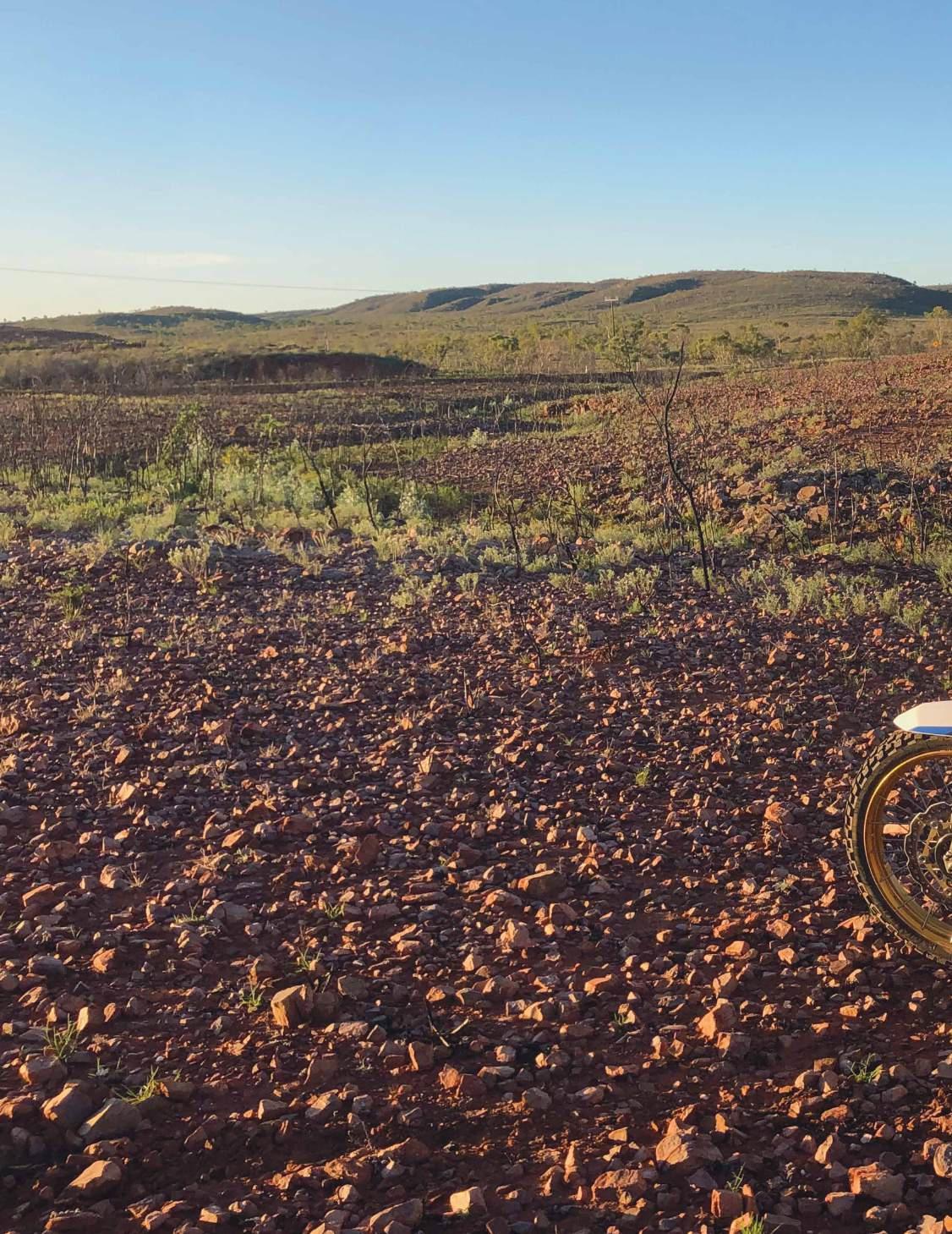
A bit different
The occasion was the release of Honda’s Africa Twin 1100, and the location was Uluru Camel Tours just outside Alice Springs. A view of Uluru and the novel setting made things interesting, and a sunset camel ride offered by owner Chris Hill calmed
some ruffled feathers.
But first was a lap of the monolith to settle in on the new bikes, and the majesty and mystique of Uluru was overwhelming. It’s easy to understand why the landmark is held in religious awe by anyone who strays near it, no matter what their heritage.
But the wonder didn’t stop there.
Seeing Uluru change colour as the sun sets must be one of the world’s most unique and wonderful experiences. A camel offers an excellent mobile viewing platform and makes for an unforgettable experience all its own.
Feeling far more settled about things the group, trailing the faint odour of desert ruminant from manky crotches, hobbled its way back to camp and rider briefing.
Daryl himself barbequed up some amazingly tender steaks before everyone climbed into their assigned swags, complete with sleeping bags, liners and pillows, and pondered on whether the briefing had been serious. Could everyone seriously be expected to ride 900km the next day? And 800km of it on bitumen? That was the kind of thing riders did on big dualsporters, but not journos on a press junket.
The temperature plummeted to the mid-30s as the snoring and blurting from the campsite kept the camels from a restful night.
Before dawn the next morning the group was on the road, fumbling around in the darkness looking for the cruise control and mostly at ease with the idea of a big day. The corner lighting on the bikes got a workout before a spectacular sunrise of the calibre only The Red Centre can offer,


and the kilometres began their long and laborious countdown.
Everything was purring along nicely until, at a drink stop, Daryl – ‘Daz’ – asked if anyone wanted to do a bit of extra dirt. He explained it would only add another 60km…or so.
Eyeballs swivelled rapidly from side-toside as everyone tried to second guess what everyone else would say, and, before anyone embarrassed themselves by appearing reluctant, Daz declared, “Okay. More dirt it is!” In a fluid motion he leapt on his bike, landing with his thumb on the starter while his foot kicked up the stand, and was gone before anyone could say, “But…”
A stop at Ti Tree allowed the intake of desperately needed caffeine and a chance to scrape off several kilos of flies before mounting up and heading on to the overnighter at the Devils Marbles, about 80km south of Tennant Creek.
It was a long day and everyone was glad to discover the campsite included another stunning formation of stones and some truly beautiful countryside.
And rocks. There were some rocks here and there.
Surprisingly, not everyone was keen to go pounding across the gibber plains for photos that evening. There may even have some been slight bow-leggedness evident in a few of the riders, but there was work to be done, so while Daz, lead rider Buddha and truck driver Scooter prepared another amazing feed – it turned out every feed on a Daryl Beattie Adventures ride is amazing – some grabbed bikes and styled it up for the camera while some returned to the privacy of swags to massage tender rear ends.
Well…that’s what they said they were
massaging. No-one enquired any further.
A full moon made for an incredible evening as a tired but happy group settled in around the fire to enjoy a cold drink, a huge dinner and one of nature’s most majestic displays.
Life was basically pretty good.
The second day was to be the riding highlight.
The idea was to head along a section of the Binns Track, allowing riders to give the bikes a good off-road workout and for everyone to get the photos they needed. It was what everyone was there for after all, and Honda had supplied Damien Ashenhurst to take care of images and video. Only a mug would’ve missed the opportunity to be shot by a cameraman of Damo’s calibre.
At the briefing Daz had forecast around 500km for the day. There’d been
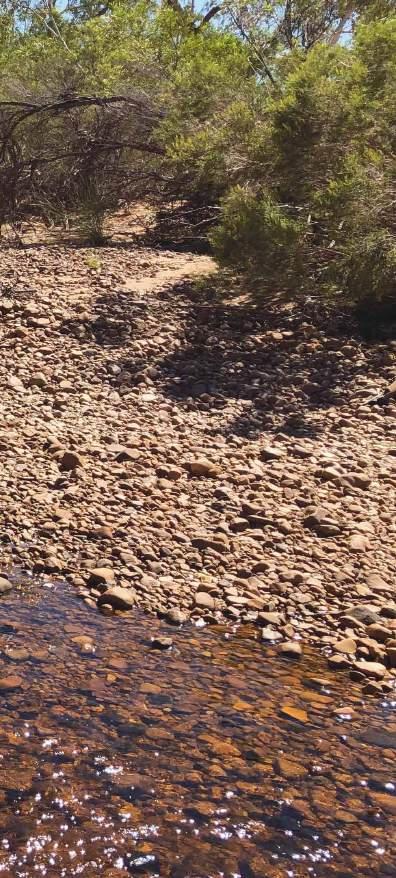
Left: Just for fun.
Right: Buddha Luczkowski moved around quietly in the evenings checking on the bikes.
Below: The flies were brutal. Even food and drinks had to be kept inside the supplied head nets.
Bottom right: The occasional section of saturated bulldust helped focus riders’ concentration.


with a drone – meant plenty of opportunities to recover and to enjoy the endless supply of cold drinks from the truck, and gave time for socialising and discussion.
The long, dusty and very satisfying day wound down and Daz offered the group a choice between spending the night at Ti Tree pub or setting up a bush camp. A few trembling voices started to offer opinions, but before any sentences could be completed Daz was nothing more than a trail of Euro 5-compliant emissions disappearing into another spectacular Northern Territory dusk.
“It’s only about 200km to camp,” offered
the imperturbable Buddha.
The news was received with an almost uniform series of blank looks from the riders.
A bush camp can mean different things to different people.
A bush camp with Adventure Rider Magazine generally means stuffing bark down the jocks to protect the nether regions from drop bears and sleeping in the foetal position behind the bike, maybe sucking on an old muesli-bar wrapper if one can be found in the backpack.
On a Daryl Beattie ride a bush camp
a little murmuring from his team at the announcement and he amended the forecast to 600km. The trip meters on the Hondas called it 650km, but who was counting?
The Binns Track is over 2000km of four-wheel drive glory stretching from the South Aussie border through central Australia and on to Timber Creek, halfway between Kununurra and Katherine in the Northern Territory. Judging by the sample on this ride it must be one of Australia’s most fulfilling off-road journeys.
That may well be, but as hands blistered on the rocky going, the temperature climbed, and the occasional section of saturated bulldust helped focus riders’ concentration, it possibly wasn’t everyone’s favourite part of Australia on that particular day. Some clearly enjoyed the riding immensely, but the necessary endurance took its toll. A few stops for photos and video – Daz is a dab hand

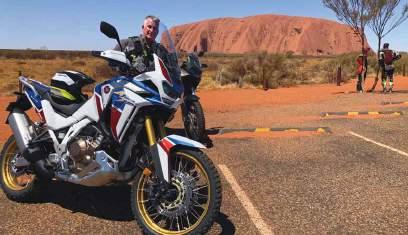
means raging catering with cold drinks, hot coffees, chairs and camp furniture, music, lights and very comfortable bedding. There’s even Peter ‘Buddha’ Luczkowski moving around quietly in the evenings checking on the bikes. If you wonder why that left everyone feeling a little starry-eyed, Google his name and see who else’s bikes he’s checked over.
So although some of the journos were a little restless at the end of the second day, there were still plenty of happy faces inside the fly nets that night. The coffee machine worked overtime and after some discussion it was agreed having no phone or internet access wasn’t so bad after all.
The velvety black night crept up from the horizon, accompanied by the ribald comments thrown at those who elected to use the shower on the side of the truck, and the buzzing of flies faded to become the whining of mozzies. By this stage it’d dawned on everyone that this wasn’t to be the media pampering everyone had expected. It was an actual adventure ride.
Almost, but not quite The final day was another scorch along the Binns Track and the road to Alice

Left: Rockin’ in the late arvo. Right: Dust was a problem, but there was plenty of room for everyone to stay in clear air.
Bottom left: Catering on Daryl Beattie Adventure rides is pretty frigging awesome.
Bottom right: A go anywhere/do anything set up.
Springs and it was fantastic. Long stretches of sandy surfaces on a solid road base meant cutting loose and the rigours of the previous two days faded in everyone’s minds.
It was fair-dinkum feet-up fun and those with the energy made the most of it.
A relaxing bitumen run steered the group into Alice itself. Dusty, gaunt faces began to fill out and smiles appeared in helmets as coffee shops, motels and manicured suburban lawns came into view. Phones went ballistic loading up backlogged e-mails, text messages and all kinds of alerts. Riders relaxed back into thoughts of the luxuries to come. Those fantasies were snatched heartlessly away as the bikes launched back on to the dirt and into the dust. A few looked wistfully in the mirrors to watch Heaven fade behind as the Finke Desert Race track appeared on one side of the dirt road and rolling red dunes filled the other. A few rocks here and there kept everyone honest and even a road train or two rumbled past to ensure the air filters had a good workout.
It was a crumpled and worn crew which turned into Ooraminna Station in the late afternoon. Damo Ashenhurst, showing serious commitment to his
work, asked who wanted to do some pics in the dunes, and the instructions he received on what to do with his camera would’ve caused a fetish sex worker in the red-light district of Istanbul to blush.
With all the mod cons of Alice Springs just a short distance away, faces fell when the truck came into view with the swags and bedding waiting.
Looks can be deceiving and were in this case.
Ooraminna turned out to be a jewel of comfort and a true oasis. The station has good amenities for visitors, a very nice airconditioned bar and dining room, a movie set (true!), and the Northern Territory’s friendliest dog, Scrappy.
After showers with lots of soap, and an amazing dinner of steak or barramundi, with a selection of suitable wines set on a long table with a tablecloth and real cutlery under the stars, the journos began to feel things had returned to normal. The staff of Ooraminna – mostly the family who owned and ran the station – were friendly and incredibly helpful, and even the swags were under shelter for the night.
When it was found there was phone signal at the bar everyone’s cup of happiness once again overflowed.
Daryl Beattie Adventures ran a firstclass show, Honda had in fact allowed everyone to put the bikes through some very thorough testing, and once it was all over the journos looked at each other and agreed: they’d just spent a few days in the real world of adventure riding.
Amazing.



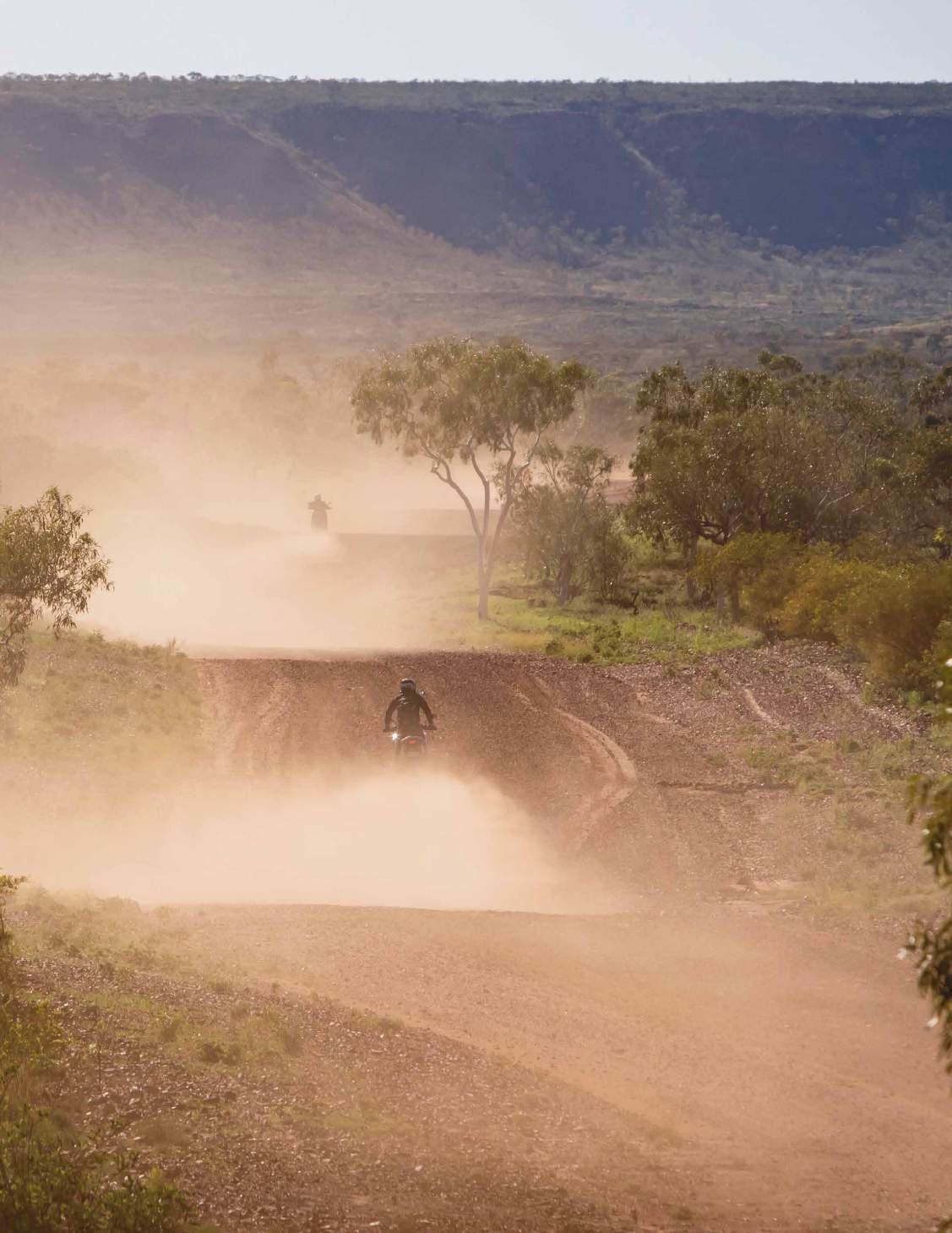





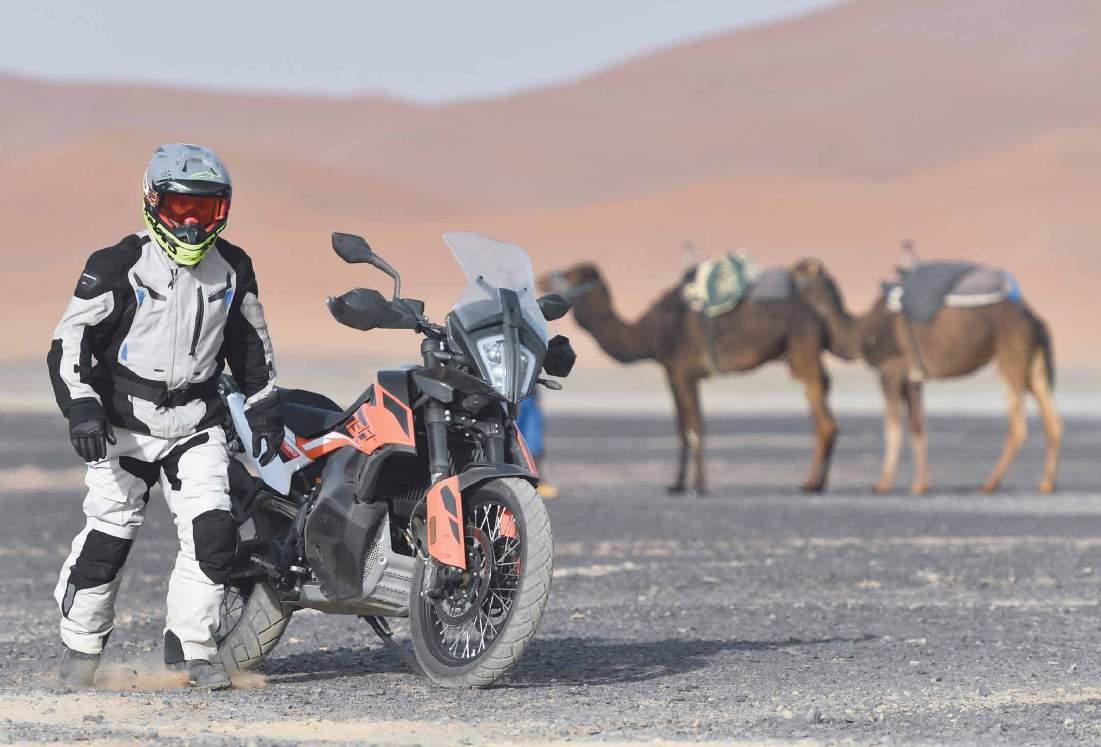
The next suit to get a very thorough scrute is actually the one I’ve had the longest, and has probably had the toughest run of all.
I climbed into the Macna clobber back in early 2018 for issue #30. At that time I was setting up for a RideADV run advertised as ‘the coldest ride of the year’. I was interested in seeing what riders were doing to cope with cold, and I naturally didn’t want to freeze my own ’nads off chasing the story. The importers, Link International,
assured me the Macna gear would keep any anatomically sensitive areas safe, so I suited up – with the addition of a pair of Macna Talon gloves to ensure I could still manipulate those sensitive extremities when the need arose –and set off for Lithgow in the Blue Mountains of NSW. It was cold. There was plenty of frost around when the ride started, and the first section of the second day had to be cancelled because the trails were so badly iced up. I’d ridden the Touratech KLR from the
NSW north coast and had to cover about 700km of bitumen to get there, and on the trip back the Blue Mountains’ roads were icy and the fog was thick. It was so cold on the morning I left to ride north I had to pour hot water over the ignition on the KLR to unfreeze it to get the key in. On that occasion my view was the Macna gear kept me ‘in really good shape’.
The Macna jacket liner was interesting because it was for warmth, not for keeping water away from the rider. The jacket has a water-repellent laminated layer called ‘Raintex DL’ laminated to the outer material that did its job well. I like it when the outer layer is waterproof because it stops the fabric getting wet. Once the fabric’s damp the wind will cause a marked drop in temperature as the moisture evaporates. I’ve heard plenty of arguments for the waterproof layer being protected under other outer layers, but for me, I like the outside of apparel to stay dry.
As I flicked through the issues since then, I was actually a little surprised at how often I saw myself in that Macna suit.
It’s comfortable, the protection’s good, and while it may not seem a big deal, the small reflective panels scattered around the gear glow like buggery.
Macna calls the reflective stuff ‘Side Eye’, and it’s not just a bit of shine, but serious little panels of bright luminescence that can’t be ignored. They sometimes even stab into my retina a little when I walk past the gear hanging on the rack. I like that. The suit itself doesn’t look lairy or brightly coloured, but the way it flares up in headlights or even in sunlight is comforting.
The fit of gloves, jacket and duds is nice. There’s still plenty of room for the warmth liners, thermals and armour, but it looks fairly sharp. It must be something to do with the way it’s cut, because the sizes are all the same as all my other gear, but it seems as though it fits a little neater. Whatever. There’s no problem moving around and it’s comfortable for long days. There’s not as much venting in the Macna clobber as some of the other gear I’ve tried, but it somehow lets the air in on hot rides, and knee, elbow and shoulder armour is supplied. There’s a pocket for a back protector, but I was happy without it.
One thing that’s very striking with the jacket is how bloody comfortable the collar is. Macna calls it a ‘Comfix’ collar closure. It’s a sort of a velvety, flocky lining that feels really nice against the skin.
Mmm…soft. Smooth. Niiiice.
The pants feature both a zip-out Raintex breathable and waterproof liner and a separate zip-out thermal liner, and the combo works well for all kinds of conditions. There’s vents at the knees and on the thighs and an adjustable knee guard, and it has the little ‘Side Eye’ reflective panels as well.
I opted for my usual plastic knee guards rather than the internal guards supplied with the suit because I felt more they covered more of the knee and lower leg.
It’s no surprise I grabbed the Macna gear for the snow in issue #37 in 2019.


I remember at the time I didn’t put any thought into what I’d wear on that particular ride. I’d learned by then if I grabbed the Macna kit I’d be right in just about any conditions.
As for wear and tear, I really can’t see anything on any of the gear I could point out. There’s no tears or fraying, the zips are all still working fine and the suit still looks good. Even though it’s mostly a pale colour I thought would show a lot of dirt and stains, it washes up really clean every
R Raintex membrane lining with sensigrip, Bemberg
R TPR knuckle and finger protection
R 30-degree buckle, grip print, screencleaner, touch tip
R Sizes S to XXXXL
R Rec retail $139.95
time. There’s some scuff marks on the lower inside of the left leg where I guess it rubs on bike frames, but you have to look for it, and it’s only marks. The fabric still looks in excellent condition.
The gloves are waterproof and did well in the cold. They don’t feel like a heavyweight four-season glove, but they’ve done the job for me in both hot and cold conditions without any drama. They’re not as bulky as a full, subzero glove, but they’re not as light as


motocross gloves, either. They’ll probably suit most adventure riders as a generaluse glove to cope with anything that’s not extreme.
I said the other suits I’ve tried were heavy. The Macna combo isn’t as heavy as the others I’ve written about, but it’s a solid unit.
Where the Macna really shines is price. The jacket/pants/gloves combination I’m wearing have a total retail cost of $939.85. That’s a seriously good deal for gear which has proven itself the way this lot has.
So there it is. I’ve been wearing the suit on and off for most of two years and it’s still in great shape. As I was looking for a few pics I found I’d worn the Macna suit in just about all types of terrain in destinations around the world. I have pics from the Bloomfield Track north of Cairns to Jacobs Ladder in Tasmania and the Sahara in Morocco. It’s coped really well in all kinds of adventure-riding situations. It’s comfortable, protection is good, and I reckon it presents pretty well, too.
It’s good gear.
R Durylon polyamide highabrasion-resistant, nylonblend materials
R Raintex DL (the outer shell has a direct-laminated, internal, waterproof and breathable material attached) plus a zip-out thermo liner
R Side Eye, Vision Vest-prepared, Safe Tech CE Level 2 protection at shoulder and elbow, CE back-protector prepared, fitted with a 12mm EVA foam back pad
R Waterproof air vents in the chest and back, Comfix collar closure, Hot Vest prepared, coat hanger, arm adjustment straps, long pant-connection zipper, back pocket, wind-collar prepared
R Sizes S to XXXXL
R Rec retail $499.95
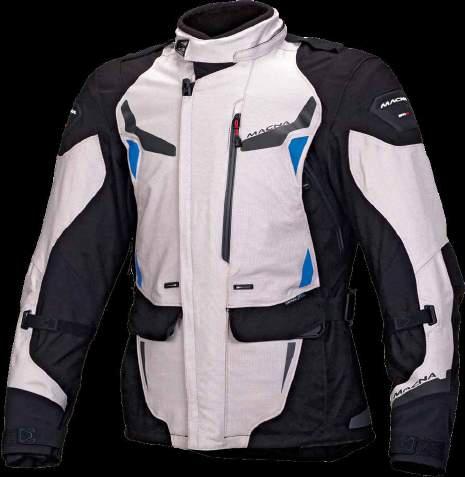

R Three-layer system with detachable Raintex breathable waterproof membrane and thermo liner
R Side Eye, Safe Tech CE protection at knees, CE hip-protector prepared
R Airvent on knee, waist lock, antislip strips, heatshield, short connection zipper, suspender prepared, adjustable knee protector
R Sizes S to XXXXL
R Available in black or ivory/black
R Rec retail $299.95




Australia’s first response to Thierry Sabine’s fledging Paris-Dakar Rallye was the Wynn’s Safari. Graeme Sedgwick was there, and recently uncovered a trove of memories from that amazing era.

Iwas dusty, damned hot and fraying at the edges when I handed my road card to officials on day four of the Wynn’s Safari in 1985. That was when David ‘Beak’ Murray and I first caught sight of each other. He was on an XT600 Ténéré that looked like an outback Mungo Jerry, battered red and grey on both sides with blow-dried mud gluing it together. Murray finished top 10 that first year.
I, in contrast, hitched a ride with a DNFed rider
Left & Above: Murray at Sydney Showground for the start of the 1985 Wynn’s Safari, and nearly 30 years later on a Ténéré Tragics ride. Right: A young Murray on the JC Olivier tribute bike.
from somewhere in the middle of the desert across to the Stuart Highway where we both fell asleep beside his bike just before dawn.
Decades later the sport has come a long way, and so have those of us who were around at those dreamtime days of Australia’s greatest cross-country race.
Beak Murray, now 67, is still a Yamaha fan and still rides. He’s well known among the Ténéré Tragics set where he still runs his 1983 XT600ZL every year, and he has a shed which is something of a unique time capsule.
Murray has a great passion for all things mechanical and has been intimately involved with motorcycle


sport for a long time. It’s no surprise the 1983 model Ténéré David rode to a top-10 finish in the 1985 Wynn’s Safari, complete with saddle bags, holds pride of place above an assortment of the modern KTM adventure bikes he also enjoys.
David’s thirst for motorcycling, particularly adventure riding, remains almost unquenchable.
“Who would’ve thought from my earliest dirt-riding days track racing, riding shot lines in remote outback Australia, a couple of Safaris, and even more Ténéré Tragics rides, countless adventures with mates from one end of Australia to the other…all these years on I’d still be getting a kick riding pretty much anywhere on either a

Ténéré or a Honda?” he mused.
“I love it all,”
But the man’s passion for riding is one thing. Some of the adventure bikes in his shed are even bigger eye-openers – like Steven Greenfield’s XR600. It’s the original, full-spec, actual bike Greenfield rode to outright first place in the 1999 Wynn’s Safari. It’s also the same bike David and close friend Terry Naish teamed up on to contest and win the Safari’s 2001 International Moto Division for Production Pairs.
Another attention-grabber is Steve Chapman’s XR600, with its specially strengthened frame, which took outright victory in the 1985 Wynn’s Safari. And over in a corner sits a beautifully
painted XT600 Ténéré with period graphics. That bike pays homage to the Frenchman who gave Yamaha its ‘Ténéré’ name: JC Olivier. Olivier finished third outright in the 1986 Paris-Dakar. Nearby is an NX650 Honda built by Pip Harrison and finisher of multiple Safaris, Peter McDonald.
Beak’s shed is an interesting place, and one to fire up the mind and body for that next adventure.

Top left: An NX650 Honda built by Pip Harrison and Peter McDonald. The editor nearly fainted with desire when he saw the pic.
Above: A 1983 XT600ZL, Murray’s 1985 Wynn’s Safari bike.
Below: A place to fire up the mind and body for that next adventure.


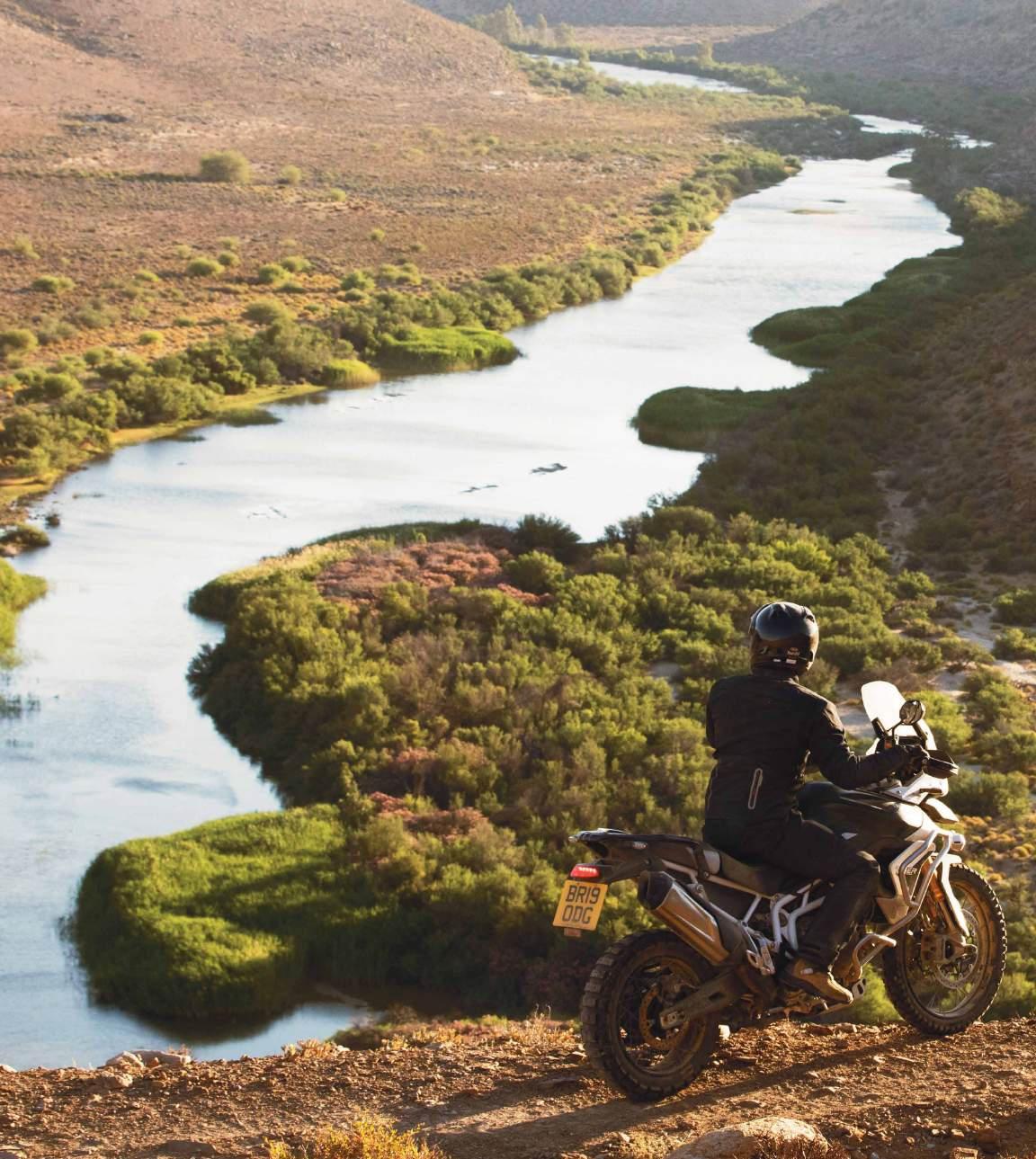







12 issues choc-full of the world’s most isolated destinations and the country’s bucket-list routes written and photographed by the people who were there. For a two-year subscription we’ll include a unique, specially designed Adventure Rider Magazine tee* worth $24.95. That’s a whopping $144.35 value for just $98! $98


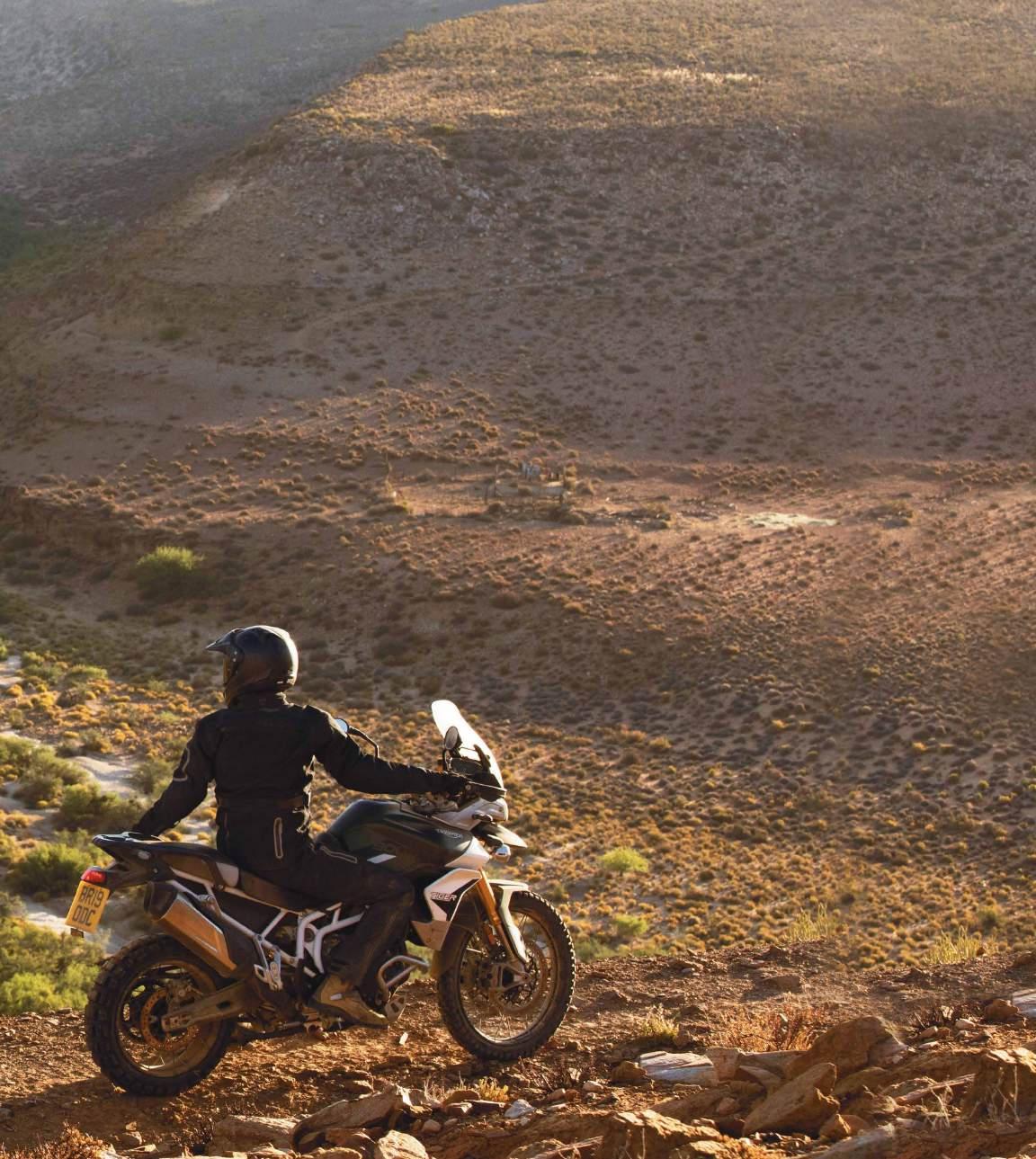
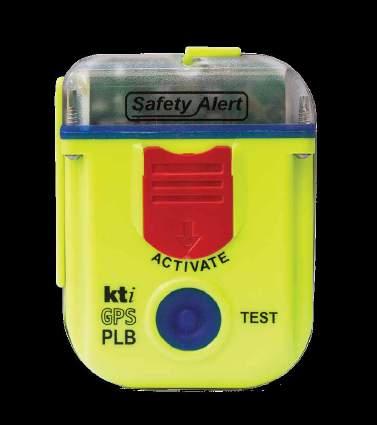
The ultimate adventureriding distress beacon that should be part of every adventure rider’s kit. Provides six independent means of rescue: 406MHZ transmission 121.5 MHZ homing signal
Whistle on lanyard Manufactured in Australia. 10-year battery life. 10-year warranty. t t t t t t
GPS location
Visual strobe
Signal mirror
Ferris

Mike Ferris won’t be taken for a ride.
We had been running our Iceland tour quite successfully for several years when early in 2014 we had an email from the United States. The rider was enquiring for 2015 and wanted to know the length of our tour, the price, the route and all sorts of details. They were all the usual questions which could be answered easily enough by reading the fully detailed itinerary on our webpage, but I politely answered all his queries. I also sent him the printer-friendly version of the detailed itinerary.
We had a few more email exchanges over the next few months and he wanted to know what would be the tour price if he brought his own bike. He lived on the east coast of the USA and was thinking of shipping his bike over to join us. I ‘did the math’ and came up with a price for him, excluding the bike hire, but keeping all our other inclusions like meals, fuel, accom and so forth. It would’ve been awkward pulling the group into a petrol station and having to say to him, “Hey, sorry, but you’re buying your own gas.”
We received another enquiry from the US at around that same time.
That was a little unusual because
Americans normally

constitute only a small percentage of our clientele in any one tour. This gentleman was named Scott, and he said he was also trying to talk a cousin into coming on the tour with him. It looked like we might’ve ended up with three Americans on the tour! However, the first guy’s response to my calculated price was a pretty flat: ‘Thanks, but no thanks’. I guessed he didn’t much like the price I offered him. I thought nothing more of it and put it out of my mind.
Scott signed on for the tour a little later, but advised his cousin wasn’t really interested, so the potential of three Statesiders turned out, in reality, to be only one.
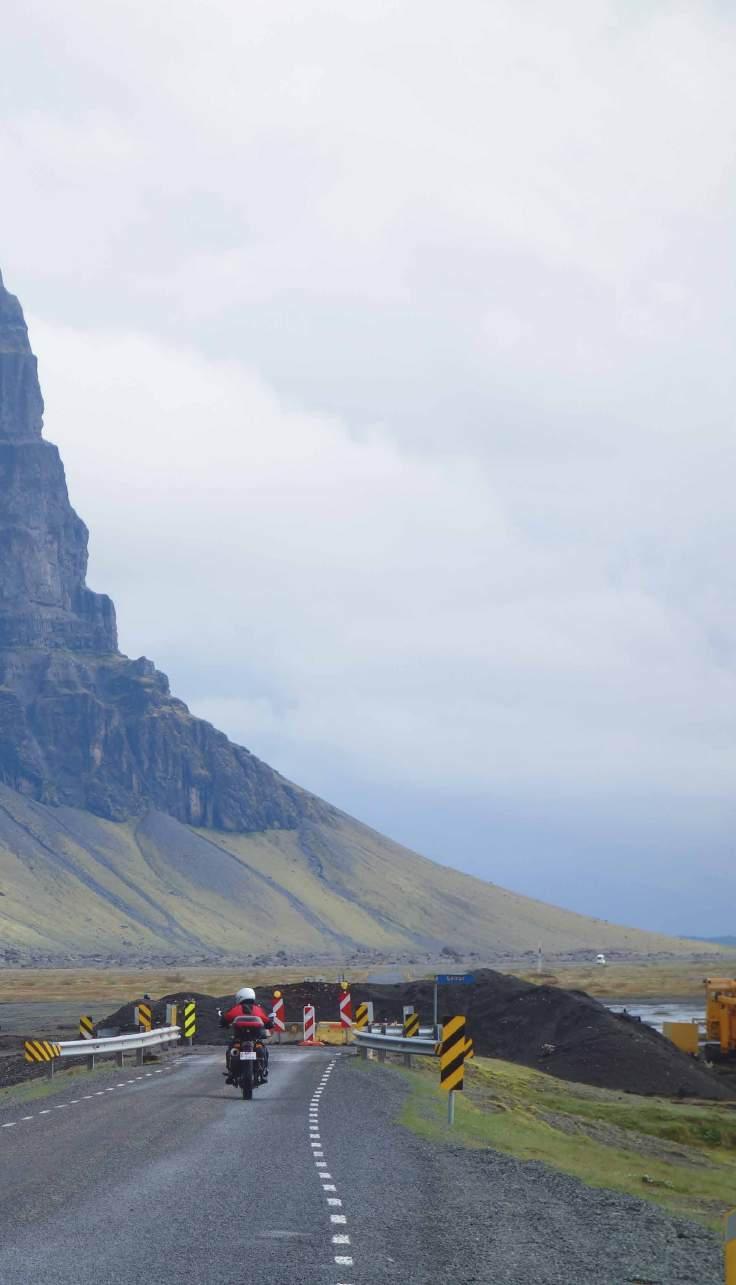
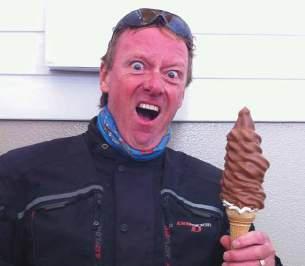
Our group of 12 subsequently met up in Reykjavik in June 2015. We spent a pleasant day taking in some of the local sights of the beautiful little capital, then proceeded with the commissioning of the motorcycles and had a short introductory ride around the city’s foreshores in preparation for the first proper riding day the following morning. A few of the riders commented on the luxury of the BMW’s heated handgrips – the air had a distinct chill, even at the height of an Icelandic summer.
We headed out the following day to the south coast, stopping briefly to take in the Seljalandsfoss waterfall before reaching our very nice hotel at the foot of the even more impressive Skogafoss waterfall. This simply stunning volume of water throws itself over a 100m cliff in thunderous display. In keeping with the wonderful, relaxed attitude of most things Icelandic, there are no safety barriers, fences or ‘Keep Out’ signs. You could literally walk right up to the base of the falls and get totally saturated if you felt so inclined. In fact, a certain tour leader has some great photos of himself sitting on his GS, parked in the middle of the riverbed at the foot of the falls, enveloped in spray. Just about anywhere else in the world that would see fluoro-clad security guards blowing whistles and barking at people to stay on the track. There was a nearby puffin colony
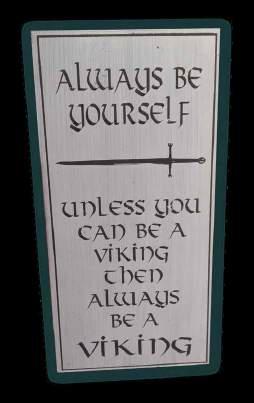
Left main: Iceland. Just incredible.
Top left: Parked in the riverbed at the foot of the falls. Left: Good advice anywhere in the world.
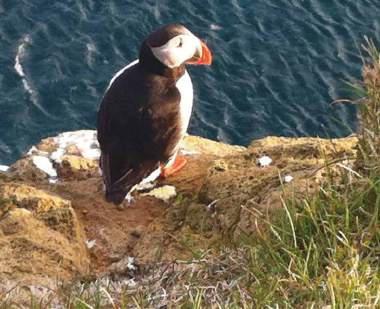
which I took people to see. These birds are hilarious. In the sea they’re amazingly acrobatic and very skilled hunters, but when they take to the sky it always looks like it’s their first time learning to fly. They have short stumpy wings which don’t seem to have enough flight feathers to support their weight, and when they come in to land they hit the deck like they’ve been tossed from a passing car.
The group then had some free time to wander and explore before we convened in the hotel restaurant for dinner and a beer or two. Most then said goodnight and turned in.
But even at 11:00pm it was still broad daylight at the Arctic Circle in June, so it took some willpower to actually climb into bed. I was in my room tapping away at my keyboard when I heard another bike pull into the hotel carpark and I wasn’t surprised to see the rider park right alongside our group. We riders are a pretty sociable bunch as a general rule.
Two or three of our chaps were still outside on the deck having a final beer, and I saw our American guy, Scott, walk over and shake hands with the newcomer. They engaged in quite a lengthy conversation which culminated in an invitation to join their table. I shut my computer and drew the blinds to keep out the midnight sun and nodded off to sleep.
The following morning we had breakfast at differing times and then met at the bikes for our 9:00am departure. The newcomer was there as well, and Scott

introduced him as ‘Joel’. I shook his hand and said, “Hi. I’m Mike”.
His motorcycle had a US plate on it. No wonder he and Scott were getting on.
He asked if it would be okay if he tagged along with us on that day as he was riding in the same direction. I had a quick think about this because I didn’t want him gatecrashing our tour, but I decided just the one day could probably do no harm and agreed he could join us.
Joel not only rode with us all day, taking in the various sightseeing sidetrips I’d developed over the past few years, he joined us at our hotel that night and sat at our dinner table. I made sure he paid for his own meal, but he was definitely beginning to outstay his welcome, especially when I saw him carrying his bags into Scott’s room a little later. Scott had paid the single-room supplement for the tour, but most hotel single rooms actually had two beds.
The guy was freeloading, big time.
It dawned on me slowly. I put two and two together and came up with a baker’s dozen.
I trawled back through my email
correspondence from 18 months earlier and found the guy who’d wanted to bring his own bike to Iceland, and guess what?
His name was Joel and he lived in the same US state as Scott.
The guy was Scott’s cousin!
I’d been well and truly set up. It was ‘buy one, get one free’.
My breakfast conversation with the two of them started something like, “So Joel, it’s pretty obvious to me you want to do our guided tour with your cousin Scott here, but you don’t want to pay our guided-tour price…”
Joel exchanged a quick glance with Scott before saying, “Well, I was kinda hoping, um, I might be able to come to an arrangement with you, ah, whereby I pay you something under the table, as it were, to keep it from your boss…”
“Excuse me?” I found myself using an Americanism.
“I wrote to that Ferris guy and told him I wanted to bring my own bike, but his price was way high. I’m hoping I can just slip you a cash incentive.”
By this stage Scott was choking on his hash brown but he managed to
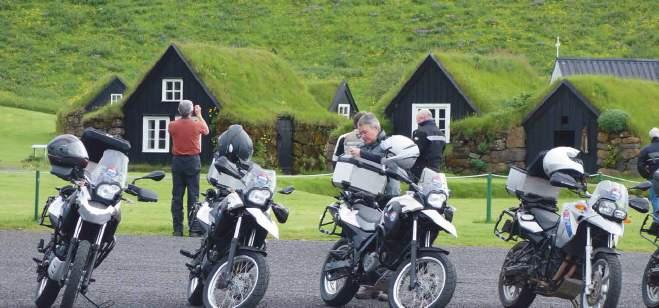

intervene, “Ah, Joel, um, this is actually Mike, um Ferris, you’re speaking with. Um.”
“Oh,” Joel blushed. “Oh crap. Okay. I’m sorry. I thought you were just the tour guide.”
“I am the tour guide,” I smiled, “and I also happen to own the company. But I’ll tell
Anyone and everyone in the travel industry is obviously doing it very tough at present with the advent of the Coronavirus pandemic. We’re all singing from the same songbook, The Covid Blues. Quite simply, leisure travel has ceased to exist for the foreseeable future.
For the next six months World On Wheels has had to cancel tours to Morocco, Iceland, the Himalaya, the Baltics, and the Dalmatian coast. We are preparing for the worst but hoping for the best. Realistically, we think the rest of this year is probably a write-off, but we’re ready to swing back into action if a miracle happens and travel restrictions are lifted – provided, of course, we are confident the relevant destination is safe.
you what, now you’re here, let me look again at a special price for you. Seeing as how it’s now cash…”
Within half an hour I came back to him with a ‘cash’ offer. He blinked twice, smiled a sarcastic smile, and declined. So I told him he was no longer welcome
Our clients have been very loyal and understanding. We have offered refunds but over 90 per cent have told us to hold their deposits over until their deferred tour can be run, whenever that may be. If the re-scheduled tour date does not suit, then obviously we will honour a full refund.
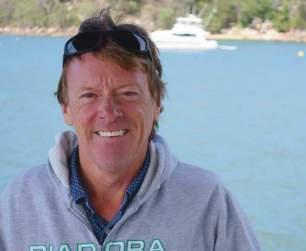
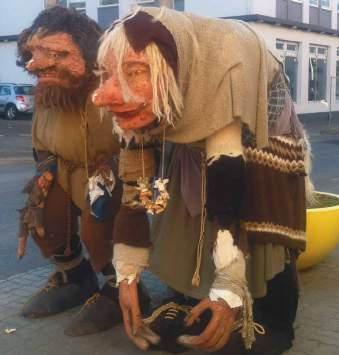
to ride with us.
Rather predictably, he blustered, “You can’t stop me riding where I want to ride.”
I’d anticipated such a response, and rather than escalate to a possible confrontation, I just shifted my gaze to Scott. He picked up on the cue immediately, and said, “Hey Joel, you know what? Maybe it’s better I just catch up with you back in Reykjavik in 10 days or so.”
When our group stopped for gas on the way out of town a short while later, Joel didn’t. We didn’t see him again for the rest of the tour, but when we arrived back in Reykjavik there was a familiar bike with a US plate parked at our hotel. Joel had obviously obtained from his cousin the list of hotels we were using on the tour. I’m prepared to bet he didn’t pay for a room that night.
Really, some people do try it on.

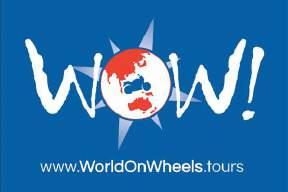
Inspiring Iceland is one of the tours in the World On Wheels portfolio. Check out the website at: www.WorldOnWheels.tours

Not being able to ride shouldn’t mean no focus on riding. Miles shares a few thoughts on staying in touch when getting time on a bike can be difficult.


For many it’s a default response (aka: excuse): “If only I had time I would...”
With the COVID-19 lockdowns, many people actually have some free time on their hands, but the frustrating thing is, they can’t use the time to do what they really want to do – go riding with mates. Rather than being frustrated, it could be an opportunity. Tweaking the thought processes can see the time used to achieve things that would probably left undone under normal circumstances.
Back in my downhill mountainbike racing days I did get the odd injury, which is really tough to take when you’re 110% focused on racing. Somehow you have to focus all that frustrated energy into, “Okay, this is my current predicament. How can I make the most of it?”. It’s not always easy, but it’s very liberating to turn a negative mindset into a positive one and give it
Left: Not being able or allowed to ride can mean time to plan big adventures well. It doesn’t get much bigger than the Finke Desert Race. Above: Back in the downhill mountainbike racing days.
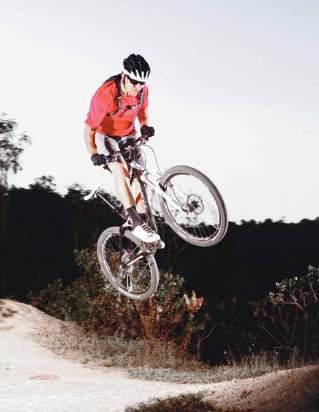
everything you’ve got. As we always hear, the brain is very powerful. You just need to be able to harness it.
One injury was a fractured Olecranon (a shattered elbow). My funnybone ended halfway up my tricep after a preseason testing crash with Rockshox in Santa Cruz, California. So instead of jetting to Europe for the first World Cup races I was back home enduring an operation and facing up to three months rehab. With the guidance of a doctor – who was a coach

at my local club – I went under the knife. The surgeon was the guy who looked after NRL players’ arms, so he knew what he was doing.
Then came rehab, which consisted of physio, massage and acupuncture on a pretty regular rotation.
The first thing I needed to know was when I could get back on my bike to keep training. I started with a stationary bike, then a mountain bike on the bike path, then some light mountain biking and so on. With the time I had I could focus on all of the rehab and training, with the goal of making it back to racing ASAP.
Right: It doesn’t take much space to practice some riding basics. A backyard will do for some drills. u

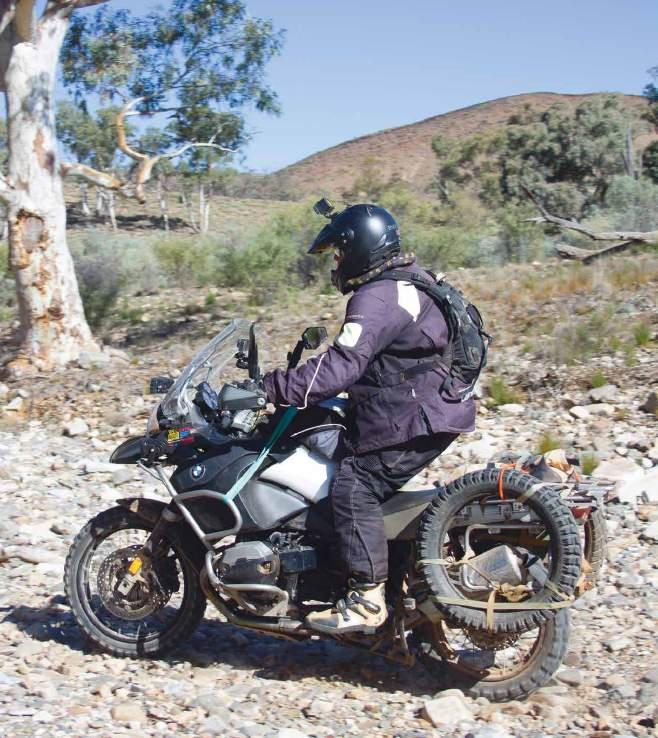
In six or seven weeks after the surgery I’d regained most of my range of motion in the arm and had managed to stay fit and strong during the rehab process. It was a bit early, but I decided to return to racing and made my way to a US National race in Georgia.
It was great to be back, but I was a little nervous to be racing in less than half the time the surgeon suggested.
I ended up fifth, which was a huge relief and a great way to return, but I think the biggest satisfaction was to think back to how the situation could be turned from a massive negative to a positive, and know I’d done my best. The solid result was really just the icing on the cake.
Maybe you can use the same postive mindset and try to treat the current situation the same way. It could be a positive if you thought about it from the right angle.
These things may be running through
Above: The more organised you are, the more prepared you are.
Right: Times where we can’t ride needn’t be totally lost as downtime.
Far right: Work on the bike. Change oil, check spokes, remove suspension and have it serviced.
your mind…
v ‘Can’t go on the adventure ride that I had planned’
v ‘Can’t attend the training event I was booked into’
v ‘Can’t go riding with my mates’.
The idea is to stop those things filling your head. Try getting your mind to focus on the things, thanks to having some time, you now can do. They might include:
v ‘I can walk, run and get out for some basic exercise’
v ‘I can ride a bicycle (mountainbike, road bike, commuter bike) as a substitute to my moto. I still get to ride, steer, pick lines, use brakes, but I also get some

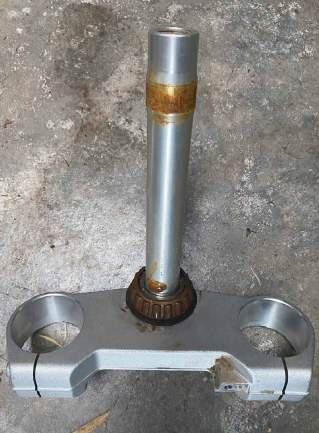
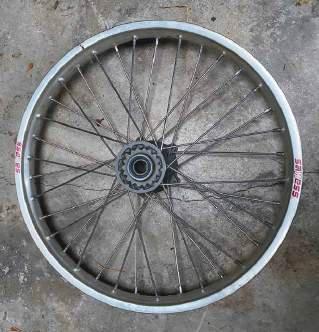

exercise that maybe, I normally wouldn’t.’ (If you do normally ride a bicycle, you can work on new skills –from practicing balance exercises and bunny hops through to wheelies and stoppies)
v ‘I can work on fitness – maybe gym, body weight exercises, flexibilty or yoga.’
And if the physical tuning doesn’t appeal to you, start thinking about how the current situation is a great opportunity to take care of some other bike-related things which have been let slide.
Start thinking about how you could:
v Work on your bike. Change oil, check spokes, remove suspension and have it serviced
v Wash and rewaterproof your riding gear
v Research those accessories you’ve been thinking about and order them online
v Get on the computer and learn more about route planning or GPS – if you prefer, order some maps and do it the old-fashioned way.
This time we have available can be used to plan an adventure, and depending on the ride there can be a heap of planning needed.
I remember when I decided to race Finke on the 1200GS a couple of years ago. I had to make a bloody long list and work through it as efficiently as possible as time really wasn’t on my side back then. List headings included: Plan Recce; Bike Prep; Riding Gear; Race Entry; Event Support; Spares; Tyres; Logistics; Tech Support; Race License; Route To Alice and more. It was pretty full on, and there are always so many things that crop up as the plans develop –things which couldn’t have been forseen at the beginning.
The more organised you are, the more prepared you are.
This can be so important for an adventure ride. For many people poor preparation can mean a ride is compromised before it even gets going. Do research and seek advice on the topics where you’re feeling unsure of your ground.
Avoid leaving things to the last minute. You have time now. Use it.
I remember at the beginning of the Finke project I spoke to Stephen Greenfield and Michael Vroom (both past winners). Both thought I was crazy, but could tell I was approaching the challenge with a lot of thought and respect. They both provided advice and support and were stoked when they heard I’d finished.
We love riding, we accept the risks, and some challenge themselves more than others. Having a positive attitude towards our riding, preparation, riding development and the situations we get into can go a long way towards more enjoyable riding and better outcomes when challenged.
Hopefully by the time you’re reading this you’re able to get out on your bikes to explore and enjoy. But times where we can’t ride needn’t be totally lost as downtime.


Andy’s in the here and now.

Thinking back to our grandparents’ days, each and every ride was what we’d haughtily call an adventure ride. Riding would be done on unsealed roads, often in serious need of love and attention. Bikes had a largish front wheel, tyres had tread and ’bars were wide for that extra bit of leverage and control.
In the days when automobiles cracked on at 40MPH, Laurie of Arabia would scream past on his Brough-Superior at ‘the ton’, often getting a bit of ‘air’, scaring the bejeazaz out of ’em. No wonder his passion killed him.
Movin’ on
Aircooled singles and twins were the go, and the riding position was distinctly upright. Those tough buggers rode in the most rudimentary clobber, often army surplus, almost never designed for the task. Newspaper was a legitimate mid-layer clothing item in winter, and if you were lucky yer gran would have knitted you a long scarf. Melon protection might be a leather skull cap to keep the cold at bay until someone fashioned a large wine cork into a rudimentary brain bucket.
Tales of early ‘Big Laps’ or Nullabor crossings are punctuated with grit (in every crease), lateral thought and ingenuity. Think back. Motor-bicycles were the poor-person’s
transport, not so much toys for the rich (in world terms, at least). Suspension, well, it lacked the suspending bits we are spoilt with these days. Standing up was what blokes did for a damsel’s honour or at the bar.
What’s more, the adventure was often compounded by the reliability (or lack of) in the bikes they rode. Fettling machines on the side of the road was part of the riding experience, and an engine throwing a leg out of bed or dumping a valve was all part of the adventure. If you couldn’t rebuild a donk with a shifter and hammer you weren’t roaming too far or wide in them days.
Larger-capacity bikes transitioned away from the dirty stuff until some bright spark came up with the idea of a ‘Dual Sport’ jigger. In the scheme of things, they were still pretty basic, but the idea of exploring a bit more widely sank home. The sort of bike Aussie riders always should have been riding began to emerge. Legendary names such as Africa Twin, Ténéré, GS and V-Strom gathered momentum.
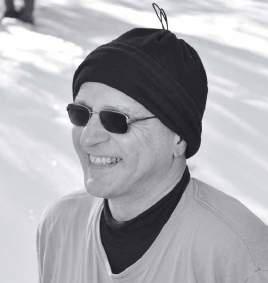
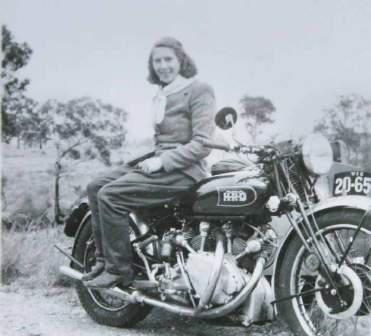
How spoilt (and maybe a touch arrogant) are we now?
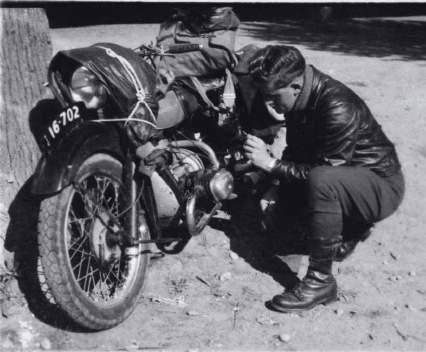
Purpose-made, space-age protective gear wraps us decadent, cappuccinoswilling, craft-beer quaffing, avocado-smashing ‘adventure riders’. Our machines, with more technology than an early space shuttle, are safer and more controllable than ever before. These ARE ‘The Golden Years’. Never lose sight of it!

Far left: Every ride was an adventure ride in our grandparents’ day. Top left: Those tough buggers rode in the most rudimentary clobber, often army surplus. Above: Riding would be done on unsealed roads, often in serious need of love and attention. Left: Fettling the machine on the side of the road was part of the riding experience.
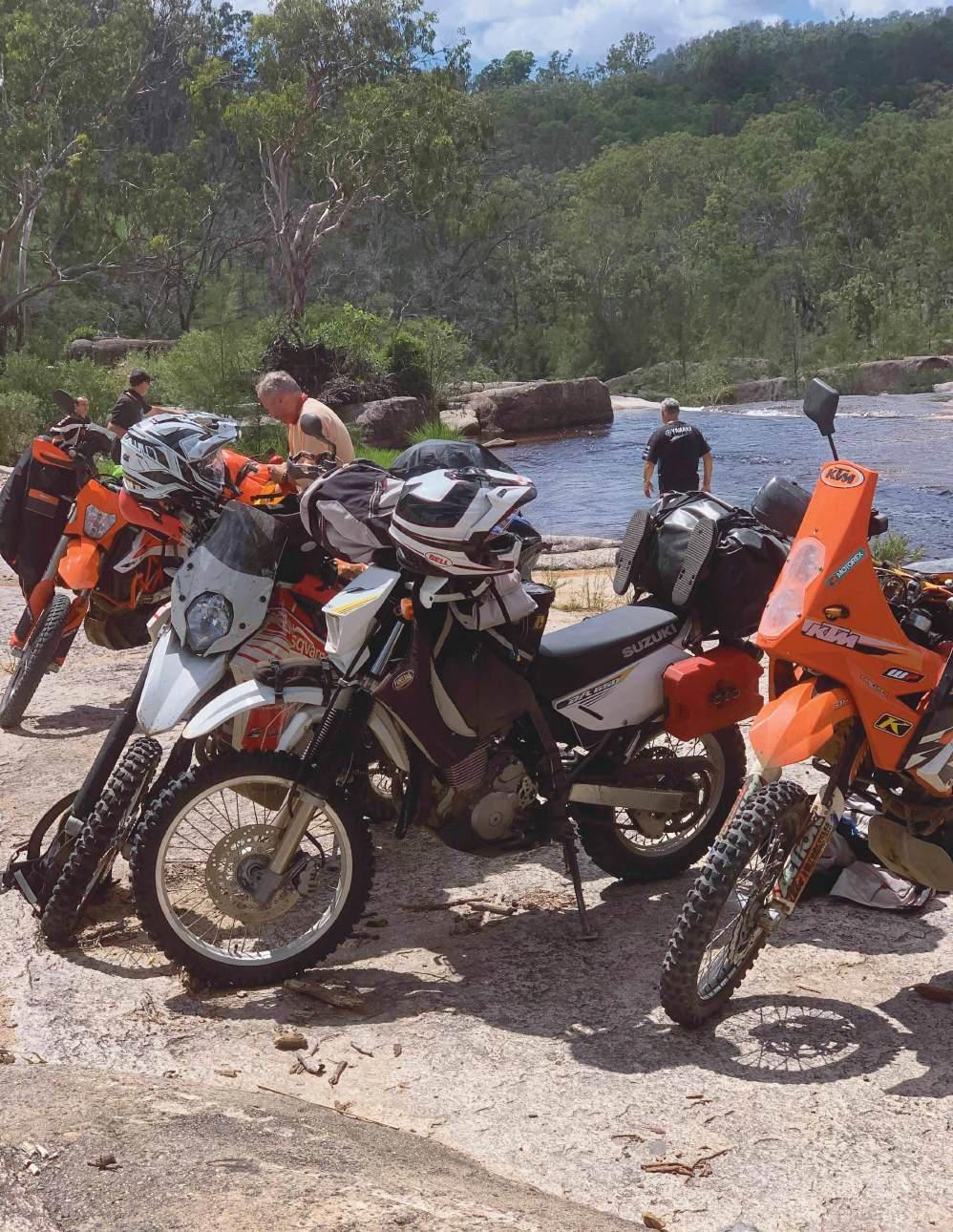
Karen’s explosive experience.
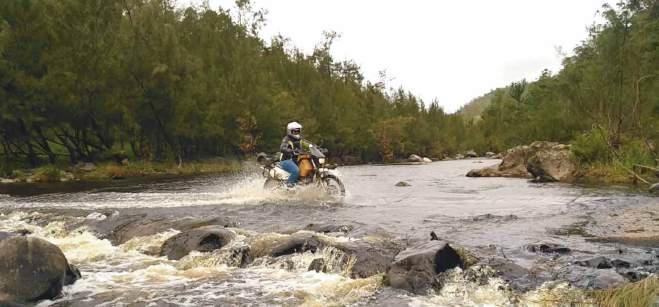
It took a moment to realise exactly what the white stuff was that was falling from the sky. It was toilet paper.
What made the event even more remarkable was that it occurred during the great toilet-paper shortage.
But I’m getting ahead of myself. Let’s go back to the beginning.
Once, long ago, in the time before selfisolation, people were free to ride wherever they wanted (provided the State forest or national park they were planning to ride in wasn’t still closed), whenever they wanted (as long as they wore a helmet and had current rego), for as long as they wanted (if they could get the time off work). It was during that time a hard-core enduro was scheduled for Tenterfield in NSW. One evening, after cooking a delicious meal for his appreciative wife, a man, who we’ll call ‘Dave’, stumbled across a flyer for this enduro. Dave was widely known across his loungeroom and on one or two socialmedia pages as a sleeveless bloke who loved nothing more than getting people together for rides and camping. Some even referred to him as The Human GPS.
“I reckon we could do a ride to this event,” Dave enthused.
“Yes dear,” replied his wife as she always did when he started to plan a ride, not looking up from her work (she knew that shortly that comment would be followed with road names, distances, fuel stops and all manner of planning).
The ride planning got underway. Dave and his wife went for recce rides trying possible routes (no pun intended). They organised a camp spot and firewood. Excitement grew. With all of the hugely devastating fires across the country either out or under control, and widespread rain in a lot of places easing drought conditions too, people were keen to get away for a weekend and admire the skills of some seriously talented riders.
As the event got closer, strange things started to happen across the country. News of a deadly virus, closed borders and lockdowns filtered through. At the first reports of local toilet-paper hoarding,

many people were sceptical.
“Surely not?”
“Fake news.”
“Why?”
Then they went to the supermarket and saw for themselves that it was true. Normally rational people would shake their heads at this behavior before walking out of the shop with a 24-pack of loo paper and five kilos of rice.
It was around this time the ‘preppers’ could be spotted.
They were the ones who would just stand at the end of the toilet-paper and tinned-food aisles without needing to run that particular gauntlet. They were the ones wearing utility belts complete with can openers, smiling and nodding to

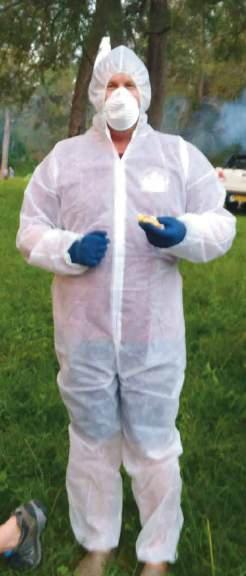
themselves and as they passed other shoppers, hissing under their breath: “I told you so”.
Best intentions
It was at around this time an announcement came from the organisers of the enduro. They were unable to source toilet paper for the event so visitors were requested to BYO. Dave, still with a sense of amusement at this stage, passed on the message. Most riders already had a stash they kept with their bikes for emergencies, but they all threw in some extra just in case, because adventure riders are a prepared and adaptable bunch of folks.
During the week of the ride, Dave’s daughter Tinonee and her partner Jamie moved to New Zealand for a working holiday. They were prepared for two weeks of selfisolation. As it turned out, they just made it into the country before the borders were closed. Meanwhile, Dave’s other daughter, Bessy, and her partner Sam, were being kicked out of Tassie, with their ‘big lap’ over before they were barely a month into it.
The evening before the ride, Dave and his wife had some of the riders stay over at their place. This meant people who would otherwise have a long distance to travel to the


meeting point could have a sleep in. The trade-off, however, was generally a late night. There was lots of talk about this Coronavirus spreading across the world, but as the night deepened, the solutions were laid out on the table, discussed, ratified and ready for action. Unfortunately, no one could remember any of it in the morning, so the politicians just had to bumble through on their own.
It was one of those perfect-weather days when the 18 riders met at the start. It wouldn’t have been surprising to see little blue wrens flitting around everyone’s helmets. A lot of events had conspired against those riders, but adventure riders are a determined bunch. Many tracks were closed, either from fires or due to damage from local rain, so Dave had to be a bit creative with the route.
The day was set to be around 350km, so there were even rumours it might be the first time Dave would succeed in achieving the four o’clock rule, though no-one has been able to verify that claim.
As it was, they didn’t. And that was due to a couple of key events.

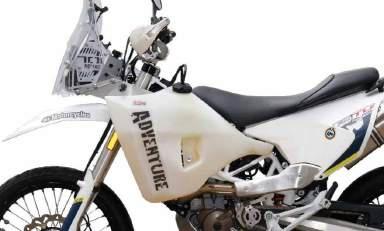

First up was a supposedly mossy section of track under some powerlines.
Dave thought it would be a nice break from the tar and he’d gone out the weekend before with a chainsaw to clear the last of the trees from across the track. While he was riding very responsibly and sedately – at around 40kph – at the front of the group (according to him) the front wheel slipped out on some moss and he slammed into the ground. He was apparently very sheepish when his wife, who was sweeping (this is a bike term, not literally sweeping with a broom like good wives do), arrived on the scene. Despite good boots his foot was very sore but, of course, there was no way he was going to stop in at a hospital.
The group continued until it came to a river crossing. Ignoring the advice from his wife to go around, Dave went through the crossing. He was very lucky to have a very fast man named Macca come running into the water to help him up when the bike went over. By now he’d realised his ribs were sore too, but hospital was out of the question. After a couple of pain killers and a few exasperated words from his wife he was on his way again.
The other key event was far more spectacular.
People who were there claimed they had never seen such a thing before, while others said it was something they had only ever heard about but had never actually known someone who it had happened to.
You’ll remember riders had been asked to pack extra toilet paper. Well, one of these riders, let’s call him Nick to protect his identity, had his stash secure in his pannier bag along with his two-minute noodle lunch. The group was travelling along nicely when they came across some roadworks. A few of the riders missed the lights and had to wait. According to some of the people who were there, it was all happy and friendly with no hint of the incident that was about to occur.
Top right: A bit perplexed.
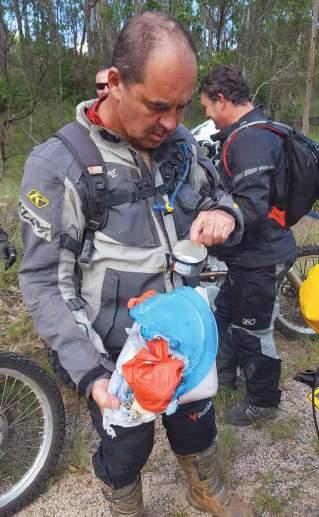


What happened next is a bit sketchy, but just as Nick was level with the traffic waiting at the other end there was a loud explosion and toilet paper started raining from the sky. Some accounts say the people jumped out of their cars and scrabbled to pick up the loo paper, but that’s never been verified. Neither have the reports of people falling to their knees and praising the incident as a miracle.
Nick stopped up the road a little way, unsure of what had happened. All was revealed when he was off the bike and saw his tattered, brand-new pannier, fused plastic, bits of noodles and the remains of a gas canister. His bike had a short exhaust pipe and when he’d retightened the straps after the morning-tea stop, he’d pulled it in such a way that the pannier, and in particular the gas canister, was partially over the exhaust opening. The explosion not only blew apart the pannier and melted plastic items together, it also bent his pannier racks in.
The disbelief at this freak event felt by those there quickly gave way to expressions of how lucky it was: lucky he wasn’t carrying fuel; lucky it was on the left-hand side and didn’t explode into one of the cars; and lucky it didn’t explode into his leg. Then came more practical considerations: it was a good thing he wasn’t carrying the grog; hope the warranty on the panniers covers this; and who has a spare strap to carry what’s left of his gear?
It turned into an important lesson for everyone concerned. Not only don’t store flammable materials near hot components on a bike, but keep your valuables safe.

R The spirit of adventure riders is unbreakable
R Hard enduro riders are either super crazy or super talented
R Preppers may have a point
R If you don’t get an X-ray you can pretend it’s not broken
R Always store your loo paper in a safe place What
New, US-built DR650 dash to suit from 1996 to the current model.
R Designed to power multiple electronic devices
R Can also be used for accessory lights, heated grips or gear
R Two pre-drilled holes to attach a RAM mount
R Manufactured from laser-cut, 5/64” mild steel and powder coated black.
R Included are two weather-resistant green LED rocker switches, a voltmeter with two 4.2-amp, weatherresistant USB ports, a wiring harness with a built-in 10-amp fuse/ holder, and complete instructions
R Everything needed to mount it and connect the outlets to the battery are included
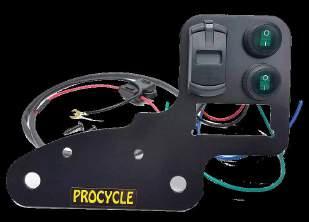
RRP: Special intro price – $129.95 plus postage
Available from: Adventure Bike Australia
Web: adventurebikeaustralia.com.au
Hand MIG-welded. It’s all about the strength.
R 22mm steel tube with two-millimetre wall thickness
R Preserves the low centre of gravity
R Tough mounting points
R Precision laser-cut pieces
R Four-millimetre and five-millimetre thick metal mounts
R Powder coated red, blue, black or silver
RRP: $385

Dual
Ideal for 40/60 on-road/off-road.
R E804 front
R E805 rear
R DOT approved
R Four-ply rated
R Available in sizes to fit most adventure bikes
R Five front-specific fitments, eight rearspecific fitments available
R Four radialconstruction fitments
R Find your closest dealer at www.shinkotyres.com.au
RRP: From $112 to $240
Available from: All good motorcycle dealers Web: shinkotyres.com.au

Hook the charger up to the battery to give two USB charging ports and a voltmeter.
R Unit has an on/off switch. When not riding, turn the unit off to not drain the battery
R Supplied with a one-metre SAE-to-SAE lead and a mirror mount
R Charger outputs a total of 5V/4.8A to two USB ports
R When the adapter is plugged in and powered on it will display the battery voltage
R USB charging ports supply enough power to charge a phone, tablet and GPS
RRP: $39.95 plus postage and handling
Available from: Rocky Creek Designs and all good motor cycle stores through Pro Accessories Web: rockycreekdesigns.com.au
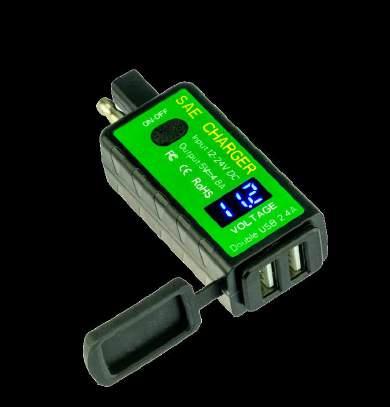
Available in mens’ sizes
S – 8XL and ladies’ sizes
XXS – 4XL in four colours.
R Maxtex polyester 600D outer shell with 1000D on shoulders and elbows
R Texland Reissa waterproof and breathable membrane (8000mm/7000mm)

R Detachable 100g insulated thermal liner
R CE armour with highdensity foam back pad
R Safety stitching ventilation system
R Dual rain gusset on main zip
R Soft collar with neoprene edge
R Waist connection zip for pants
RRP: $279.95
Available from:

Your local motorcycle dealer Dealer enquiries phone: McLeod Accessories 1300 300 191
Greater comfort and better control on a BMW.
R Increase handlebar height by 35mm
R Bring the handlebars 20mm closer to the rider

R Greater ergonomics for taller riders
R Sportier riding style
R Available for R1250GS, R1250GSA, R1200GS, and R1200GSA
RRP: From $240.99
Available from: www.shop.touratech.com.au
Web: touratech.com.au

Keep feet warm and dry during colder rides.
R Moisture-wicking design
R Merino and synthetic blend of materials
R Anatomically shaped footbed
R Long sock for all-day comfort in motorcycle boots
RRP: $69.99
Available from: REV’IT! Australia
Web: revitaustralia.com.au

An adventure/enduro glove.
R Hard-plastic knuckle protection
R Ball of thumb underlaid with shock-absorbing foam
R Nyspan and microfibre back
R Goatskin palm
R Colourfast and sweatproof
R Unlined palm
R Air-vents on fingers
R Visor wiper
RRP: $145
Email: sales@mig.bike
Phone: 1300 916 916
Web: heldaustralia.com.au

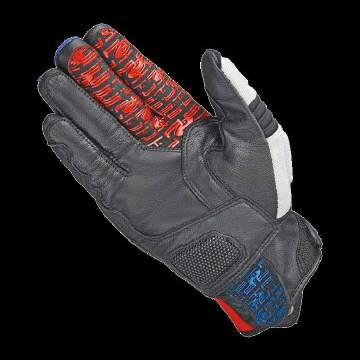


Optimum insulation and protection on long or short-haul winter outings.
R Dual cuff closure and strategically reinforced areas
R Goretex waterproof and breathable membrane
R Stretch polyamide upper construction with goatskin-leather palm
R 100gm/sqm Thinsulate thermal insulation on the backhand
R Thumb and palm reinforcement
R Available in Men’s sizes S – 3XL
RRP: $199.95
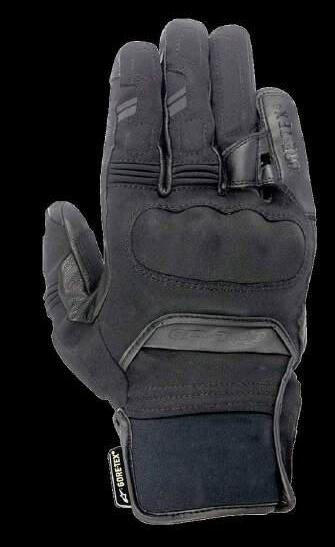
Available from: All motorcycle stores Web: monzaimports.com.au
The real difference is in the way a Scorpion feels.
R Excellent performance, sound and look
R Handcrafted in the United Kingdom
R Serket parallel-silencer style
R +1.6hp over the standard exhaust
R Available in titanium (SCERHA173TEO) and stainless steel (SCERHA173SEO)
R 2.18kg (titanium) and 1.68kg (stainless steel) lighter than standard
RRP: $849
Available from: Any Scorpion motorcycle dealer and whitesmoto.com.au
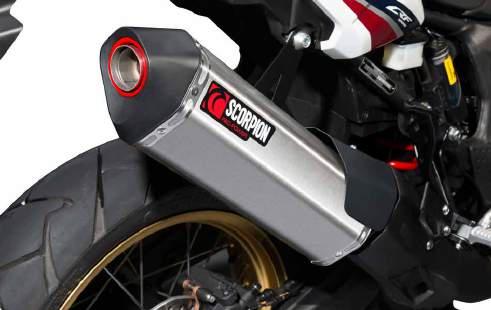
A tankbag made to fit in the small gap available on a longrange fueltank
R Doesn’t get in the way
R Stable
R Easily accessed
R Raincover tucks up under the bag
R Harness strap runs under the seat
R Made in Australia by Andy Strapz
RRP: $255 plus freight
Available from: Andy Strapz
Phone: (03) 9786 3445
Email: info@andystrapz.com
Web: andystrapz.com

Ideal for riding 365 days a year.
R Force-Tech removable protectors
R Waterproof, windproof and breathable H2Out garment
R Three jackets in one: outer layer, H2Out membrane and quilted lining
R Resealable vented panels
R Detachable groin strap
R Extreme abrasion resistance
R Reflex zones for nightriding
R High-tenacity polyester fabric

RRP: $829.95
Available from: Moto National Accessories Web: motonational.com.au
Designed to do multiday enduro events on one set of tyres.
R Suited to 50/50 dry/wet. 50/50 hard/soft
R Heavy-duty endurotuned construction
R Motocross-like grip
R Developed for dualsport and trail use in varied terrain
R Excel on steep hill climbs and tight, twisting, single trails
R Proven reliability
R DOT and ECER75 homologated
RRP: $89.95 – $129.95
Available from:
Your local JTR Dealer www.jtr.com.au/dealers Web: jtr.com.au

hePco & becker yaMaha ténéré 700 centrestanD
A rugged centrestand for the new Yamaha.
R Easy to use
R Made in Germany with quality German steel tubing
R Anti-skid tread for easy and secure standing
R Black powder-coated finish
R Easy assembly
R Many other Ténéré 700 parts now in stock
RRP: $369
Available from: Motorcycle Adventure Products Web: motorcycleadventure.com.au
Plenty to choose from.
R Capacities from two litres to 70 litres
R Made from durable, 500D polyester with welded edges
R Roll closure to keep gear protected from the elements
R Bags can be connected to each other.
RRP: $54 – $249
Available from: Motorrad Garage Web: motorradgarage.com.au

A glove ready for a tough winter.
R Taslan leather detailed back outer shell
R Goatskin palm
R 3M Thinsulate lining
R Gore-tex membrane
R SAS-TEC knuckle protection
R Available in black-white or black-fluorescent yellow

R Sizes 7 – 13
R 5 year warranty

RRP: $290. On sale for $200
Email: sales@mig.bike Phone: 1300 916 916 Web: heldaustralia.com.au

MotorraD garage tyre rePair kit
A comprehensive motorcycle tyre repair kit.
R For repair of tubed and tubeless tyres
R Includes patches, glue, tubeless-repair cords, CO2 canisters and regulator, and even some instructions
R Packed into a compact nylon carry bag
RRP: $39.95
Available from:
Motorrad Garage Web: motorradgarage.com.au

An array of precision-engineered hand guards.
R Designed and made in Australia
R Kits are interchangeable with Barkbusters’ modular range of plastics
R Compatible with JET, VPS, STORM and CARBON guards
R Unrivalled impact and weather protection
R For availability search ‘where to buy’ at www.barkbusters.net
RRP: $124.90 – $129.90
Available from: Motorcycle dealers Web: barkbusters.net

rk racing chain 525gxw chain
Gold plates with natural-finish chain rollers and pins.
R Made in Japan
R Suited for off-road motorcycles up to 800cc
R Enhance acceleration and reduce horsepowerdrag losses
R High-tensile strength
R XW-ring features quad lubrication pools and six contact seal points
R Outstanding wear life compared to standard or basic O-ring chains
R Each chain pack is supplied with a rivet-type joining link
R There is no clip-type joining link available for this chain
RRP: $259
Available from: All leading motorcycle dealerships Web: linkint.com.au

A multifunctional glove with twin-chamber technology.
R Switch chambers when weather conditions change
R PROOF moistureprotection chamber is breathable, windproof and waterproof, with a lining for thermal insulation
R GRIP chamber features wafer-thin, abrasion-resistant kangaroo leather
R Crease-free, tactile fit
RRP: $300
Available from: Your local BMW Motorrad dealer Web: bmw-motorrad.com.au/dealers
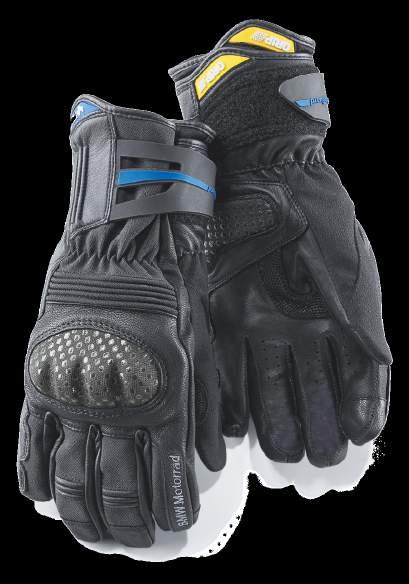
raD guarD ktM 690 enDuro r 2019-20 raDiator guarD
An essential aftermarket part.
R For the hardcore adventure rider
R Easy to fit
R Video fitting instructions available
R Lightweight and doesn’t restrict air flow
R Made from 6060 T1 – T5 aluminium
R Available in black, polished alloy and orange
R Three-year worldwide warranty
R Australian made
RRP: $228. On special for $179
Available from: Rad Guard Phone: (02) 6658 0060 Web: radguard.com.au

Completely redesigned for 2020 to fit virtually any bike.
R 1.5-litre volume
R 17.8cm x 10cm x 10cm
R Keeps essentials handy
R Mounts behind fuel cap for easy fueling
R Waterproof clear top fits a smart phone
R Power cable pass-through
R Tankbag unzips from harness
R No buckles in knees or crotch
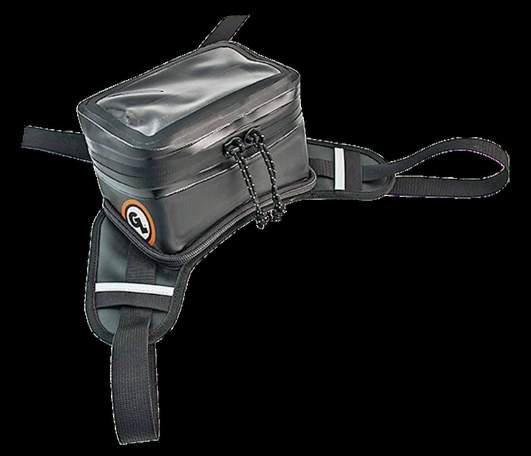
Half the neck tube is equipped with Windbarrier® which allows wearing it in different ways.
R Half Windbarrier fleece and half polyester jersey fabric
R Windbarrier fabric is 100-per-cent windproof and water repellent
R Lightweight and packable into pockets with minimal bulk
R Sizes S to L
RRP: $69.99
Available from: REV’IT! Australia Web: revitaustralia.com.au
A high-spec jacket and pants for adventure riding or touring.
R CH3532 and nylon outer shell with 1000D reinforcement
R CE armour in shoulders, elbows and knees
R Waterproof and breathable liner (15,000mm/ 10,000mm)
R Removable 100g thermal liner
R Detachable allweather collar on jacket
R Air-Ventilation System (AVS) for cooling


R Multipanel mesh comfort lining
R Stretch comfort panels
RRP: $185 Available from: AdventureMoto Web: adventuremoto.com.au
RRP: Jacket $499.95. Pants $369.95
Available from: All good motorcycle retailers Web: cassons.com.au


Honda’s Africa Twin just keeps on giving. After all these years it’s still an awesome adventure bike. But it can be even better with some aftermarket equipment from Touratech. Check out this lot for the CRF1100.

